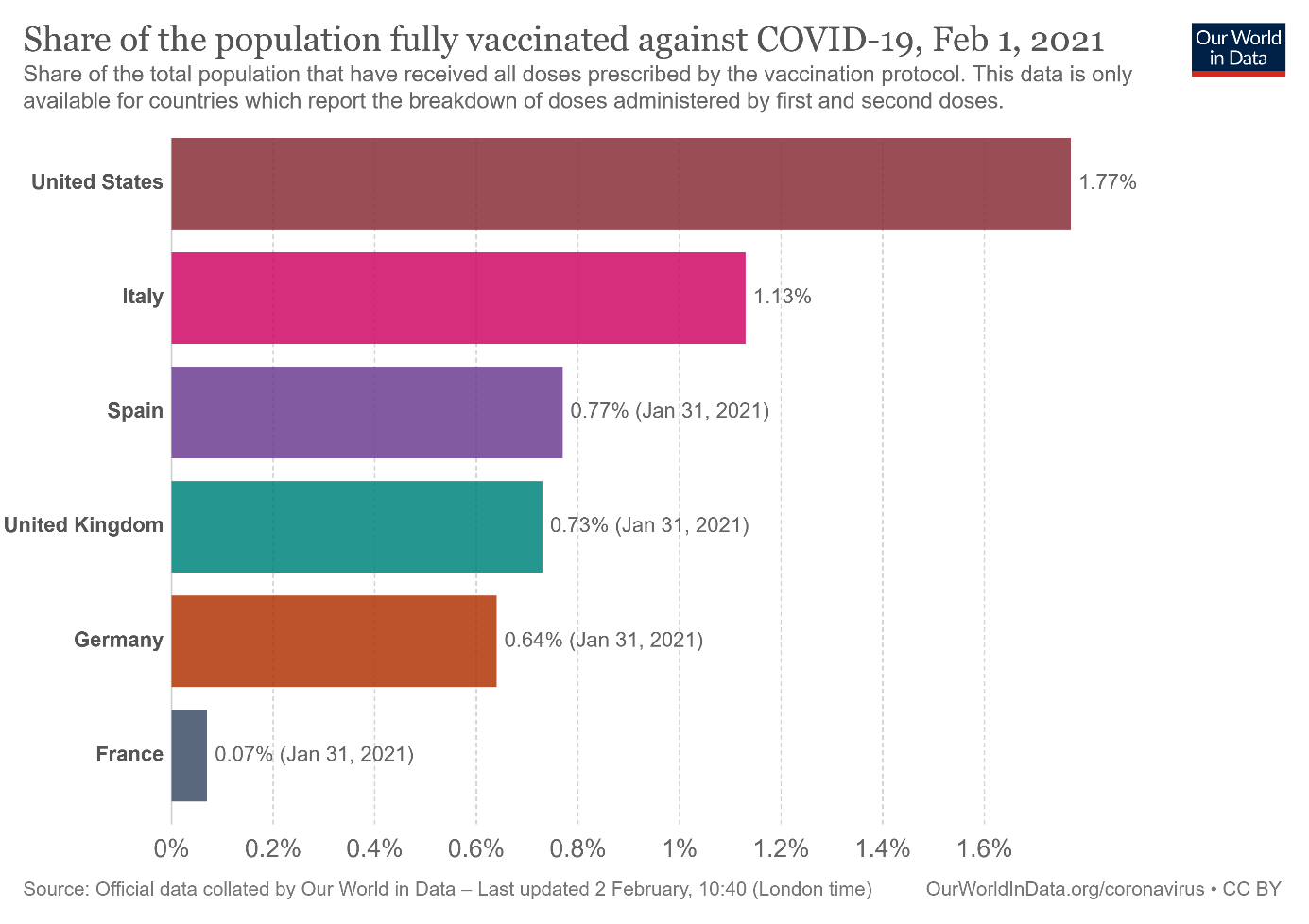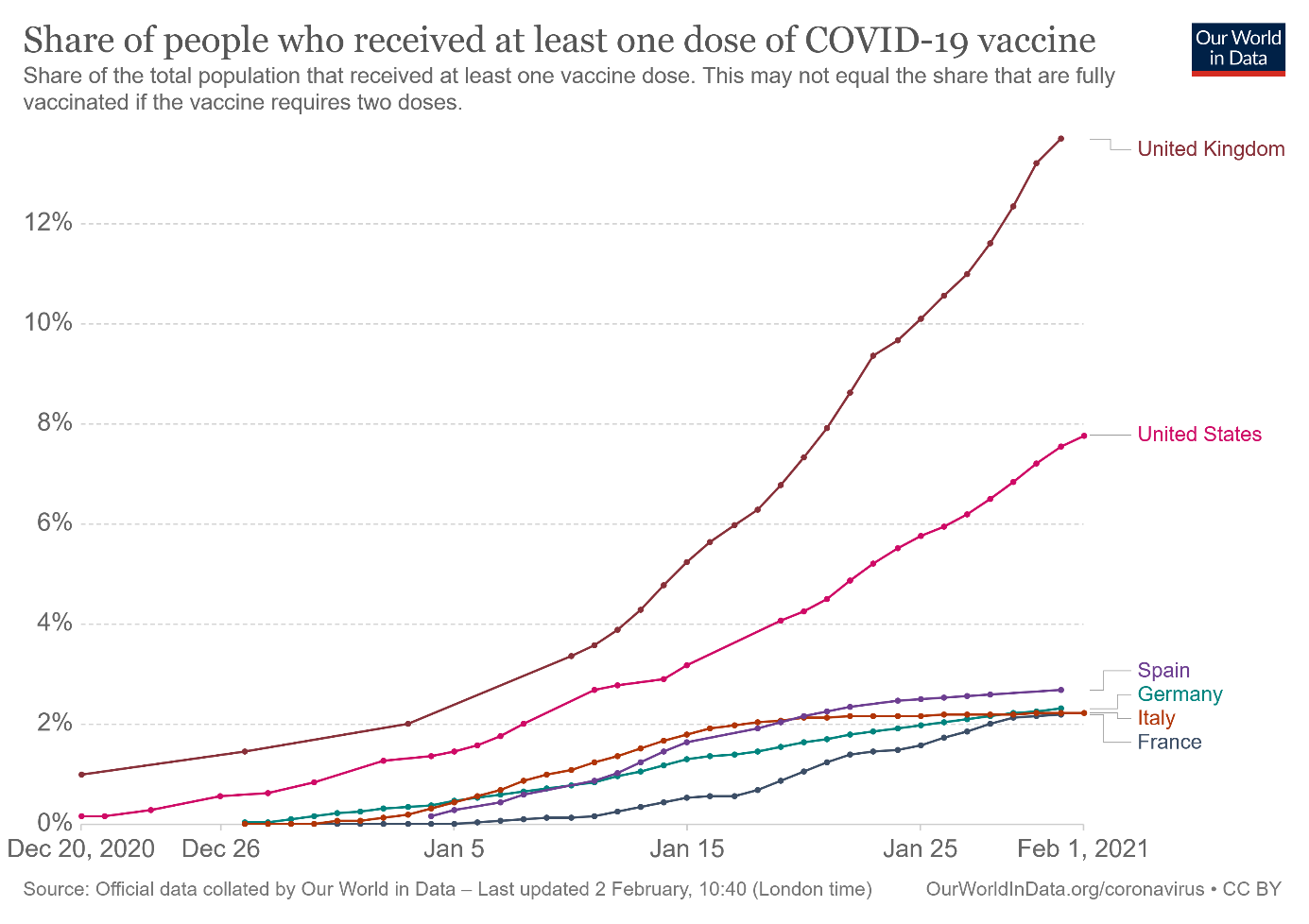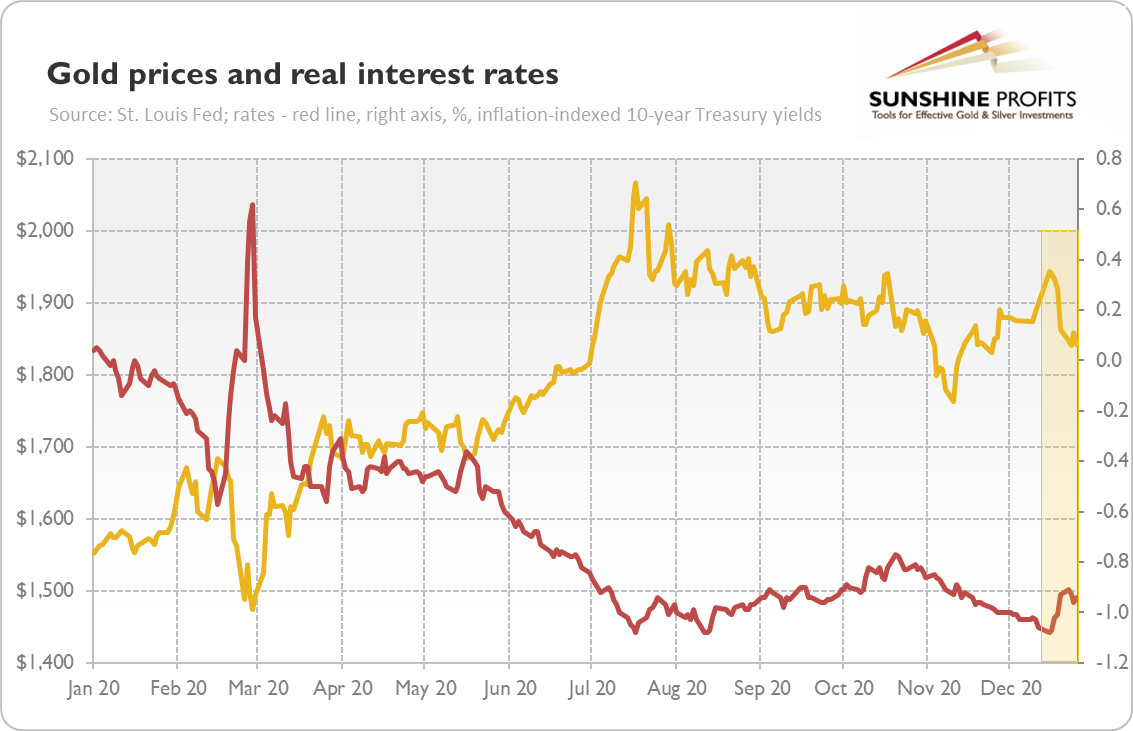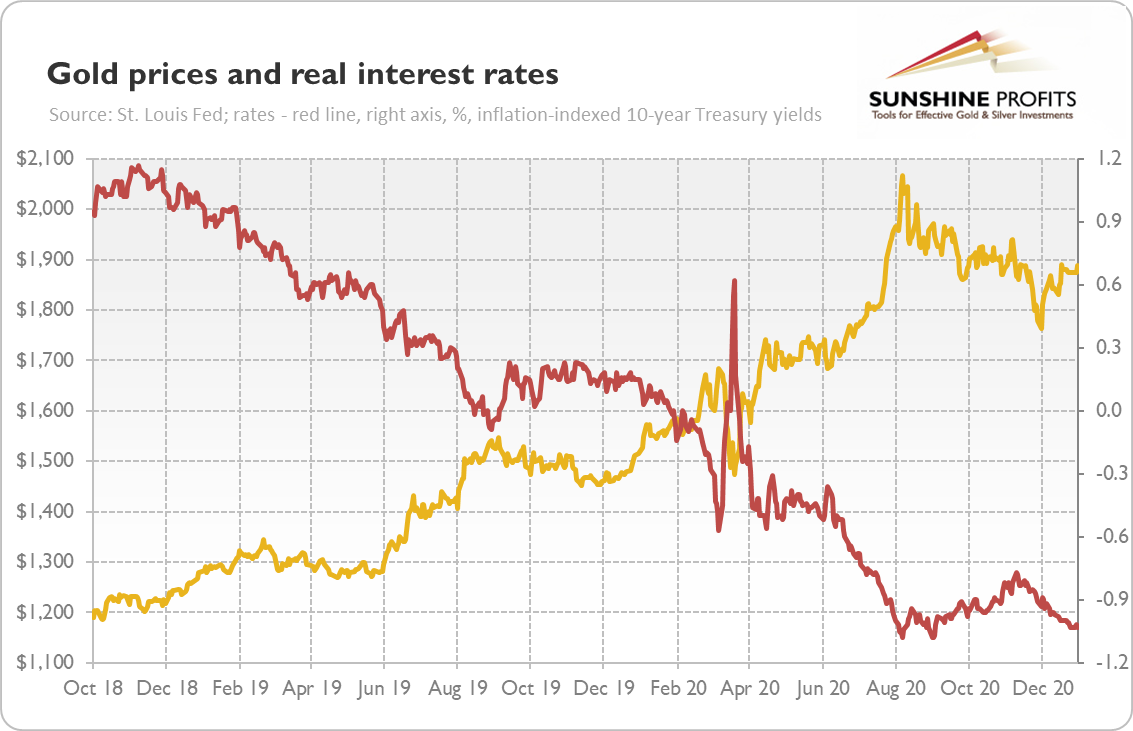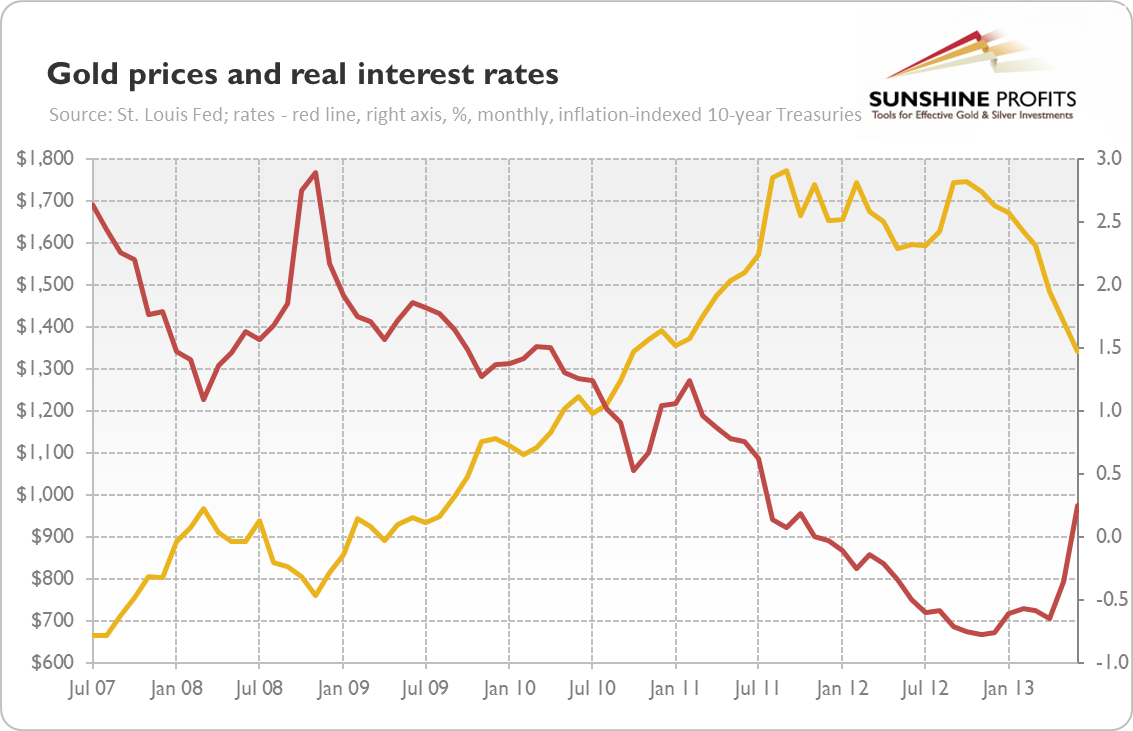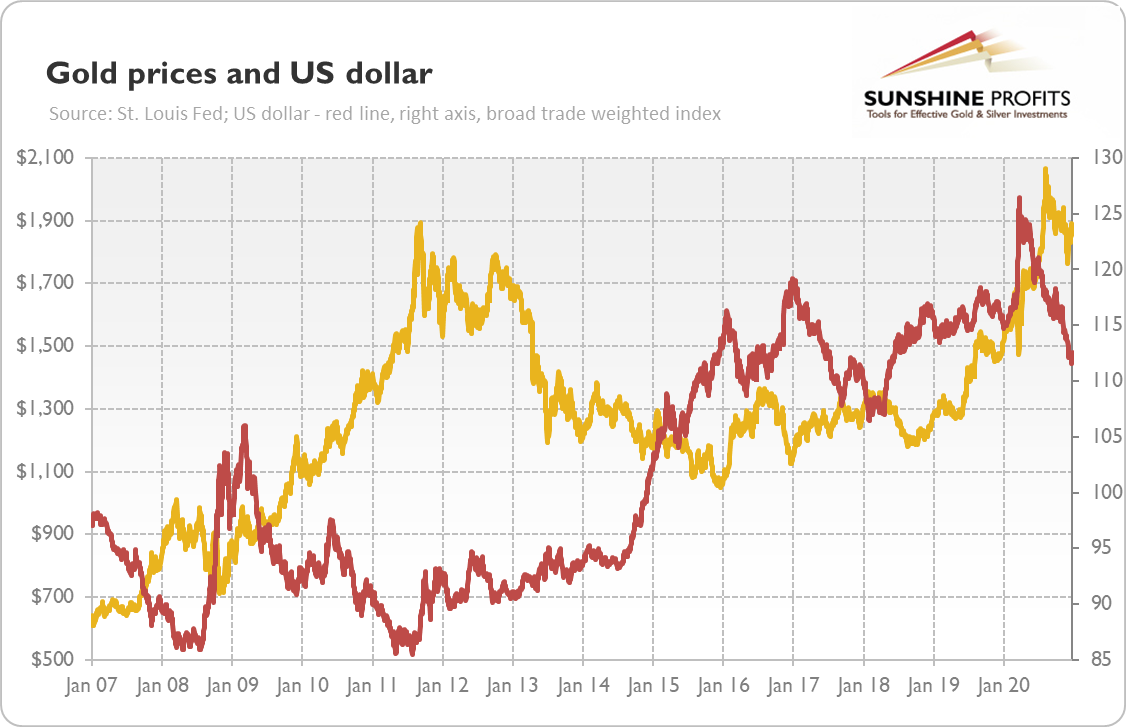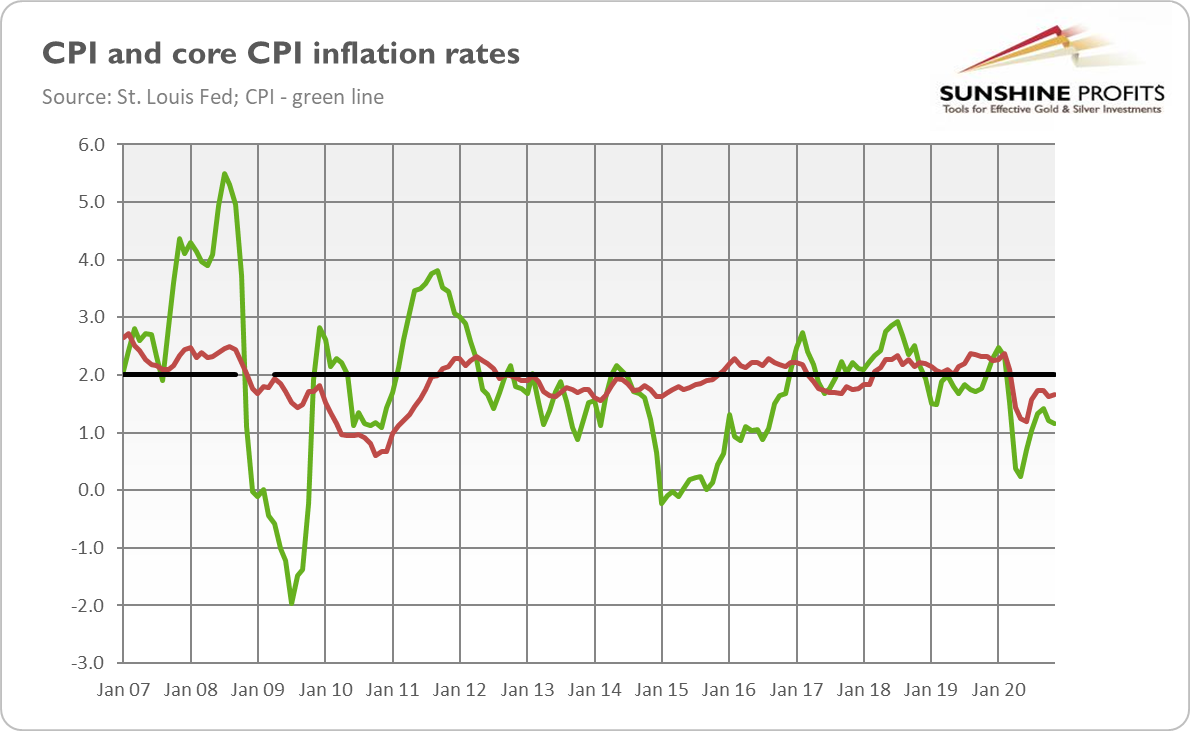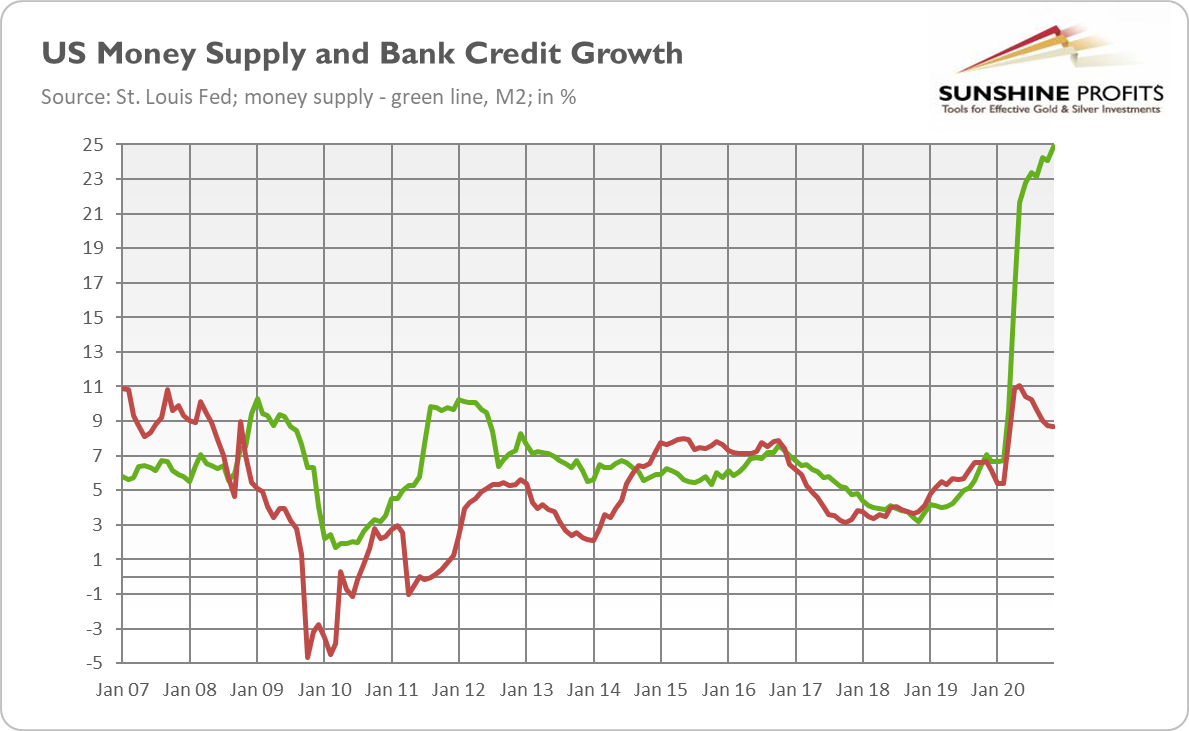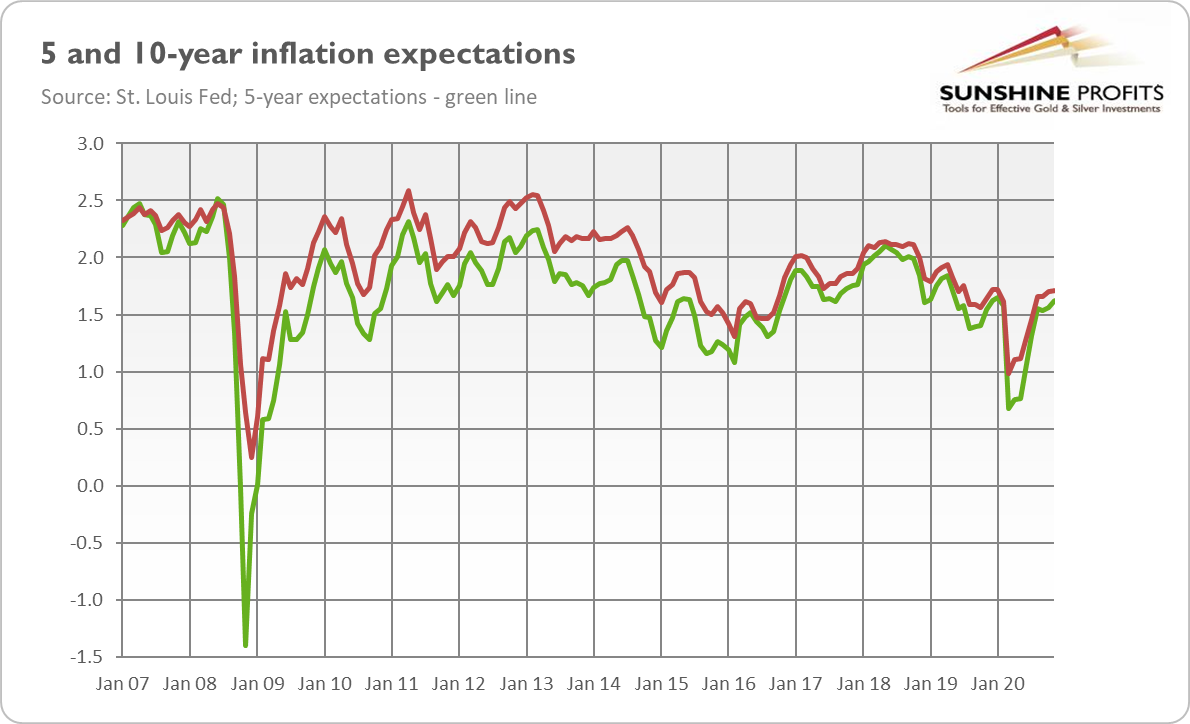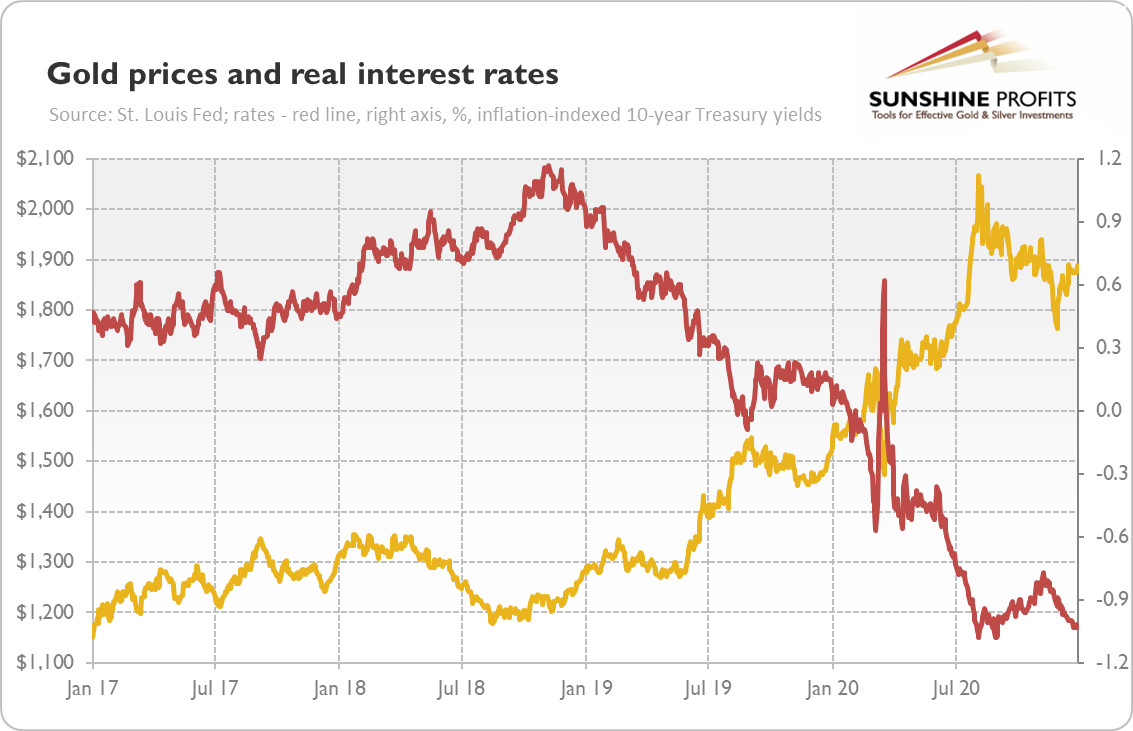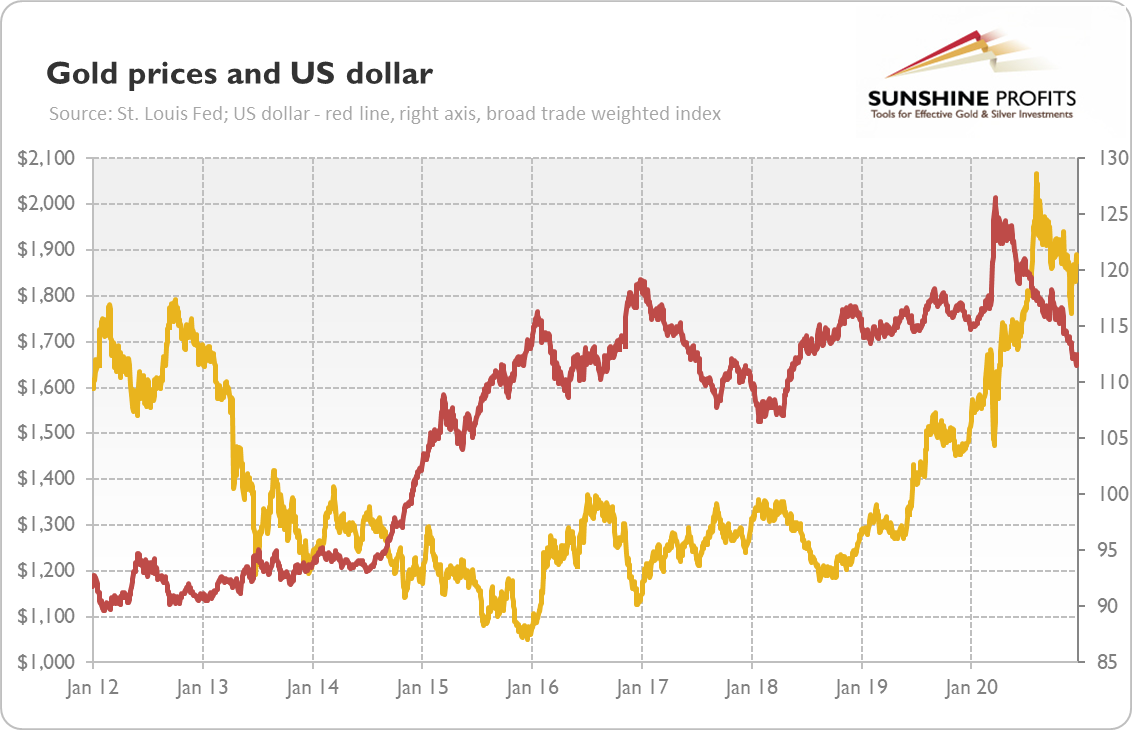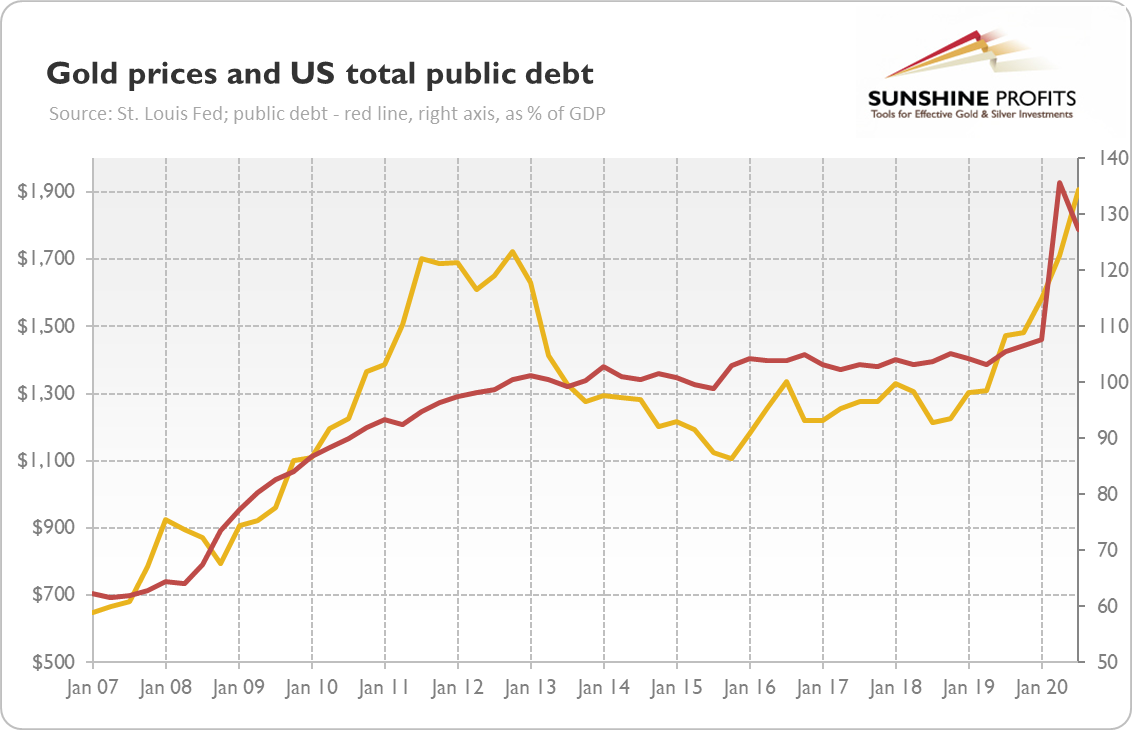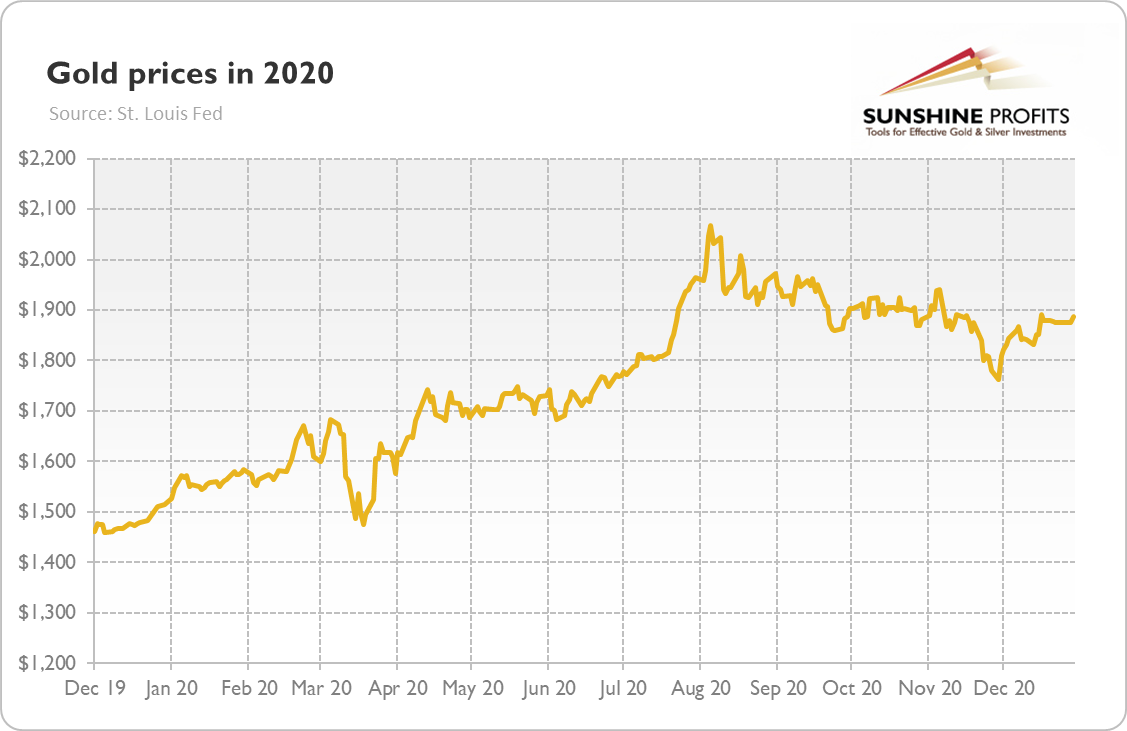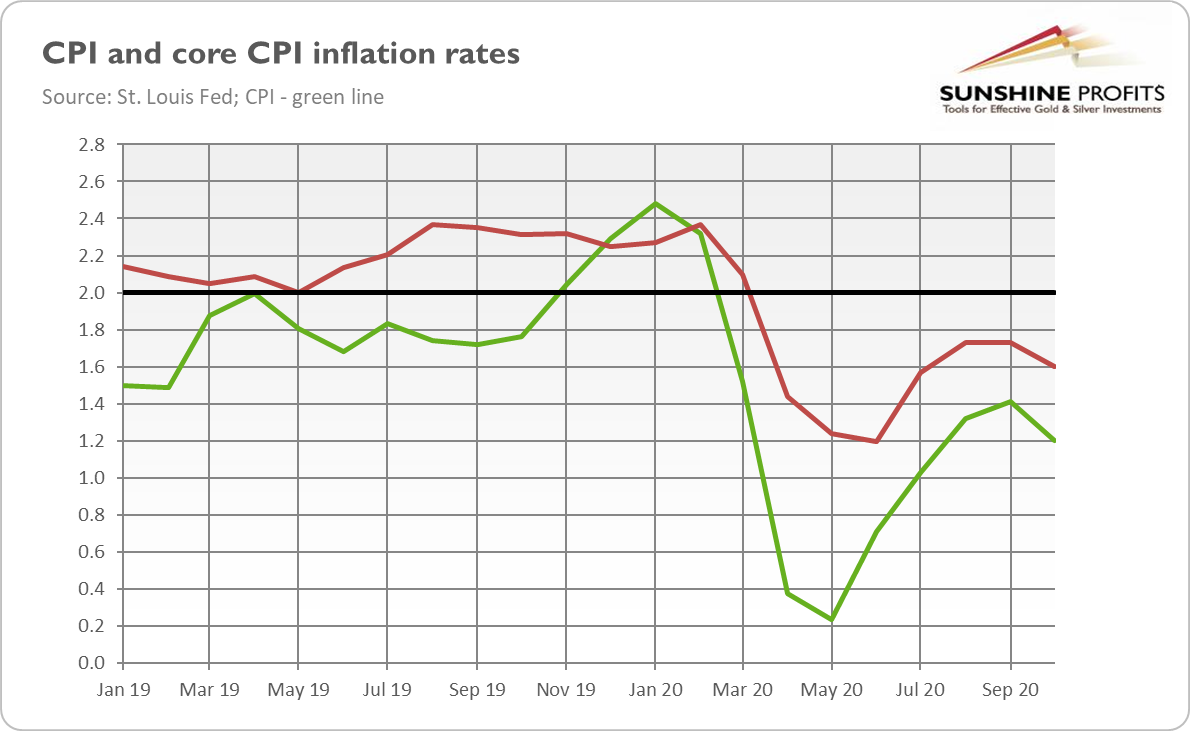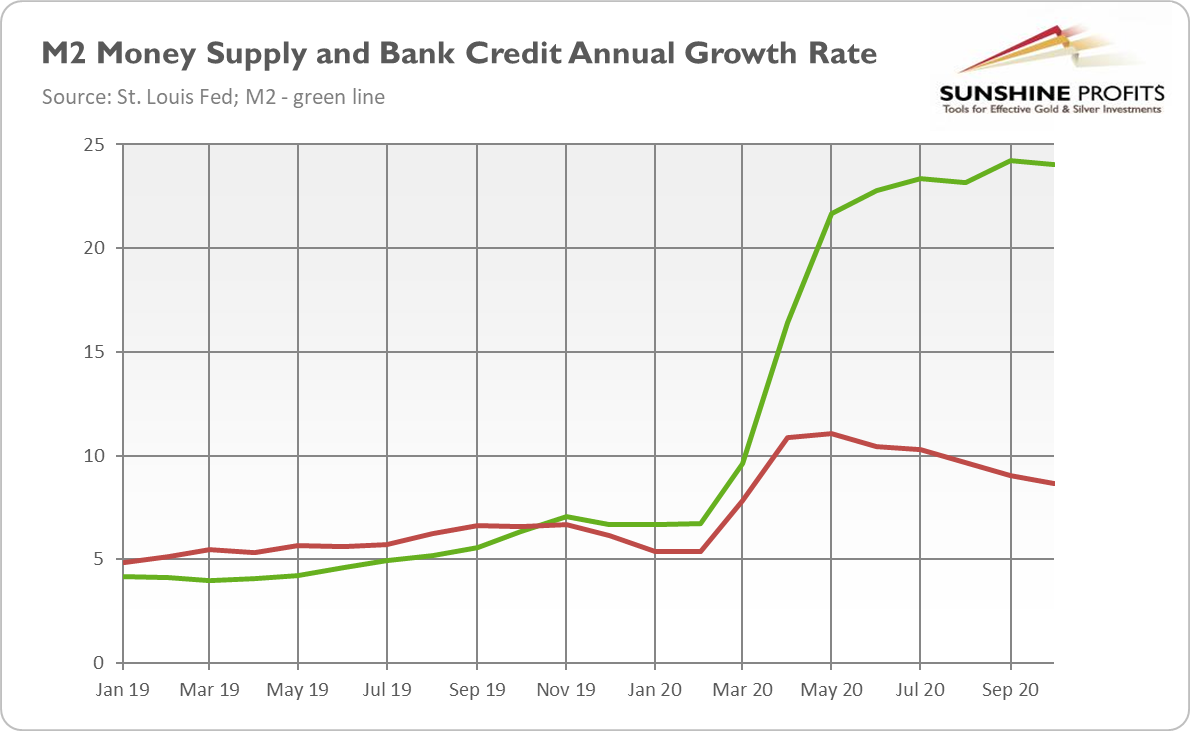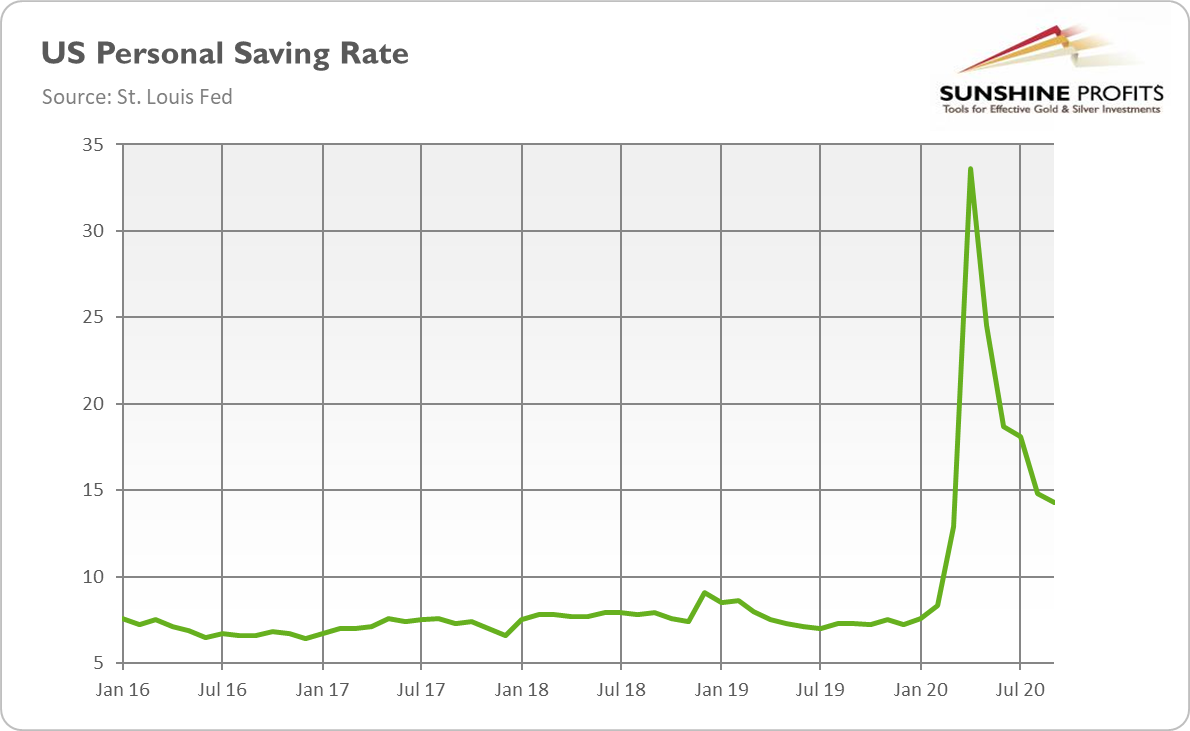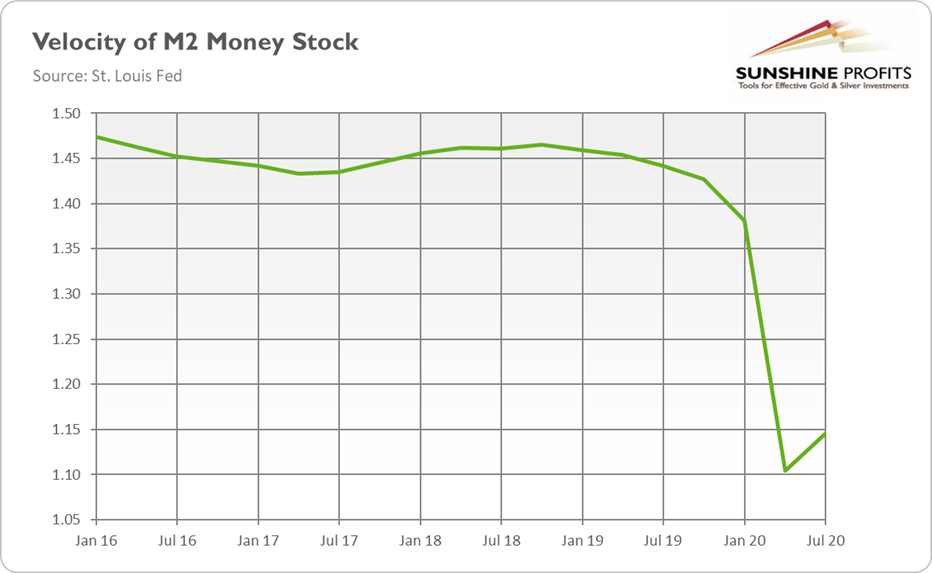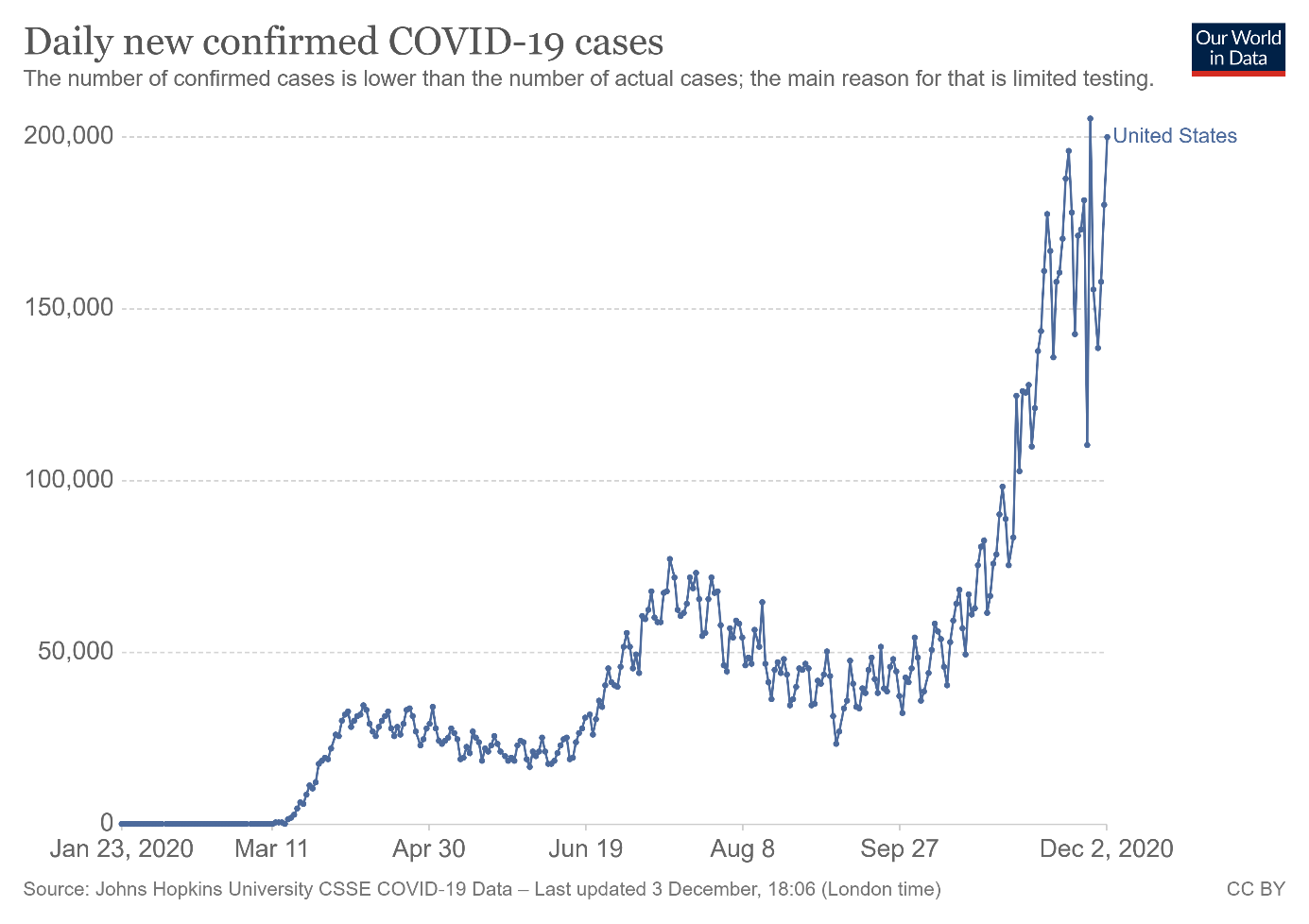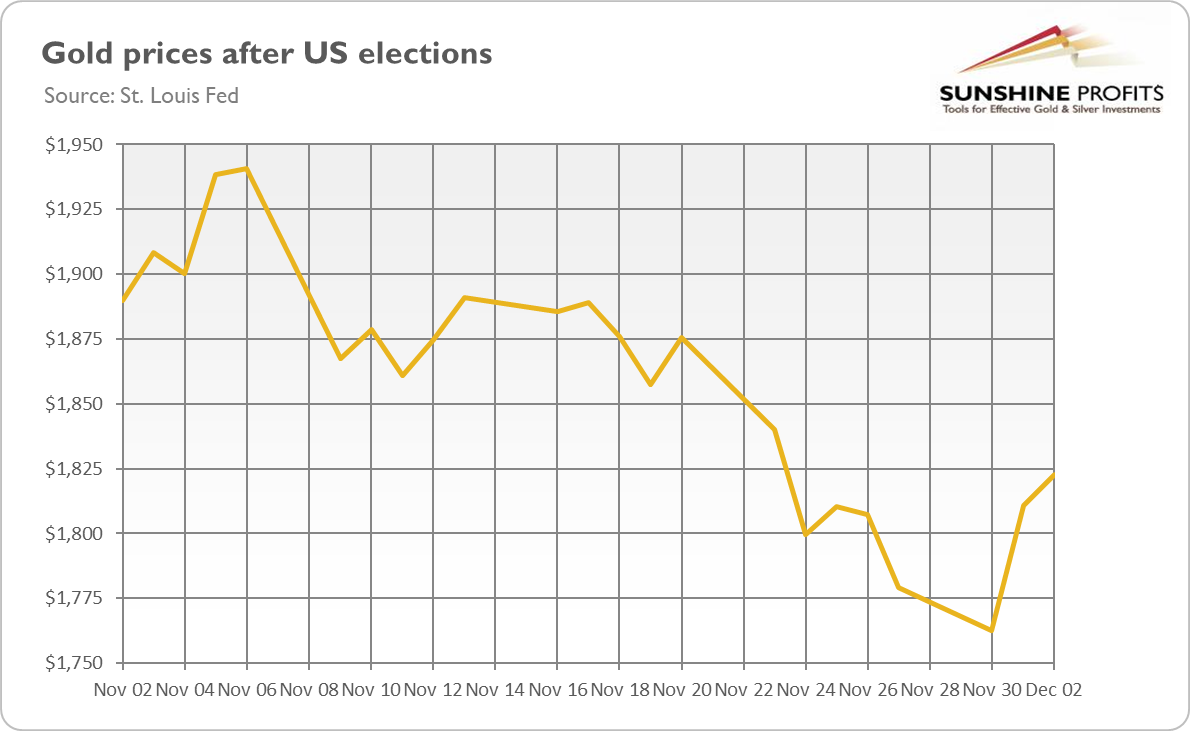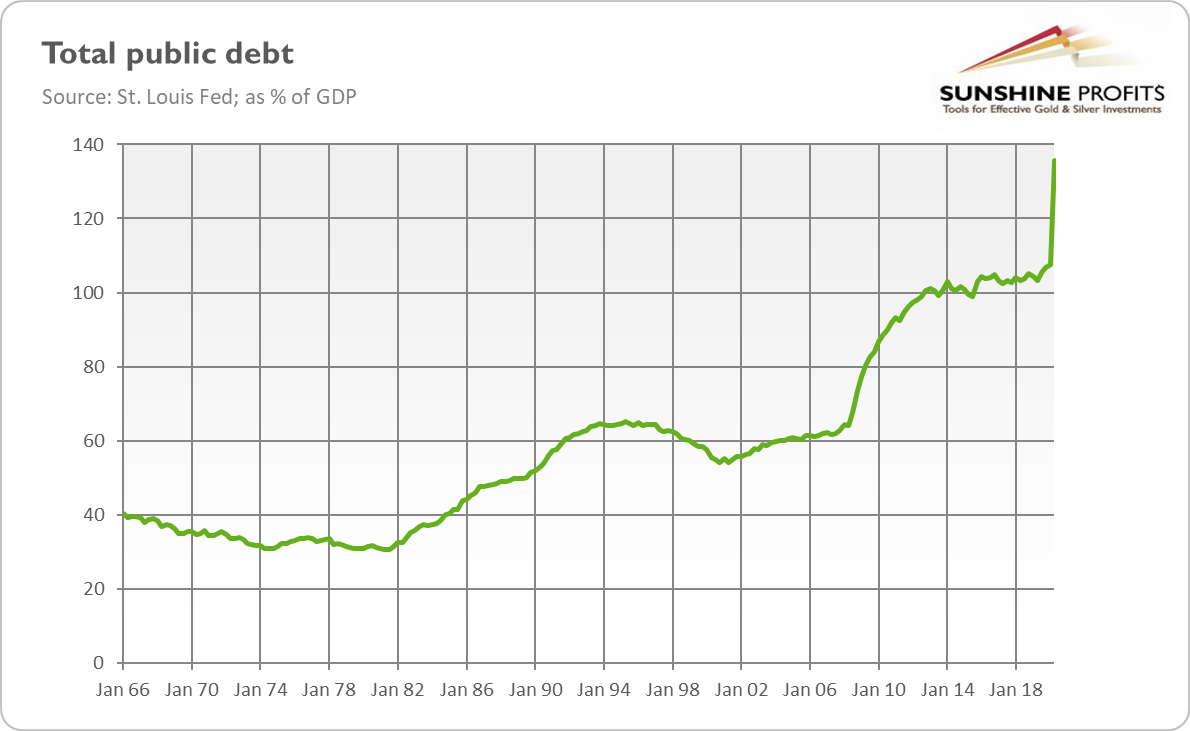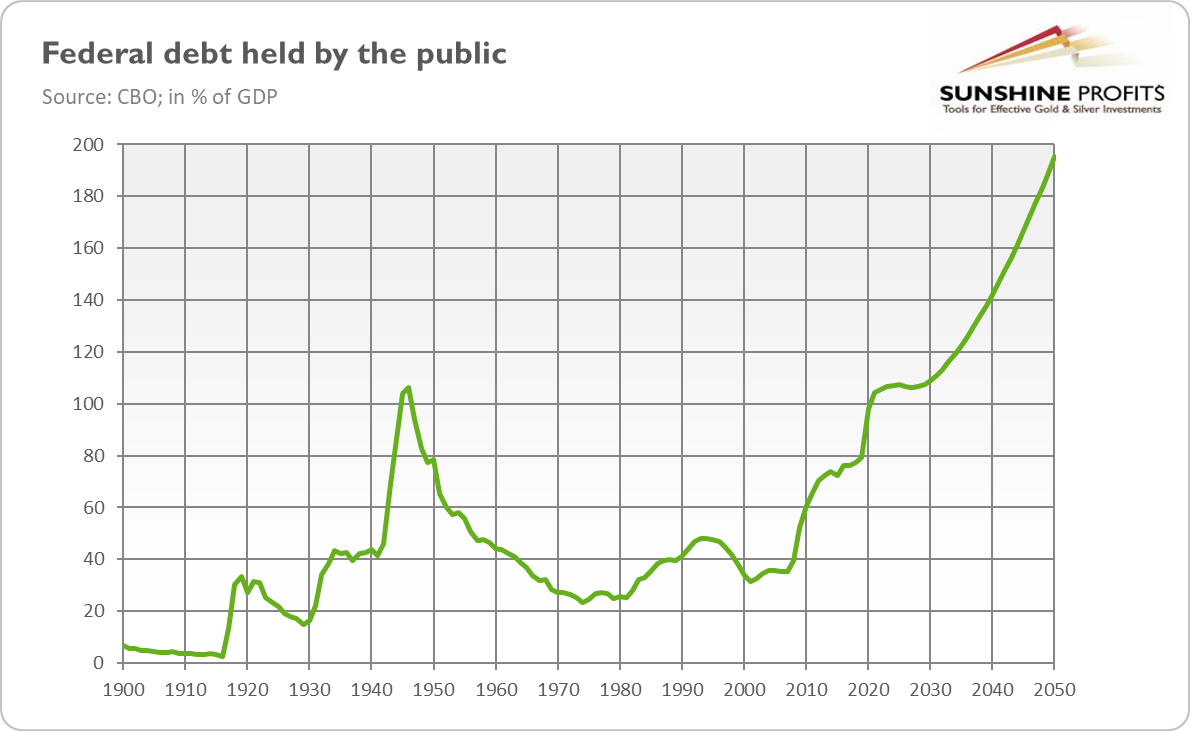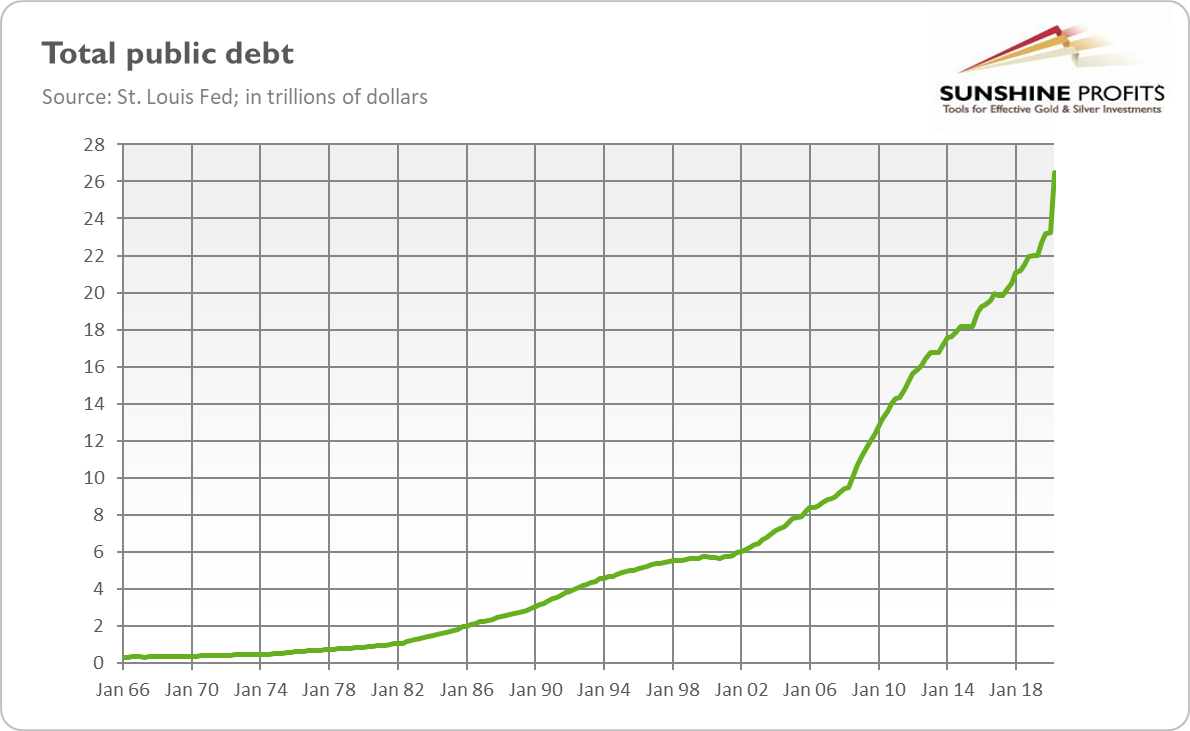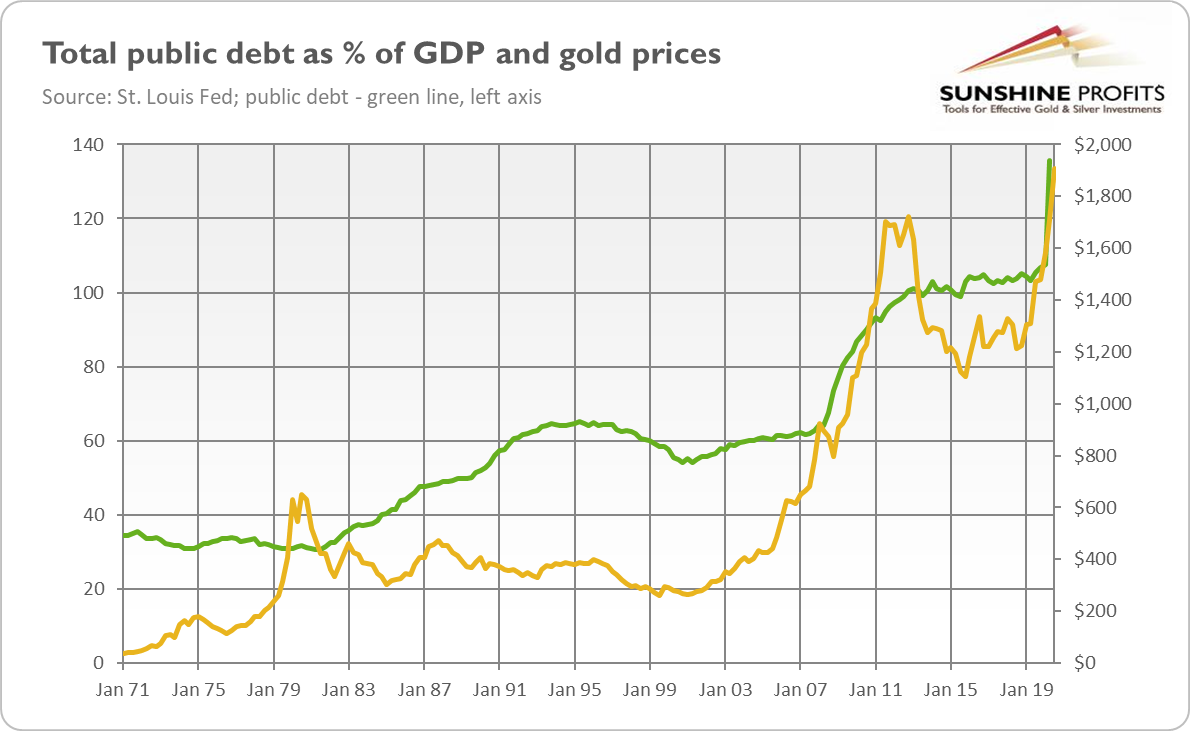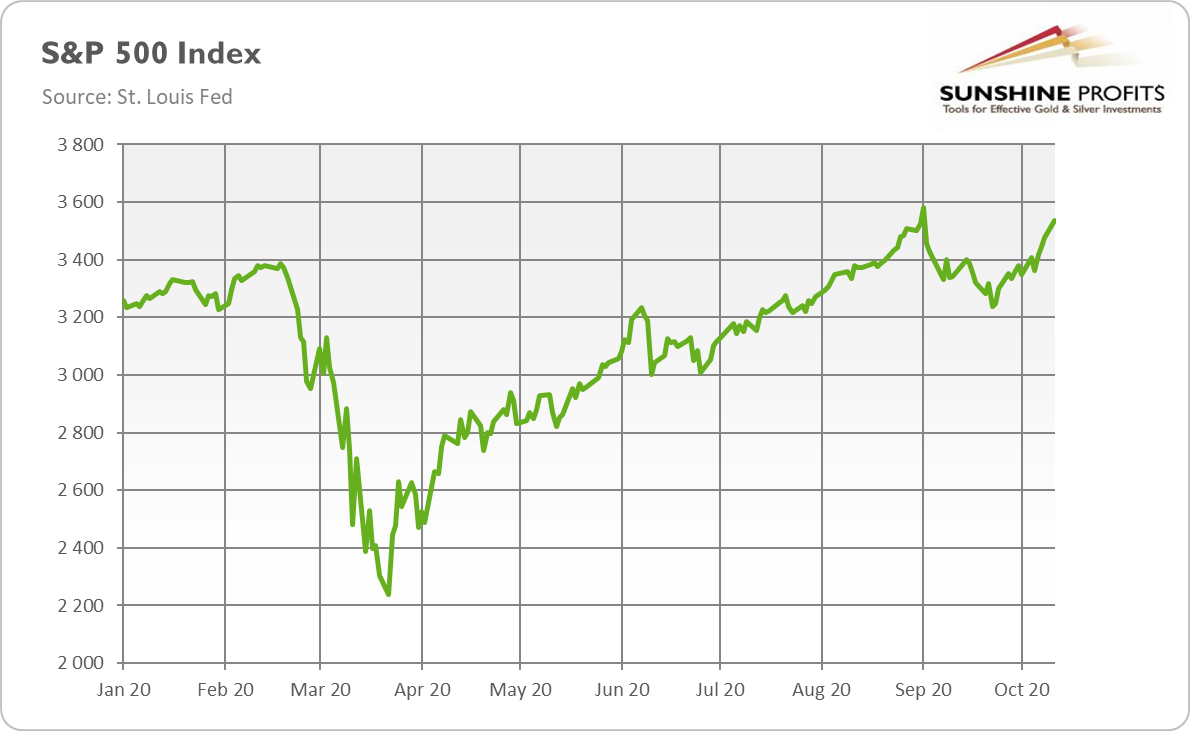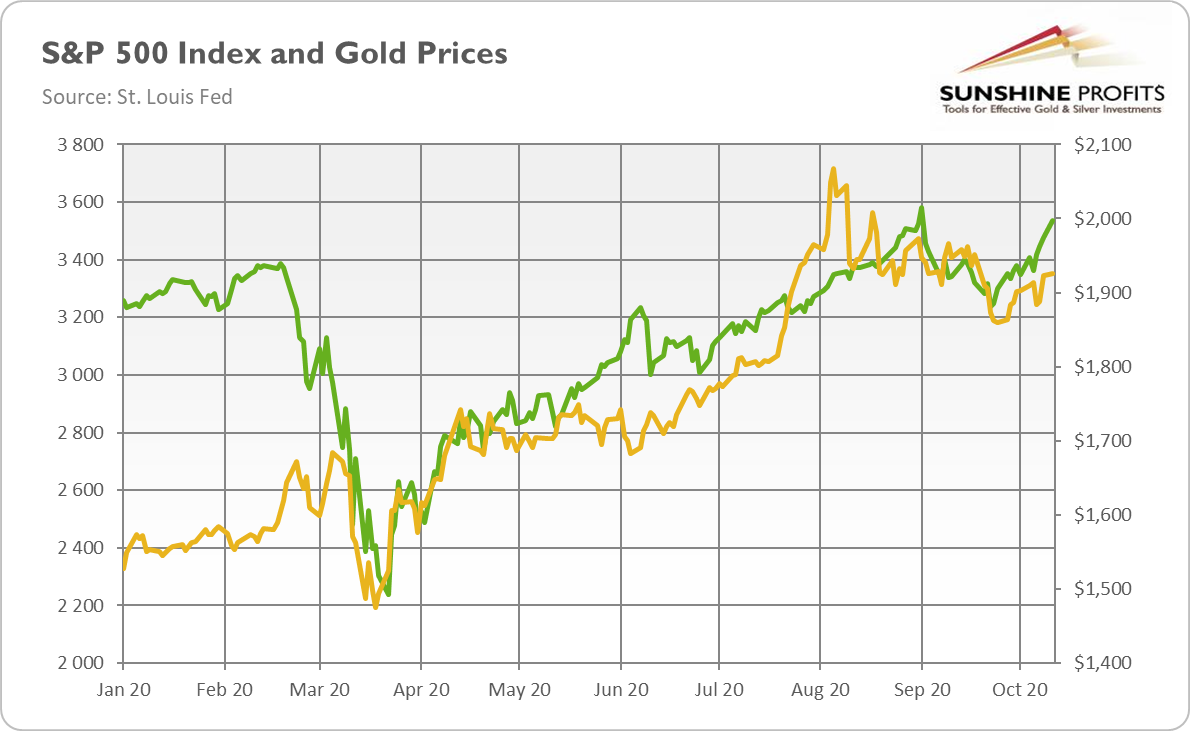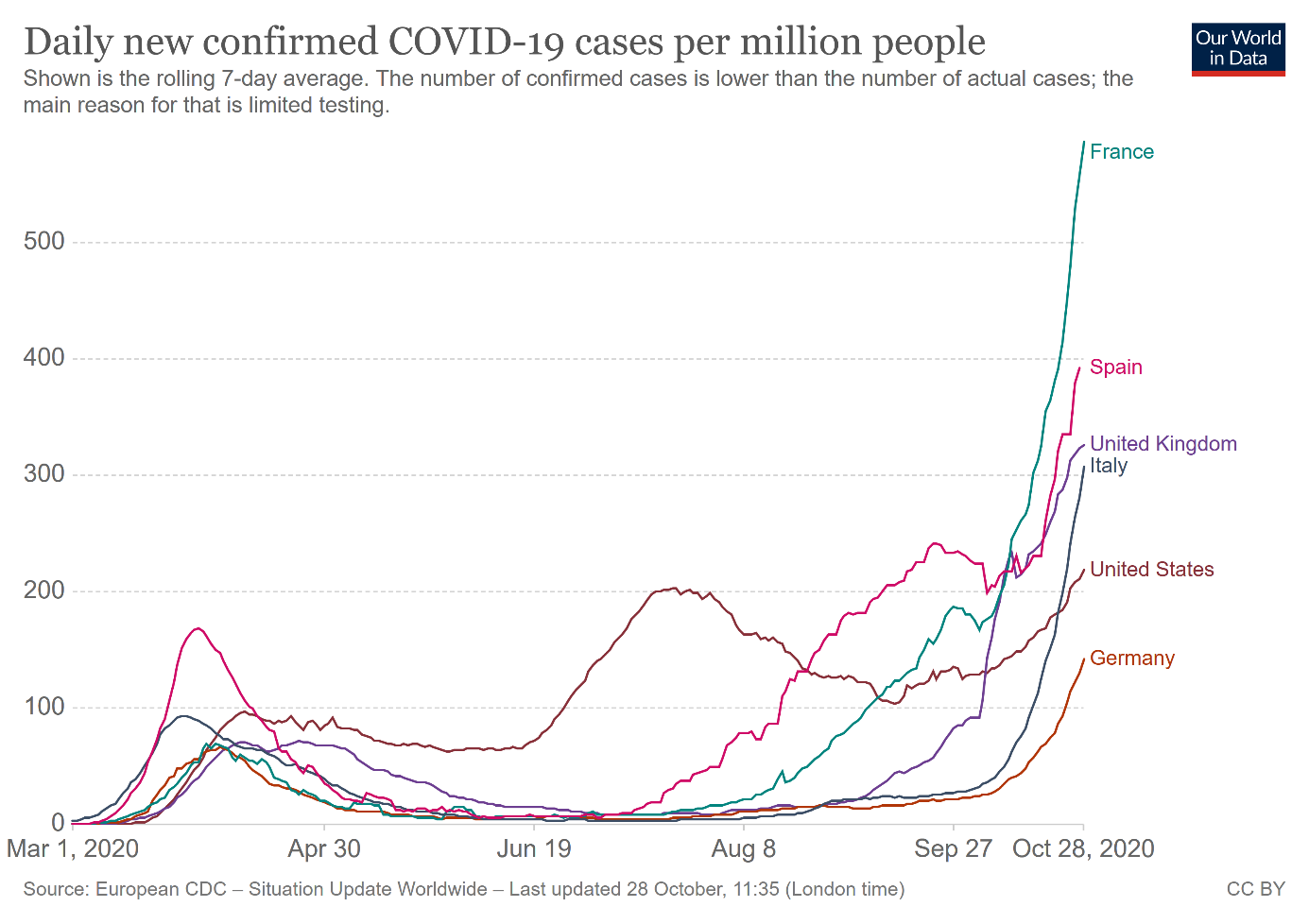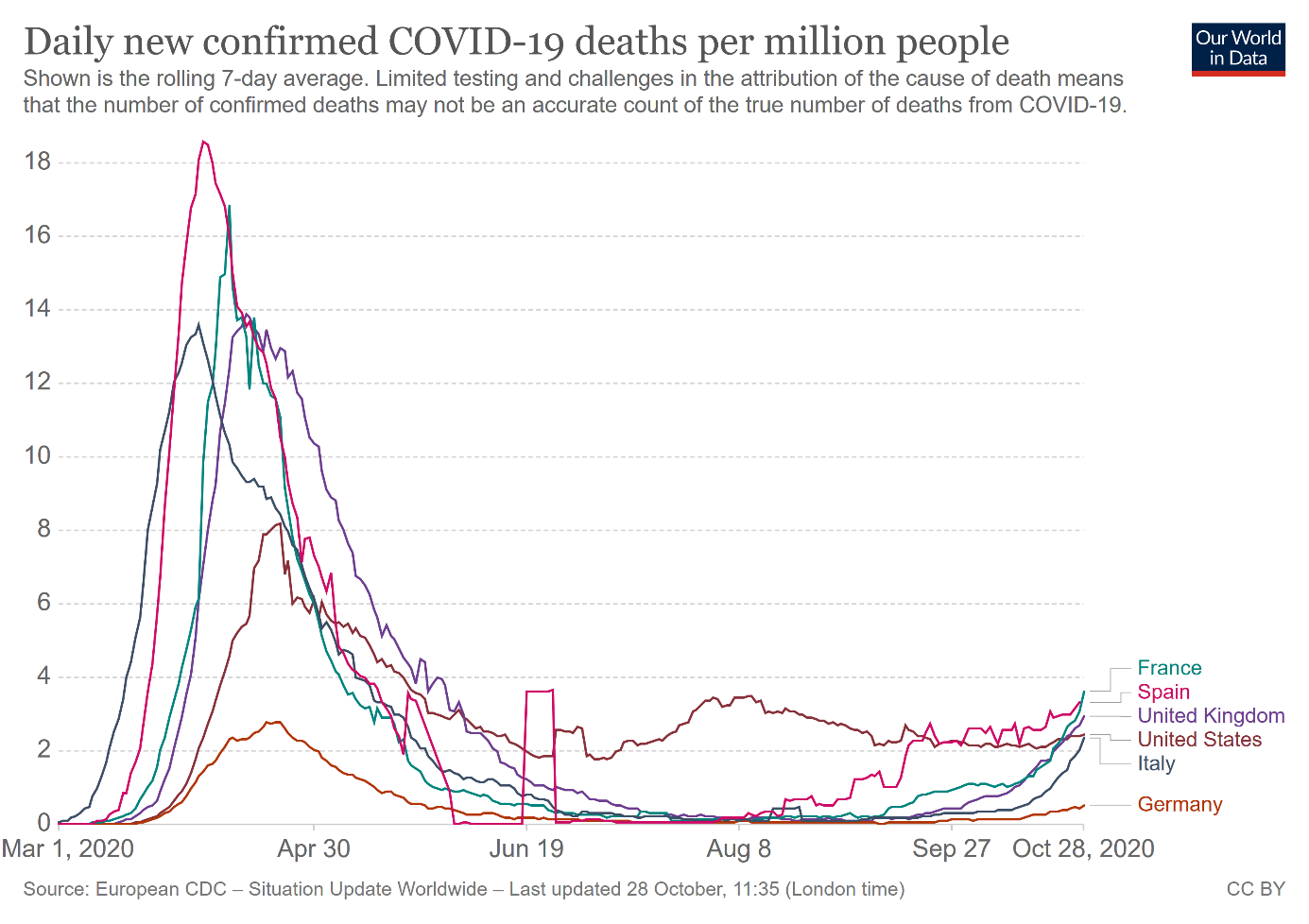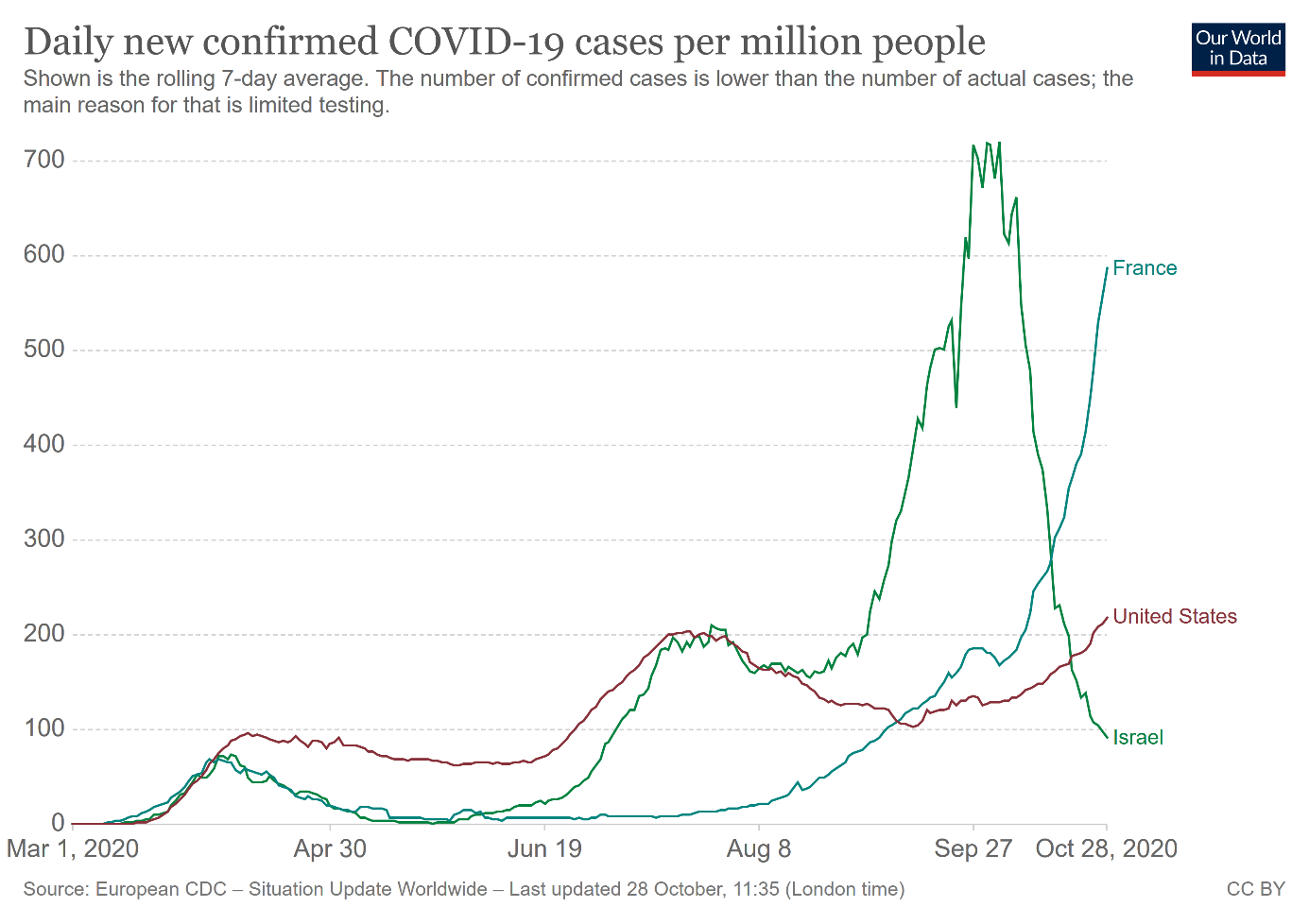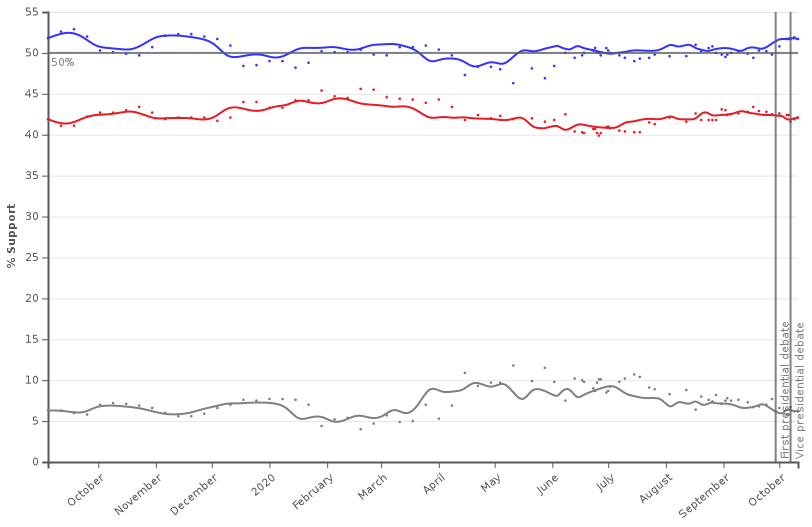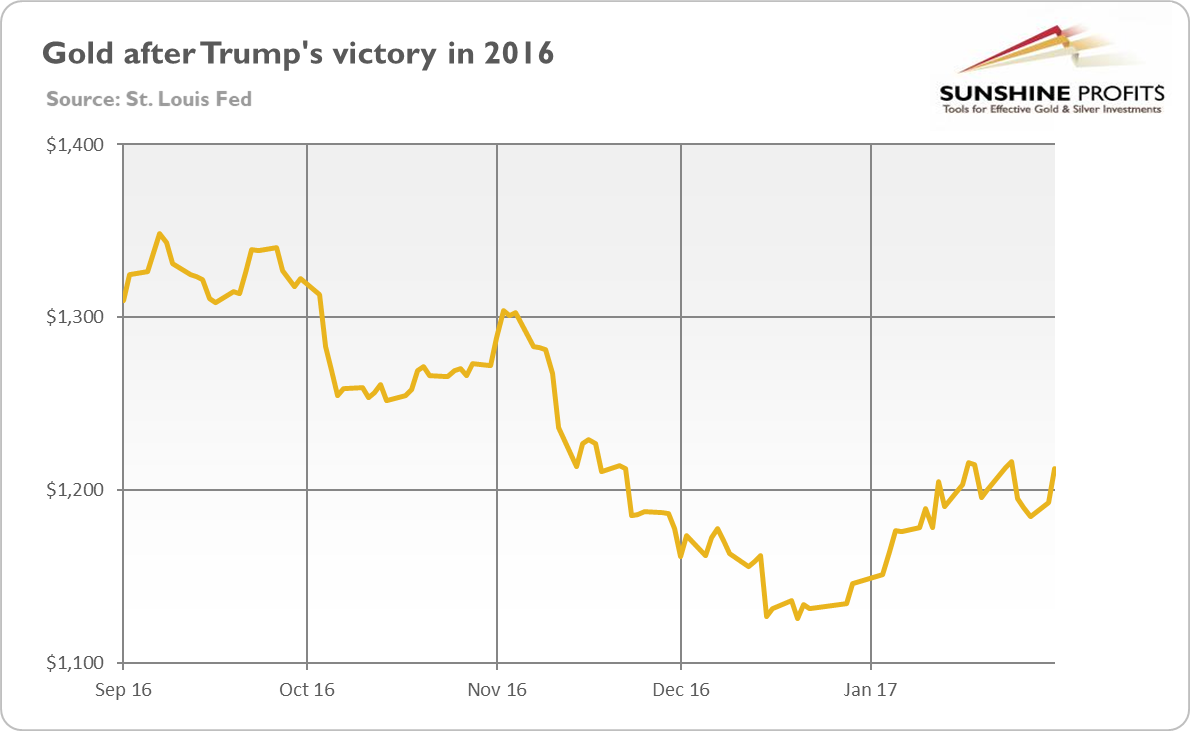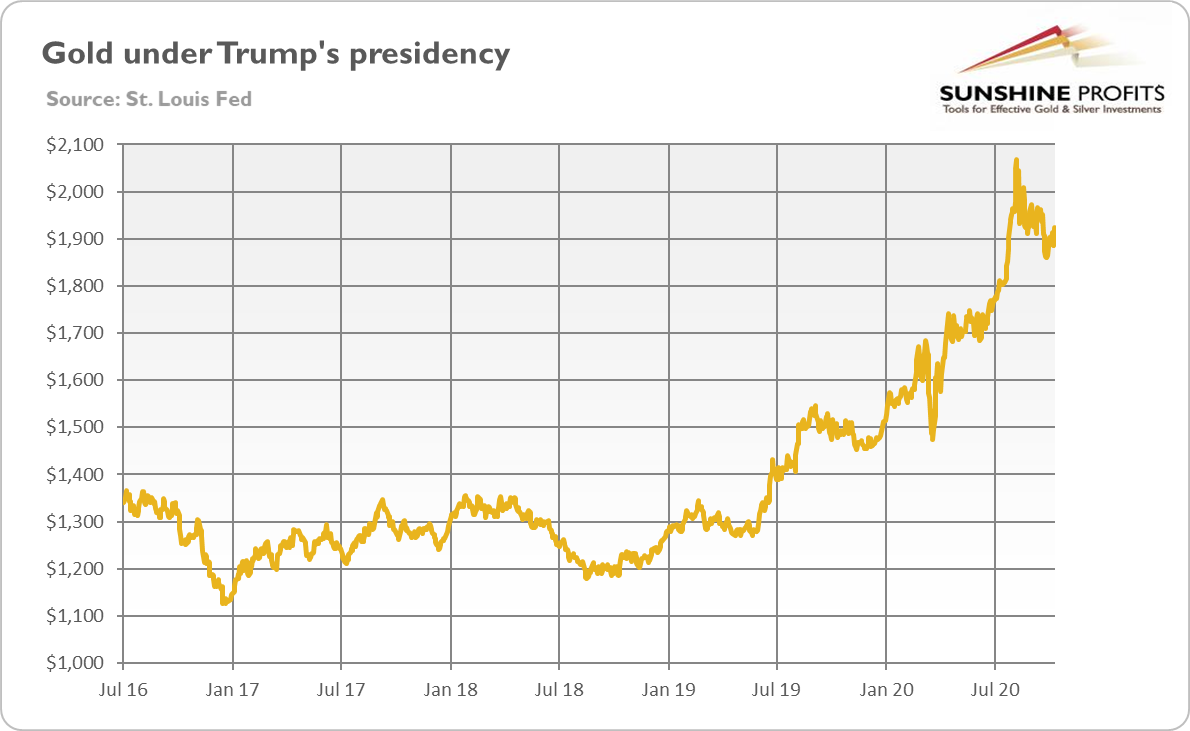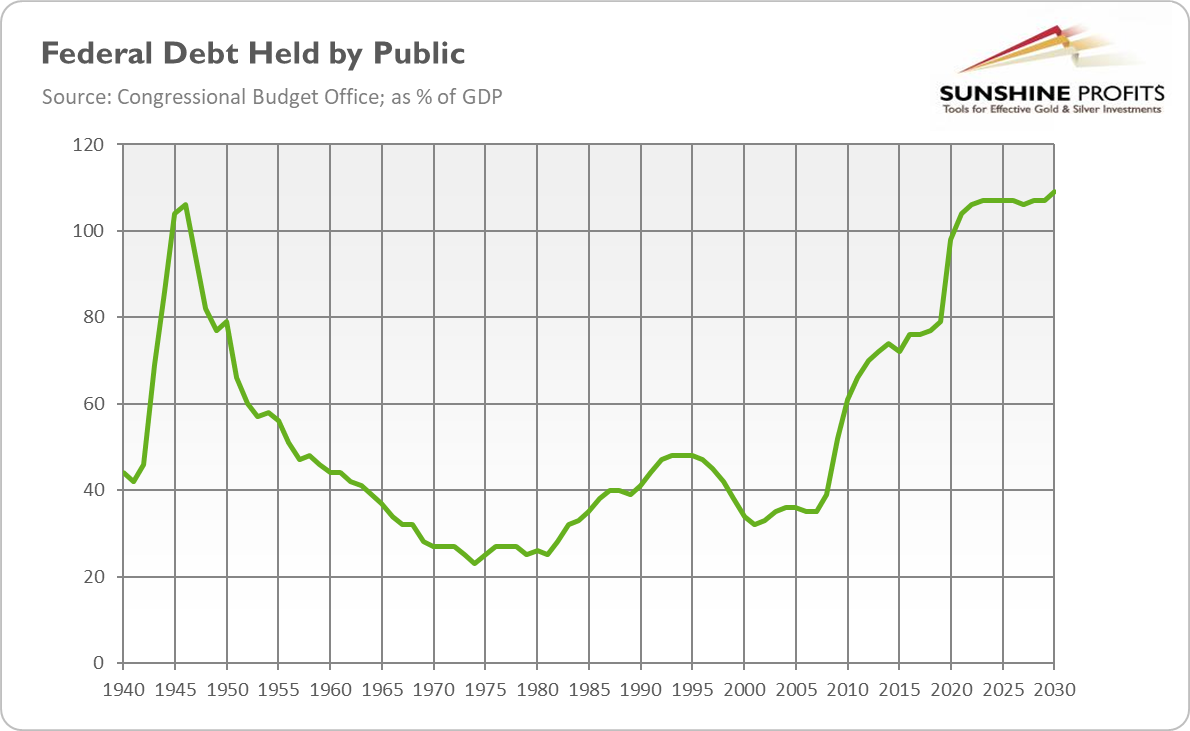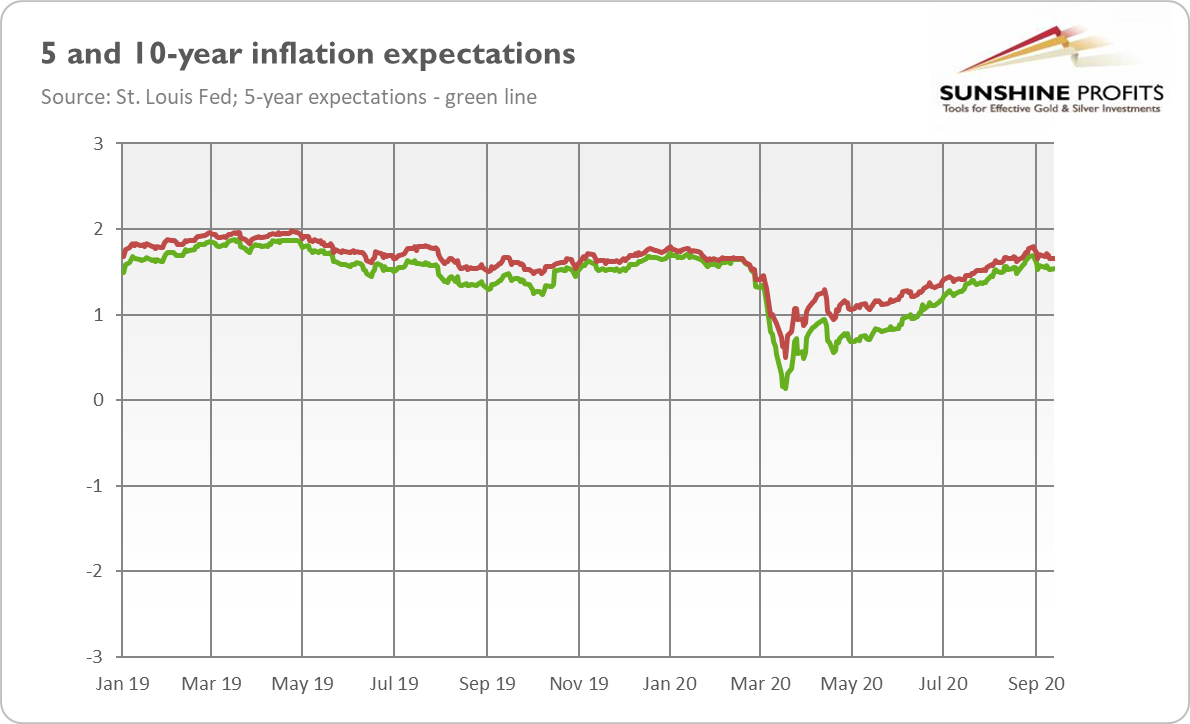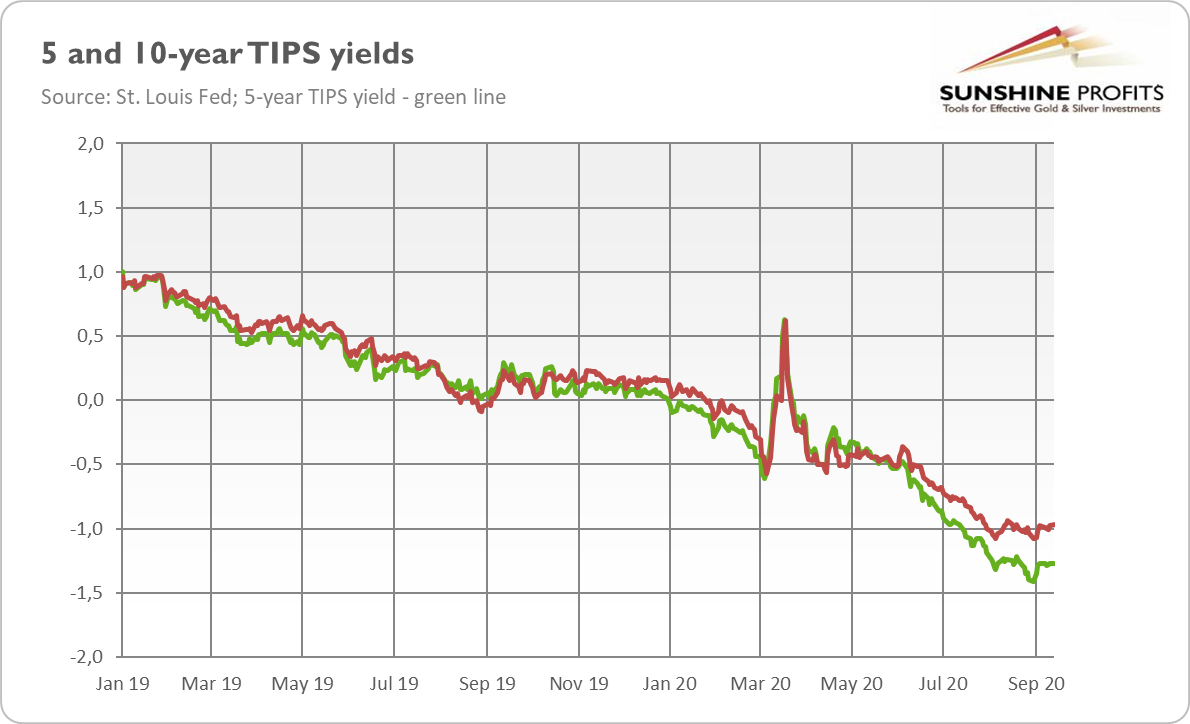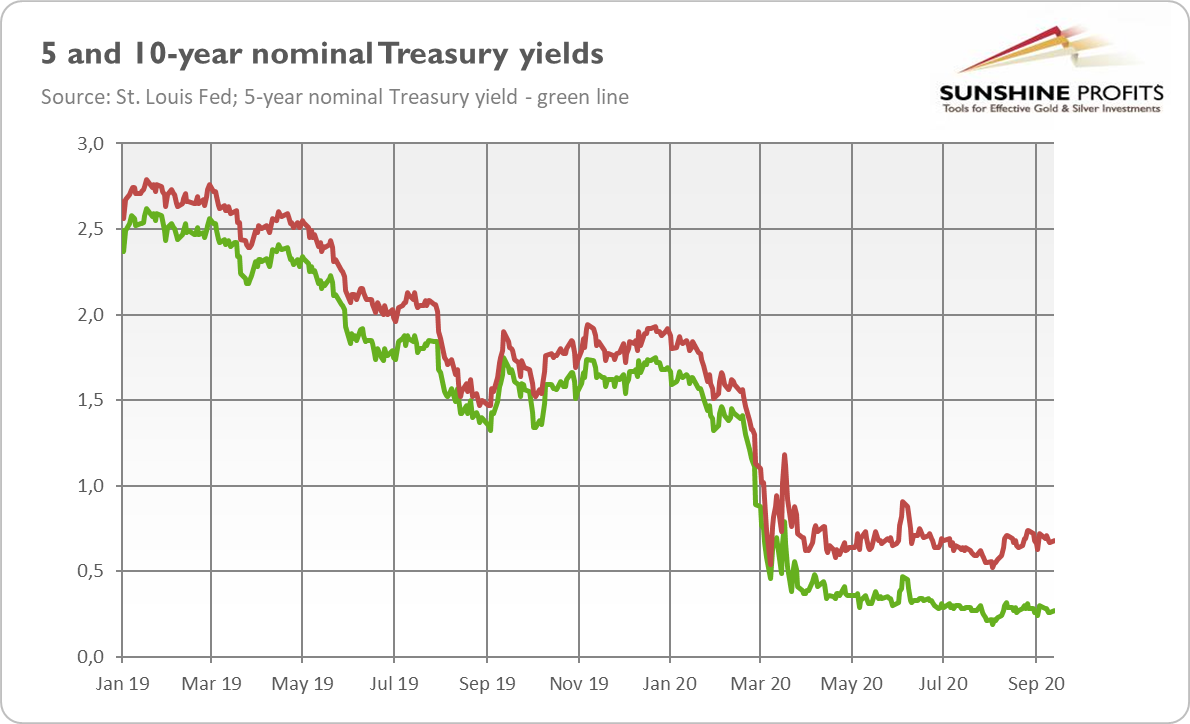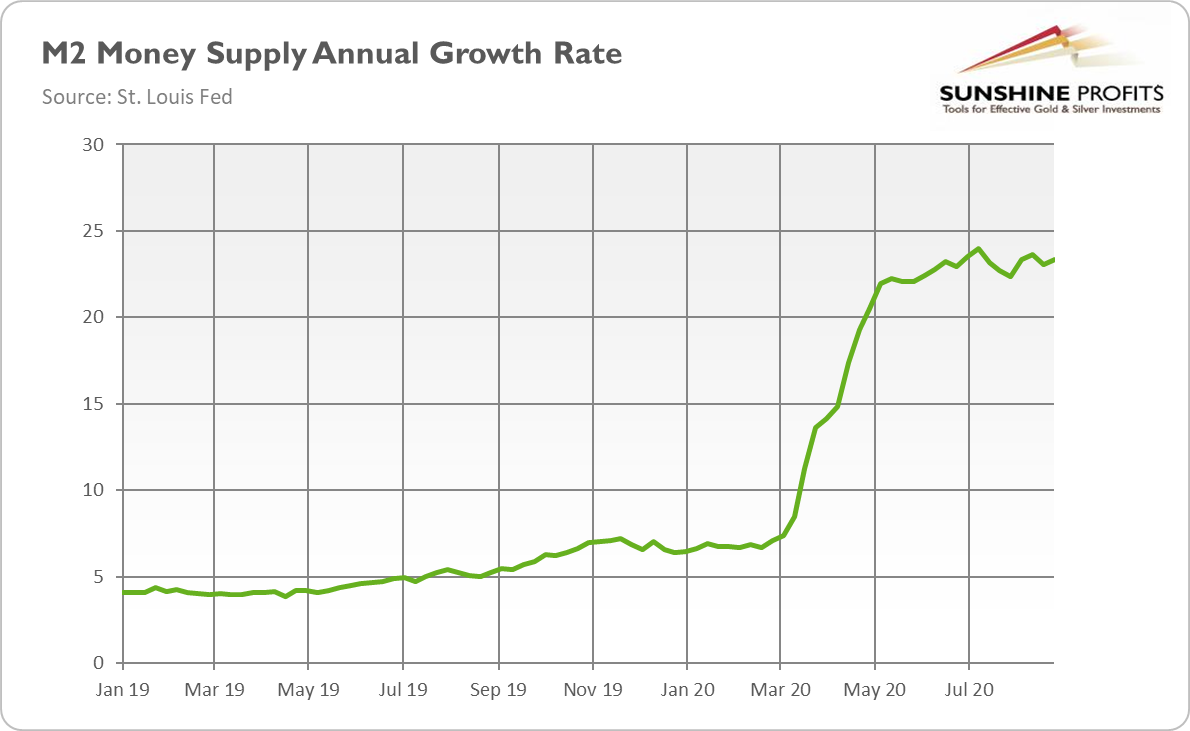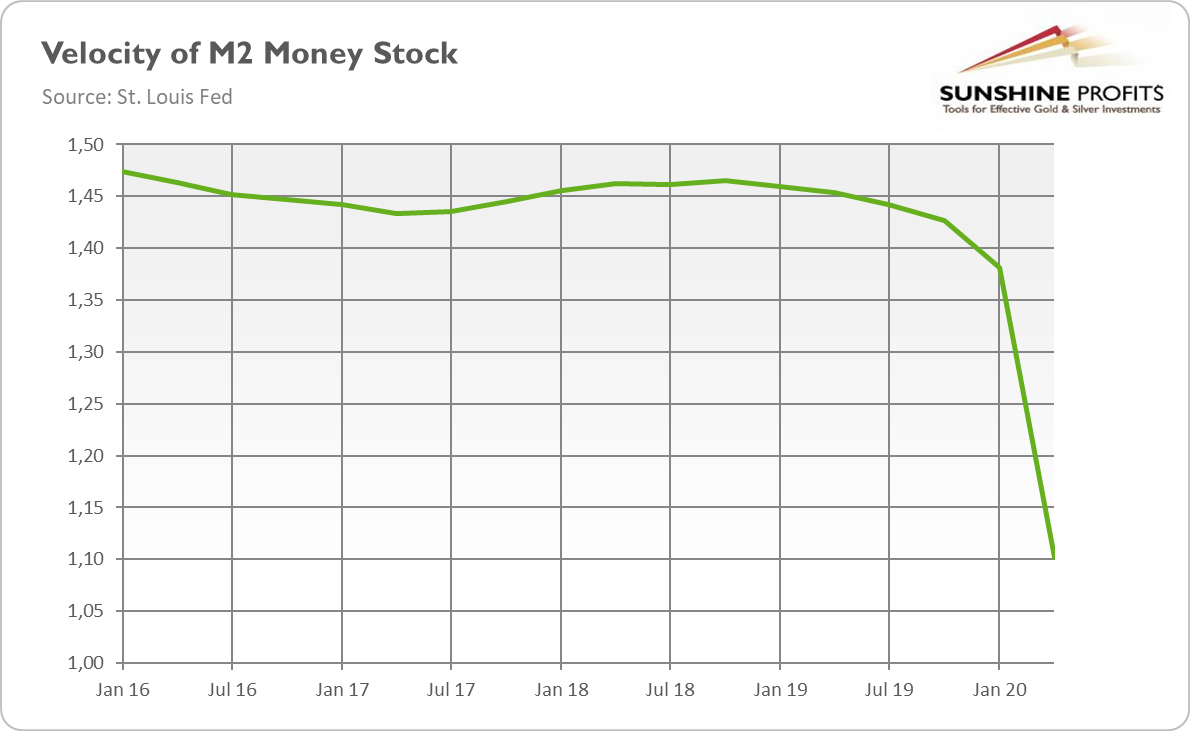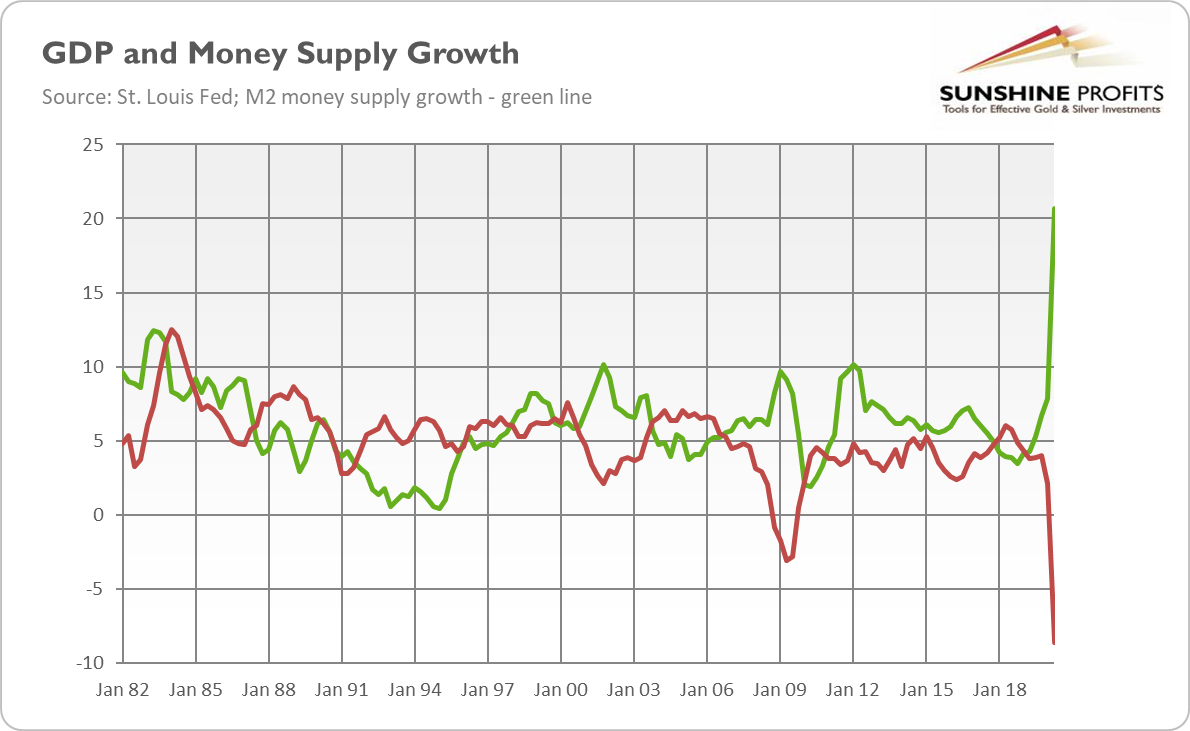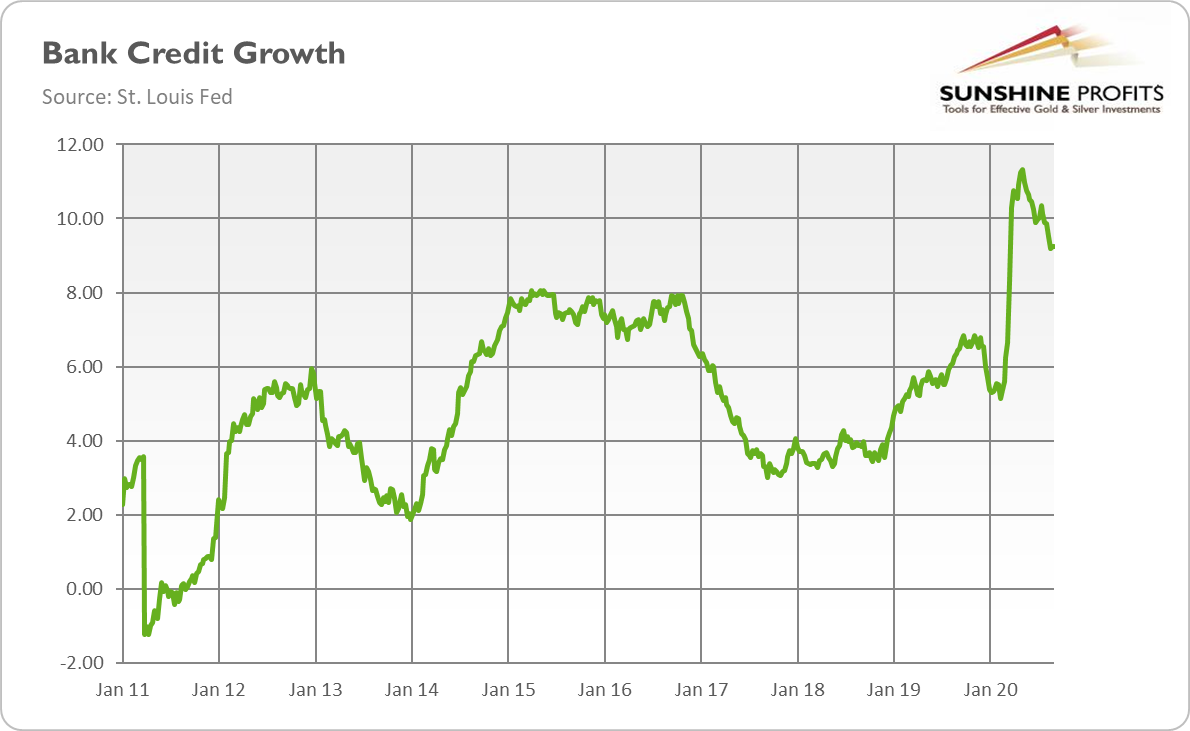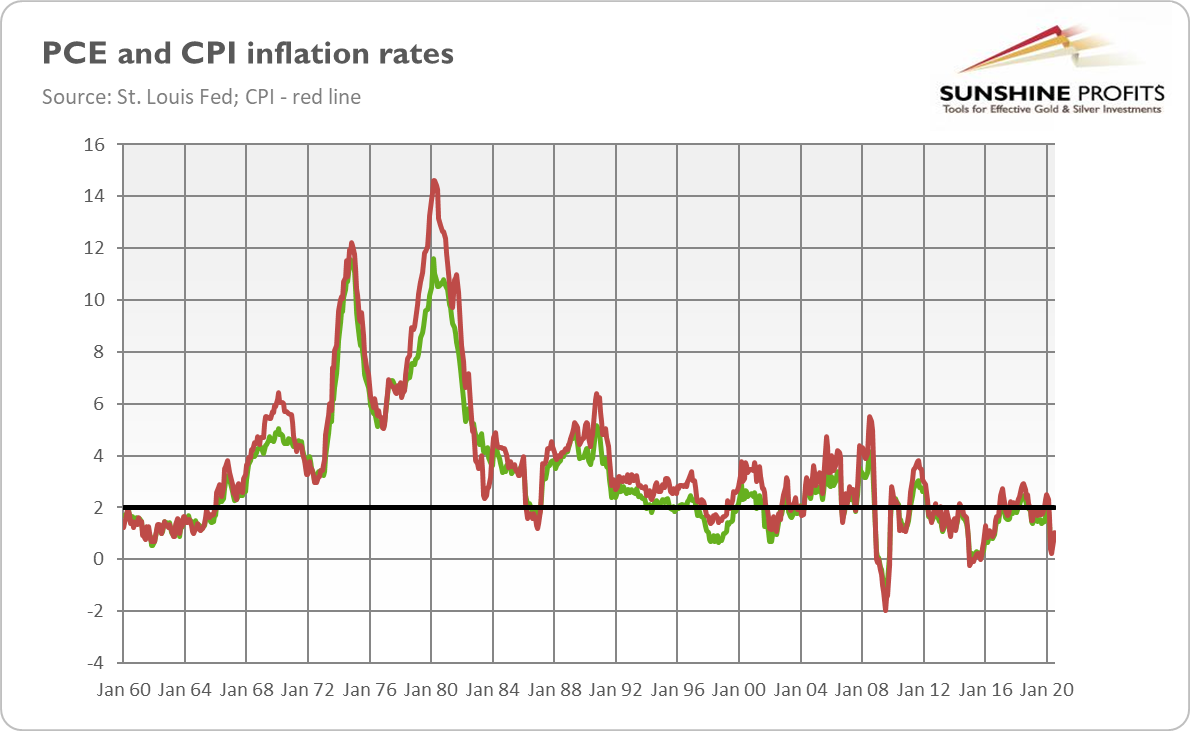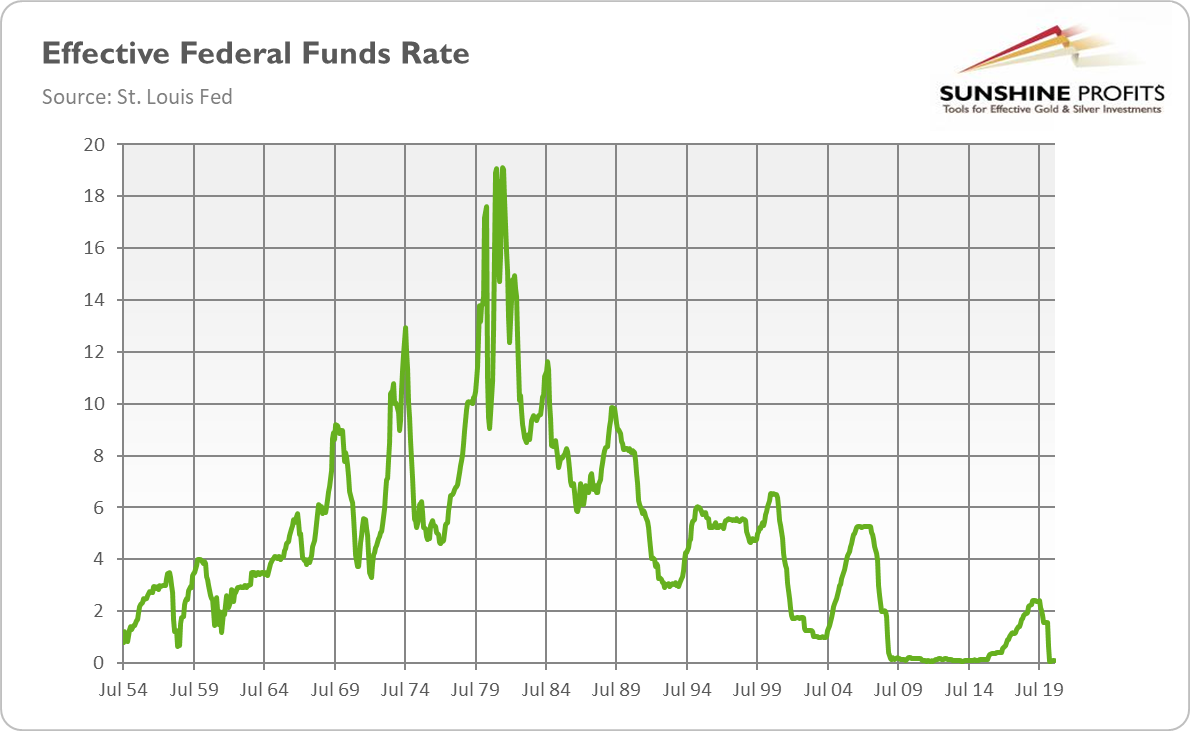tools spotlight

-
Gold During the Pandemic Winter
February 12, 2021, 8:17 AMThe pandemic winter will take longer than we thought. The longer we struggle with the coronavirus, the brighter gold could shine.
A long, long time ago, there was a bad virus, called the coronavirus, that killed many people all around the world and severely hit the global economy. Luckily, smart scientists developed vaccines that defeated the coronavirus and ended the pandemic. Since then, humankind lived happily – and healthy – ever after.
Sounds beautiful, doesn’t it? This is the story we were all supposed to believe. The narrative was that the development of vaccines would end the pandemic and we would quickly return to normalcy. However, it turns out that this was all a fairy tale – the real struggle with the coronavirus is more challenging than we thought.
First, the rollout of vaccinations has been very, very slow. As the chart below shows, on February 1, 2021, only about 1.77 percent of Americans became fully vaccinated against COVID-19.
Of course, full protection requires two doses, so it takes some time. But in many countries, the share of the population which received at least one dose of the vaccine is also disappointingly low, as the chart below shows.
It means that our progress towards herd immunity is really sluggish. At such a pace, we are losing the race between injections and infections. And we will not reach herd immunity until the second half of the year or even the next winter…
Second, there is the problem of mutations. The new strains are rapidly popping up which poses a great risk in our fight with the coronavirus. One of these new variants was identified in the United Kingdom and quickly spread through the country. Although it’s not more lethal, it’s more infectious, which makes it more dangerous overall. And the more variants emerge, it’s more likely that we could see a mutation resistant to our current treatments and vaccines. Indeed, some of the mutations change the surface protein, spike, and have been shown to reduce the effectiveness of combating the coronavirus by monoclonal antibodies.
The really bad part is that these two problems are strongly connected. The longer the vaccinations take, the more active cases we have. The more active cases we have, the more mutations happen, as each new infection implies more copies of the coronavirus, which gives it more chances to mutate. The more mutations occur, the higher the odds of a really nasty strain. Therefore, the longer the vaccination process takes, the more probable it is that it will not work and that vaccine-resistant variants might emerge.
Given that in many countries vaccinations are practically the only rational strategy to fight the virus, the vaccine-resistant strain would be a serious blow. Surely, some vaccines could be relatively easily updated, but their rollout would still require time – time we don’t have.
What does it all imply for the gold market? Well, the more sluggish the vaccinations, the higher the risk that something goes wrong and that our battle with COVID-19 will take more time. The longer the fight, the slower the economic recovery. The longer and bumpier road toward herd immunity, the slower lifting sanitary restrictions and social distancing measures, and the later we come back to normalcy. The longer we live in Zombieland, the easier fiscal and monetary policies will be, and the brighter gold will shine.
Another issue is that we shouldn’t forget about the possibility of the pandemic’s long economic shadow. A recent paper has examined the effects of 19 major previous pandemics, finding a long shadow of the economic carnage. Although financial markets are still (wrongly, I believe) betting on a V-shaped recovery, the history suggests that a double dip is likely, as eight of the last 11 recessions experienced it. Recessions sound golden, don’t they?
However, there is one caveat here. The sensitivity of economic activity to COVID-19 infections and restrictions has significantly diminished since the Great Lockdown in the spring of 2020. There are three reasons for that. First, people fear the coronavirus less. Second, epidemic restrictions are better targeted and implemented. Third, entrepreneurs adopted better to cope with the epidemic.
The greater resilience of the economy means a smaller downturn and fewer long-term scars, which will limit any upward COVID-19 related impact on gold prices. But a softer economic impact also implies a quicker recovery, which – together with the upcoming big government stimulus – could increase consumer prices, thus supporting gold prices through the inflation channel. Indeed, commodity prices have been surging in 2021, so gold may follow suit.
Thank you for reading today’s free analysis. If you enjoyed it, and would you like to know more about the links between the economic outlook, the current (past?) crisis and the gold market, we invite you to read the February Gold Market Overview report. Please note that in addition to the above-mentioned free fundamental gold reports, and we provide premium daily Gold & Silver Trading Alerts with clear buy and sell signals. We provide these premium analyses also on a weekly basis in the form of Gold Investment Updates. In order to enjoy our gold analyses in their full scope, we invite you to subscribe today. If you’re not ready to subscribe yet though and are not on our gold mailing list yet, we urge you to sign up. It’s free and if you don’t like it, you can easily unsubscribe. Sign up today!
Arkadiusz Sieron, PhD
Sunshine Profits: Effective Investment through Diligence & Care.-----
Disclaimer: Please note that the aim of the above analysis is to discuss the likely long-term impact of the featured phenomenon on the price of gold and this analysis does not indicate (nor does it aim to do so) whether gold is likely to move higher or lower in the short- or medium term. In order to determine the latter, many additional factors need to be considered (i.e. sentiment, chart patterns, cycles, indicators, ratios, self-similar patterns and more) and we are taking them into account (and discussing the short- and medium-term outlook) in our Gold & Silver Trading Alerts.
-
New POTUS, New Gold Bull Market?
February 5, 2021, 10:12 AMJoe Biden’s election as president and his first economic proposal proved negative for gold prices, but the presidency might yet turn positive.
The 46th presidency of the United States has officially begun. What does that mean for the U.S. economy, politics and the precious metals market?
Let’s start by noting that this will not be an easy presidency. The epidemic in the U.S. is raging, the economy is in recession, and public debt is ballooning. Foreign relations are strained while the nation is strongly polarized, as the recent riots clearly showed. So, Biden will have to face many problems, with few assets.
First, as he turned 78 in November, Biden has been the oldest person ever sworn in as U.S. president. Second, his political capital is rather weak, as the 2020 election is more about Trump’s loss than Biden’s victory. In other words, many of his voters supported Biden not because of his merits but only because they opposed Trump. Third, he will have the smallest congressional majorities in several years. Democrats have only ten more seats than Republicans in the House and the same number of seats in the Senate. And even with Kamala Harris as a tie-breaker, Biden could not lose a single Democrat senator’s vote to pass any legislation in Senate.
On the one hand, Biden’s tough political position seems to be negative for gold prices, as it lowers the odds of implementing the most radical, leftist political agenda. On the other hand, Biden’s difficulties also lower the chances of sound economic reforms, which is good news for the yellow metal. A divided Congress and Democratic Party with an old president at the helm, who has a weak personal base could result in political conflicts and stalemates which would prove positive for gold.
When it comes to economics, Biden has already presented his pandemic aid bill, worth of $1.9 trillion. The proposal includes direct payments of $1,400 to households, $400 per week in supplementary unemployment benefits through September, billions of dollars for struggling businesses, schools, and local governments, as well as funding that would accelerate vaccination and support other coronavirus containment efforts. Biden also wants to raise the minimum wage to $15 per hour, which will not appeal to Republicans. The big size of the package will also be disliked by the GOP.
The fact that Democrats have won the Georgia Senate runoffs, taking control over the Senate, increases the chances that Biden will implement his economic stimulus. The equity markets welcomed the idea of another large aid package, in contrast to bond investors who sell Treasuries, causing the yields to go up. The increase in real interest rates pushed gold prices down, as the chart below shows.
It seems that investors liked the idea of big stimulus, hoping for acceleration in economic growth. However, printing more money (I know, the Treasury technically doesn’t print money – but it issues bonds which are to a large extent bought by the Fed) and sending checks to people doesn’t increase economic output. Another problem is that the U.S. can’t run massive fiscal deficits forever and ever, hoping that interest rates will always stay low.
So, although Biden’s economic stimulus may add something to the GDP growth in the short-term, it will not fundamentally strengthen the economy. Quite the contrary, the massive increase in government spending and public debt (as well as in taxation) will probably hamper the long-term productivity growth and make the already fragile debt-based economic model even more fragile. What is really worrisome is that Biden doesn’t seem to care about U.S. indebtedness – he has already spoken strongly against deficit worries and hasn’t proposed any actions to reduce the debt – and plans to unveil the additional economic stimulus.
Hence, although gold declined initially in a response to Biden’s economic stimulus proposal, the new president could ultimately turn out to be positive for the yellow metal. After all, gold declined in the aftermath of the Lehman Brothers’ collapse, but it shined under Barack Obama’s first presidency. And Biden is likely to be even more fiscally irresponsible than Obama (or Trump), while the Fed under Powell is likely to even more monetarily irresponsible than under Bernanke (or Yellen). Indeed, according to The Economist, Biden’s proposal is worth about nine percent of pre-crisis GDP, nearly twice the size of Obama’s aid package in the aftermath of the Great Recession. And, in contrast to previous crises, the Fed has announced the desire to overshoot its inflation target. All these factors should support gold prices in the long run.
Thank you for reading today’s free analysis. If you enjoyed it, and would you like to know more about the links between the economic outlook, the current (past?) crisis and the gold market, we invite you to read the February Gold Market Overview report. Please note that in addition to the above-mentioned free fundamental gold reports, and we provide premium daily Gold & Silver Trading Alerts with clear buy and sell signals. We provide these premium analyses also on a weekly basis in the form of Gold Investment Updates. In order to enjoy our gold analyses in their full scope, we invite you to subscribe today. If you’re not ready to subscribe yet though and are not on our gold mailing list yet, we urge you to sign up. It’s free and if you don’t like it, you can easily unsubscribe. Sign up today!
Arkadiusz Sieron, PhD
Sunshine Profits: Effective Investment through Diligence & Care.-----
Disclaimer: Please note that the aim of the above analysis is to discuss the likely long-term impact of the featured phenomenon on the price of gold and this analysis does not indicate (nor does it aim to do so) whether gold is likely to move higher or lower in the short- or medium term. In order to determine the latter, many additional factors need to be considered (i.e. sentiment, chart patterns, cycles, indicators, ratios, self-similar patterns and more) and we are taking them into account (and discussing the short- and medium-term outlook) in our Gold & Silver Trading Alerts.
-
Will Interest Rate Increase Cause Gold to Plunge in 2021?
February 4, 2021, 11:15 AMThe decline in the real interest rates is the most important downside risk for gold. Will it materialize, plunging the price of the yellow metal?
The rise in inflation is the most significant upside risk for gold this year, but there are also a few important downside risks. The most disturbing for us is the possibility that the real interest rates will increase. Why? Please take a look at the chart below.
As you can see, there is a strong negative correlation between the real yields and gold prices. When the interest rates go up, the yellow metal falls, and when the rates go down, gold rallies. Indeed, the real interest rates peaked in November 2018 at 1.17 percent, just one month before the last hike in the Fed’s last tightening cycle. Since then, they were falling, reaching their historical bottom below -1.0 percent in the summer of 2020. Not coincidentally, gold was experiencing a bull market during this period, reaching its record high of almost $2010, just when the rates bottomed. And, as the rates normalized somewhat, the price of gold corrected to the level below $1,900.
Now, the obvious question is whether there is further room for real interest rates to go down. In 2019, they were falling amid the economic slowdown and the dovish Fed cutting the interest rates. Last year, they plunged even further (with a short spike because of the surge in the risk premium), as a result of the COVID-19 related economic crisis and the U.S. central bank slashing the federal funds rate to practically zero.
However, the Great Lockdown and resulting deep downturn are behind us. When we face the second wave of the pandemic and people become vaccinated, there will be an economic recovery. As well, the Fed has already brought the interest rates to zero – meaning that without the U.S. central bank implementing NIRP, the nominal policy rates reached their lower bound. So, assuming that the Fed will not cut interest rates further and that investors will not expect a further slowing down of the economy, the room for further declines in the real interest rate is limited.
The only hope lies in the increase in inflation expectations, which is actually quite probable, as I explained in the previous part of this edition of the Gold Market Overview. Given the surge in the broad money supply, the pent-up demand, and some structural shifts, reflation in 2021 is more likely than it was in the aftermath of the great financial crisis.
However, gold investors should also be prepared for a negative scenario of low inflation. After all, the Fed has repeatedly undershot its annual inflation target. In this case, the real interest rates may stay roughly the same or they could even rise.
Let’s take a look at the chart below, which shows the gold prices and real interest rates after the Great Recession. In the very aftermath of the Lehman Brothers’ bankruptcy, they surged, but after the panic phases ended, they were falling until the end of 2012, just when, more less, the bear market in gold started.
Now, somebody could say that the real interest rates were falling for four years until reaching bottom at the end of 2012, so we shouldn’t worry about the normalization of interest rates. However, the COVID-19 related economic crisis was very deep, but also very short. Everything is happening now at an accelerated speed, so we could already be reaching the local bottom in the interest rates (or be close to it).
Of course, there are important differences between that period and today. First, as I’ve already emphasized, there is now a higher risk of an increase in inflation. Second, in 2013, there was a taper tantrum, while today, the Fed maintains an ultra-dovish stance and does not signal any interest rate hikes in the foreseeable future. Although the U.S. central bank didn’t expand its quantitative easing in December, showing that it feels comfortable with some increases in the bond yields, it’s not going to accept substantial rises in the interest rates. The dovish Fed’s bias is one of the main factors behind the downward trend in the real interest rates (even if they normalize somewhat, they reach further lower peaks and bottoms over time).
Third, the U.S. dollar looks different. As the chart below shows, the greenback started to appreciate in 2011, pushing gold prices down. But today it is more likely that the U.S. dollar will weaken further due to a changing administration in the White House, the economic stabilization and cash outflows into developing countries, soaring public debts, a zero-interest rate policy, and the risk of an increase in inflation.
If so, the normalization of the real interest rates (if it happens, which is far from being certain) doesn’t have to plunge the yellow metal. In other words, there are important downside risks to the bullish case for gold this year, but 2021 does not have to look like 2013 in the gold market.
Thank you for reading today’s free analysis. If you enjoyed it, and would you like to know more about the links between the economic outlook, the current (past?) crisis and the gold market, we invite you to read the January Gold Market Overview report. Please note that in addition to the above-mentioned free fundamental gold reports, and we provide premium daily Gold & Silver Trading Alerts with clear buy and sell signals. We provide these premium analyses also on a weekly basis in the form of Gold Investment Updates. In order to enjoy our gold analyses in their full scope, we invite you to subscribe today. If you’re not ready to subscribe yet though and are not on our gold mailing list yet, we urge you to sign up. It’s free and if you don’t like it, you can easily unsubscribe. Sign up today!
Arkadiusz Sieron, PhD
Sunshine Profits: Analysis. Care. Profits.-----
Disclaimer: Please note that the aim of the above analysis is to discuss the likely long-term impact of the featured phenomenon on the price of gold and this analysis does not indicate (nor does it aim to do so) whether gold is likely to move higher or lower in the short- or medium term. In order to determine the latter, many additional factors need to be considered (i.e. sentiment, chart patterns, cycles, indicators, ratios, self-similar patterns and more) and we are taking them into account (and discussing the short- and medium-term outlook) in our Gold & Silver Trading Alerts.
-
Will Inflation Make Gold Shine in 2021?
January 22, 2021, 9:51 AMInflation will be one of the greatest upside risks for gold this year. Will it materialize and make gold shine?
The report about gold in 2021 would be incomplete without the outlook for inflation. We have already written about it recently, but this topic is worth further examination. After all, higher inflation is believed to be one of the biggest tail risks in the coming months or years, and one of the greatest upside risks for gold this year.
Most economists and investors still believe that inflation is dead. After all, the only way to justify the central banks’ unprecedentedly dovish actions is the premise of low inflation. And the only way to justify the buoyant stock market amid the new highs in the number of Americans in hospital with COVID-19 is the expectation of an inflationless economic recovery this year. In other words, many people forecast the return to the Goldilocks economy after the end of the pandemic.
On the surface, it seems that they might be right. We haven’t seen double-digit inflation since the end of 1981. And last time the CPI annual rate was above 3 percent was in January 2012. Actually, in the last ten years, inflation was below the Fed’s 2-percent target most of the time, as the chart below shows.
Moreover, the inflation rates dropped significantly during the U.S. epidemic and the Great Lockdown when people distanced socially and limited their spending. So, given the strength of the negative demand shock and the following plunge in inflation, why should we worry about the risk of higher inflation?
Well, shouldn’t it be obvious after experiencing a pandemic, i.e., an improbable but impactful event? Even a small probability of a surge in inflation should be worrying, especially given the pile of debt and, thus, limited room for central banks to hike interest rates to prevent inflation.
Moreover, the likelihood of an increase in inflation is not so small. As I’ve explained several times, the case for higher inflation is stronger today than in the aftermath of the Great Recession. The first reason is that the broad money supply has surged. This is because the banks haven’t been hit so far (in contrast to the financial crisis where banks suffered greatly), so they have been lending freely, as the chart below shows.
Second, in contrast to the previous economic crisis where people did not spend money because they had no income or they decided to repay their debts, this time, people didn’t spend money because they were stuck at home. But when the health crisis is over and people get vaccinated, some consumers may go on a spending spree. The realization of pent-up demand may overwhelm the firms’ capacity, leading to an increase in prices. There are already some signs of bottlenecks, or supply falling behind demand, such as the increase in prices of some commodities like iron ore.
In other words, when the world returns to normality, the private sector will find itself flush with cash. And I bet that some households will try to make up for all the time not spent in movie theatres, restaurants and hotels during the last year.
Third, there might also be some structural shifts in the global economy, which will reverse the current disinflationary forces. As Charles Goodhart and Manoj Pradhan argue in their book The Great Demographic Reversal, the era of low inflation, caused by globalization, is now ending. You see, in the 1980s and 1990s, China, India and post-communist countries from Europe and Central Asia, entered the global economy. As a consequence, the global labor supply for production of tradeable goods rose enormously, leading to weak inflationary pressure. But all this is going into reverse. Globalization is now weakening and there are no big countries in the queue to enter the global economy. Actually, ageing in China and other countries reduces the global labor supply, thus strengthening inflationary pressure.
Last but not least, the politicians and central bankers have become more complacent. The thoughtless and irresponsible stance of politicians is unsurprising, especially given the temptation to inflate away the public debt. However, the central banks also stopped worrying and embraced the inflation bomb. For example, the Fed has changed its monetary regime in 2020, announcing that it would tolerate overshooting of inflation above its target for a undetermined period of time.
The bottom line is that inflation should return in the coming months (more precisely, in the second half of the year, when the distribution of vaccines will be widespread). We shouldn’t experience double-digit rates, but the markets don’t expect a deflationary crisis either. As the chart below shows, inflationary expectations have already returned to pre-pandemic levels.
All this is good news for price of gold. The case for reflation in the global economy is definitely stronger than after the global financial crisis of 2007-2009. The present risk of higher inflation should support the demand for gold as a hedge against inflation. And the increase in inflation expectations lowers the real interest rates, thereby positively affecting the yellow metal. Although gold will face some important headwinds this year, inflation expectations are likely to outpace the increase in nominal bond yields, which would put downward pressure on the real interest rates and support gold prices.
Thank you for reading today’s free analysis. If you enjoyed it, and would you like to know more about the links between the economic outlook, the current (past?) crisis and the gold market, we invite you to read the January Gold Market Overview report. Please note that in addition to the above-mentioned free fundamental gold reports, and we provide premium daily Gold & Silver Trading Alerts with clear buy and sell signals. We provide these premium analyses also on a weekly basis in the form of Gold Investment Updates. In order to enjoy our gold analyses in their full scope, we invite you to subscribe today. If you’re not ready to subscribe yet though and are not on our gold mailing list yet, we urge you to sign up. It’s free and if you don’t like it, you can easily unsubscribe. Sign up today!
Arkadiusz Sieron, PhD
Sunshine Profits: Analysis. Care. Profits.-----
Disclaimer: Please note that the aim of the above analysis is to discuss the likely long-term impact of the featured phenomenon on the price of gold and this analysis does not indicate (nor does it aim to do so) whether gold is likely to move higher or lower in the short- or medium term. In order to determine the latter, many additional factors need to be considered (i.e. sentiment, chart patterns, cycles, indicators, ratios, self-similar patterns and more) and we are taking them into account (and discussing the short- and medium-term outlook) in our Gold & Silver Trading Alerts.
-
Pandemic 2020 Is Gone! Will 2021 Be Better for Gold?
January 15, 2021, 5:04 AMHurray! The disastrous year of 2020, which brought about the COVID-19 pandemic, the Great Lockdown, and the economic crisis, is over! Now, the question is what will 2021 be like – both for the U.S. economy and the gold market.
To provide an answer, below I analyze the most important economic trends for the next year and their implications for the yellow metal.
- Society gains herd immunity by vaccination and the health crisis is overcome.
- With herd immunity approaching, the social fabric returns to normality, and the economy recovers.
- The vaccine rollout increases the risk appetite, reducing the safe-haven demand for both gold and the greenback .
- The return to normality and realization of the pent-up demand (comeback of spending that was put on hold during the U.S. epidemic ) accelerates the CPI inflation rate .
- The Fed stays accommodative, but the recovery in the GDP growth and the labor market makes the U.S. monetary policy less aggressively dovish than in 2020.
- However, the Fed continues to use all of its tools to support the economy in 2021 and, in particular, it does not hike the federal funds rate , even if inflation rises.
- As a result, the real interest rates stay at ultra-low levels. However, the potential for further declines, similar in scale to 2020, is limited, unless inflation jumps.
- The American fiscal policy also remains easy, although relative to 2020, government spending declines, while the budget deficit narrows as a share of the GDP.
- However, the public debt burdens continue to rise. Although the ratio of debt to GDP decreased in Q3 2020 amid the rebound in the GDP, it’s likely to increase further in the future, especially if Congress approves the new fiscal stimulus.
- Given the dovish Fed conducting a zero-interest rate policy , increasing debt burden, and strengthened risk appetite amid the vaccine rollout, the U.S. dollar weakens further. The American currency has already lost more than 11 percent against a broad basket of other currencies since its March peak.
What does this macroeconomic outlook imply for the gold prices? This is a great question, as some of the trends will be supportive for the yellow metal, while others might constitute headwinds, and some factors could theoretically be both positive and negative for the price of gold. For instance, the end of the recession seems to be bad for the yellow metal, but gold often shines during the very early phase of an economic recovery, especially if it is accompanied by reflation, i.e., a return of inflation.
The tailwinds include the continuation of easy monetary and fiscal policies. The federal debt will remain high, while the interest rates will stay low, supporting the gold prices, as was the case in the past (see the chart below).
There is also an upward risk of higher inflation. In such a macroeconomic environment, the U.S. dollar should weaken against other currencies, thus supporting gold prices. As a reminder, the relative strength of the greenback in recent years (see the chart below) limited the gains in the precious metals market.
However, there are also headwinds. You see, levels are significantly different concepts than changes. The latter often matter more for the markets. What do I mean? Well, although both monetary and fiscal policies will remain accommodative, they will be less accommodative than in 2020. Although the real interest rates should stay very low, they will not decline as much as last year (if at all).
In other words, the economy will normalize this year after suffering a deep downturn in 2020, so the economic policy will be less aggressive. Hence, the level of bond yields and the ratio of federal debt to GDP should stabilize somewhat – actually, thanks to the rebound in the GDP in the third quarter of 2020, the share of public indebtedness in the U.S. economy has decreased, as the chart below shows.
Hence, although the price of gold could be supported by the continuation of easy monetary and fiscal policies, low real interest rates, and weak dollar, it’s potential to rally could be limited. The accommodative stance of central banks and unwillingness to normalize the monetary policy for the coming years should prevent a significant bear market in gold, but without any fresh triggers of further declines in the bond yields or without the spark of inflation, the great bull market is also not very likely. So, unless we either see a serious solvency crisis or sovereign debt crisis, or an substantial acceleration in inflation, gold may enter a sideways trend. Or it can actually go south, if it smells the normalization of monetary policy or increases in the interest rates.
Thank you for reading today’s free analysis. If you enjoyed it, and would you like to know more about the links between the economic outlook, the current (past?) crisis and the gold market, we invite you to read the January Gold Market Overview report. Please note that in addition to the above-mentioned free fundamental gold reports, and we provide premium daily Gold & Silver Trading Alerts with clear buy and sell signals. We provide these premium analyses also on a weekly basis in the form of Gold Investment Updates. In order to enjoy our gold analyses in their full scope, we invite you to subscribe today. If you’re not ready to subscribe yet though and are not on our gold mailing list yet, we urge you to sign up. It’s free and if you don’t like it, you can easily unsubscribe. Sign up today!
Arkadiusz Sieron, PhD
Sunshine Profits: Analysis. Care. Profits.-----
Disclaimer: Please note that the aim of the above analysis is to discuss the likely long-term impact of the featured phenomenon on the price of gold and this analysis does not indicate (nor does it aim to do so) whether gold is likely to move higher or lower in the short- or medium term. In order to determine the latter, many additional factors need to be considered (i.e. sentiment, chart patterns, cycles, indicators, ratios, self-similar patterns and more) and we are taking them into account (and discussing the short- and medium-term outlook) in our Gold & Silver Trading Alerts.
-
The Gold Market in 2020 and Beyond
January 8, 2021, 11:12 AMWas the past year good for the yellow metal? What happened in 2020 and what will 2021 be like for the gold market?
Nobody expected the Spanish Inquisition! And nobody expected a pandemic in 2020! Oh boy, what a year… How good that 2020 has already passed! It was an extraordinary year, unlike any other in many decades. Unfortunately, 2020 was a disastrous time for many people all over the world who suffered from COVID-19 or whose relatives and friends died because of the coronavirus or the collapse of the healthcare system… Our thoughts are with them. Many others lost their jobs or income, and all of us suffered from loneliness and limited freedom during the Great Lockdown. Indeed, it’s good that 2020 is over – and we hope that 2021 will be much better!
And what did 2020 mean for gold? Well, it turned out that last year was gracious to the yellow metal. As the chart below shows, gold entered 2020 with a price of $1,515 per ounce, and finished the year at $1,888 (London P.M. Fix as of December 30). It means that the shiny metal rose over 24 percent – that’s not bad considering other assets were hit really hard during the economic crisis!
Actually, 2020 was definitely better for gold prices than 2019, when the yellow metal gained “only” over 18 percent. As I didn’t predict the global pandemic (who did?), I didn’t forecast such strong gains in my base scenario. However, given the inversion of the yield curve in 2019, I expected a kind of economic downturn that would positively impact gold prices. One year ago, in a January 2020 edition of the Gold Market Overview, I wrote:
unless anything ugly happens, the macroeconomic environment could be less supportive for gold than in 2019. However, bad things do happen, and, according to Murphy’s law, anything that can go wrong will go wrong. Hence, the gold fundamentals may turn out to be more positive for gold over the year. After all, the yield curve has inverted last year and we are already observing some recessionary trends, especially in the manufacturing sector and among the small-sized companies (…) given the amount of black swans flying just above the market surface, gold might provide us with some bullish surprises as well.
And indeed, the black swan (or perhaps a white or gray swan) landed in 2020, pleasing the gold bulls. However, despite gold’s impressive performance, some people complain that gold didn’t rally more during the coronavirus turmoil. I completely understand this disappointment – after all, the world suffered its deepest economic downturn since the Great Depression, larger even than the Great Recession, and gold gained only 24.6 percent?
However, the crisis was deep but very short, as we quickly learnt how to live with the virus, while our brilliant scientists swiftly developed vaccines. Moreover, this time banks were resilient and there was no financial crisis. Another factor is that gold actually rallied more than 36 percent until its peak in August (or more than 40 percent counting from the bottom), but it later corrected somewhat.
Indeed, we can distinguish a few phases in the gold market in 2020:
- A pre-pandemic bullish phase caused by easy monetary policy and worries about the coronavirus, that lasted until mid-February, with the price of gold increasing from $1,515 to $1,604 (5.9 percent) on February 19, just before the stock market crash.
- The bullish period (with a short bearish correction) more closely related to the unfolding pandemic, the stock market crash and central banks’ panic and bold responses. It started on February 20 and ended on March 6, when the price of gold reached $1,684 (gaining 5 percent).
- The bearish phase caused by investors’ panic selloff of all assets in order to raise cash. It lasted until March 19, when the price of gold reached its 2020 bottom of $1,474 (a decline of 12.5 percent).
- A super bullish phase that lasted until August 6, when the price of gold reached its all-time peak of $2,067, soaring 40.2 percent in just four and half months. This period can be split into: the bullish phase, caused by the coronavirus shock, that lasted until mid-April; the consolidation period, that came when the financial markets calmed down as the initial doomsday scenarios didn’t materialize, and lasted from mid-April to mid-June; and another bullish phase, caused by disastrous economic data for the first half of 2020, and massive stimulus programs delivered by the central banks and governments.
- The bearish period, during which the yellow metal declined to $1,763 on the last day of November, or 14.7 percent, due to positive vaccine-related news and reduced geopolitical uncertainty after the U.S. presidential elections.
- The bullish remainder of the year, during which gold rose to $1,888, or 7 percent, caused by the dark COVID-19 winter, poor economic data, strengthened prospects of another government financial stimulus, and related worries about the rising U.S. debt.
So, it’s pretty obvious that the course of the pandemic was one of the most important tailwinds for the gold prices in 2020. Thus, the correction caused by the vaccine breakthroughs is not surprising, given the scale of the previous rally. However, please note that gold reacted not to the pandemic itself, but rather to the investors, governments, and central banks’ reaction to it. The yellow metal gained the most when investors were fearful, and when the Fed and Treasury injected liquidity into the markets.
This all bodes well for gold in 2021. After all, the U.S. central bank won’t cease conducting its very easy monetary policy, while a Biden-Yellen duo will continue the dovish fiscal policy inherited from the Trump administration. Such a policy mix should support gold prices. Of course, the scale of accommodation would be lower than in 2020, so gold’s performance in 2021 could be worse than last year. But unless we see a normalization in the monetary policy and an increase in the real interest rates, the bull market in gold shouldn’t end.
Thank you for reading today’s free analysis. If you enjoyed it, and would you like to know more about the links between the economic outlook, the current (past?) crisis and the gold market, we invite you to read the January Gold Market Overview report. Please note that in addition to the above-mentioned free fundamental gold reports, and we provide premium daily Gold & Silver Trading Alerts with clear buy and sell signals. We provide these premium analyses also on a weekly basis in the form of Gold Investment Updates. In order to enjoy our gold analyses in their full scope, we invite you to subscribe today. If you’re not ready to subscribe yet though and are not on our gold mailing list yet, we urge you to sign up. It’s free and if you don’t like it, you can easily unsubscribe. Sign up today!
Arkadiusz Sieron, PhD
Sunshine Profits: Analysis. Care. Profits.-----
Disclaimer: Please note that the aim of the above analysis is to discuss the likely long-term impact of the featured phenomenon on the price of gold and this analysis does not indicate (nor does it aim to do so) whether gold is likely to move higher or lower in the short- or medium term. In order to determine the latter, many additional factors need to be considered (i.e. sentiment, chart patterns, cycles, indicators, ratios, self-similar patterns and more) and we are taking them into account (and discussing the short- and medium-term outlook) in our Gold & Silver Trading Alerts.
-
Will Biden Trigger Inflation for Gold?
December 18, 2020, 9:50 AMPresident-elect Joe Biden is expected to increase further government spending. For this and also other reasons, there is a risk that inflation under Biden’s presidency could be higher than under Trump’s. That would be great news for gold.
Let’s face it, Biden won’t have an easy presidency. And I’m not referring to the fact that he will be sworn in as the oldest president in U.S. history or that he will have to deal with the coronavirus pandemic and the process of vaccine distribution across the country. I’m referring to Biden inheriting an economy with slow growth and too much public debt. Given the debt burden, it should be clear that under Biden’s presidency, real interest rates will remain at ultra-low levels. This is how a debt trap works – the more the debt grows, the less the economy (Treasury) can afford higher interest rates.
Moreover, Biden will have to face the risk of inflation. Actually, some analysts say that the new POTUS could contribute to the rise of prices. Is it true? Will we finally see an acceleration in the inflation rate?
So far, consumer inflation has been subdued. As the chart below shows, the CPI overall annual rate has declined from 2.3 percent before the epidemic to 1.2 percent in October.
For some people, this is all really surprising given all the money pumped by the Fed into the economy. However, the disinflation is perfectly in line with our predictions from the May edition of the Gold Market Overview: “In the short run, we expect disinflation, but we think that the risk of inflation later in the future is higher than a decade ago.”
Indeed, in the short-run, the negative demand shock outweighed other factors, and people simply increased their demand for money because of the enormous uncertainty and limited opportunities to spend money in the offline economy.
But didn’t the Fed significantly increase the money supply? It did, but the central banks create only a monetary base, while the majority (more than 90 percent) of the broad money supply is created by the commercial banks. So, for inflationary trends, what really matters is not the Fed’s balance sheet, but rather the commercial banks’ credit expansion, since whenever the banks grant loans, they also create deposits, i.e., money supply.
Hey, wait a moment, but didn’t the pace of expansion of the banks’ credit and broad money supply also rise? They did! Just look at the chart below. And this is the reason why I believe that the risk of inflation in the aftermath of the coronavirus crisis is higher than after the Great Recession, when banks were strongly hit and didn’t want to expand credit.
Now the situation is different. However, banks expanded loans not to the consumers but to the entrepreneurs, probably because they needed credit to stay afloat during the Great Lockdown. So, the acceleration in the bank credit could be temporary – indeed, the pace of its expansion has been slowing down recently. But when the pandemic is over, consumers may again tap credit cards and real estate loans.
Indeed, this is an important upward risk for inflation. Some economists point out here the pent-up demand, i.e., the strong increase in demand for a service or product, usually following a period of subdued spending. The idea is that consumers tend to hold off their demand during a recession, only to unleash it during recovery. It makes sense; during a crisis, the uncertainty rises, so people try to cut expenses and accumulate cash. When confidence returns to the marketplace, people spend money more freely.
The same could happen during the current pandemic – not only did uncertainty rise, but people also had to practice social distancing and obey sanitary restrictions, which forced them to reduce their expenditures. Hence, when the pandemic is over, the demand for cash may fall, while spending could increase, thereby accelerating inflation. Of course, some demand will simply stay unrealized forever (it would be impossible to make up for all these missed opportunities to drink beers with friends), but when the storm is over and vaccines boost people’s confidence, they will spend a substantial part of their extra savings accumulated during the pandemic.
Just take a look the chart below – as you can see, the U.S. personal savings rate has increased from about 8 percent before the epidemic to almost 34 percent in April. Now it is staying above 14 percent, so there is still potential to increase consumer spending in the future.
In other words, people and businesses have not yet used all the stimulus they got from the Fed or the government. Because of this uncertainty, they spent as little as they could, and saved as much they could. Why this is so important? Because when people decide to spend their mountain of money, inflation could accelerate, boosting the demand for gold as an inflation hedge.
Hence, when the pandemic storm is over, the demand for money should decrease, or the velocity of money should increase. Actually, this is what we have observed in the third quarter of this year – the velocity of M2 money supply has rebounded somewhat, as the chart below shows. So, although the second wave of COVID-19 infections would hamper this process, it’s possible that in 2021 we will see a rise in inflation. Higher inflation also means lower real interest rates, which is another piece of good news for the yellow metal.
Last but not least, Biden is a supporter of major economic relief, including a second round of stimulus checks, so consumers’ spending power should increase further next year, thus contributing to higher consumer prices. So, although it’s not determined, there is a risk that inflation under Biden’s presidency could be higher than under Trump’s presidency. It would be great news for gold, especially that the Fed’s new regime means that it will not strongly react to rising inflation.
Thank you for reading today’s free analysis. If you enjoyed it, and would you like to know more about the links between the economic outlook, the current (past?) crisis and the gold market, we invite you to read the December Gold Market Overview report. Please note that in addition to the above-mentioned free fundamental gold reports, and we provide premium daily Gold & Silver Trading Alerts with clear buy and sell signals. We provide these premium analyses also on a weekly basis in the form of Gold Investment Updates. In order to enjoy our gold analyses in their full scope, we invite you to subscribe today. If you’re not ready to subscribe yet though and are not on our gold mailing list yet, we urge you to sign up. It’s free and if you don’t like it, you can easily unsubscribe. Sign up today!
Arkadiusz Sieron, PhD
Sunshine Profits: Analysis. Care. Profits.-----
Disclaimer: Please note that the aim of the above analysis is to discuss the likely long-term impact of the featured phenomenon on the price of gold and this analysis does not indicate (nor does it aim to do so) whether gold is likely to move higher or lower in the short- or medium term. In order to determine the latter, many additional factors need to be considered (i.e. sentiment, chart patterns, cycles, indicators, ratios, self-similar patterns and more) and we are taking them into account (and discussing the short- and medium-term outlook) in our Gold & Silver Trading Alerts.
-
Is the Vaccine a Game-Changer for Gold?
December 11, 2020, 9:04 AMThe vaccines are coming – we’re saved! Although the arriving vaccines are great for humanity, they are bad for the price of gold.
In November, Pfizer and BioNTech announced that their mRNA-based vaccine candidate, BNT162b2, had demonstrated evidence of an efficacy rate above 90% against COVID-19, in the first interim efficacy analysis. As Dr. Albert Bourla, Pfizer Chairman and CEO, said:
Today is a great day for science and humanity. The first set of results from our Phase 3 COVID-19 vaccine trial provides the initial evidence of our vaccine’s ability to prevent COVID-19.
Indeed, the announcement is great news! After all, the vaccine is the ultimate weapon against the virus. There’s no doubt that we will get the vaccine one day. Thank God for scientists – they are really clever people who work hard to develop a safe vaccine! Why can’t we have more of them instead of so many economists? As well, the pandemic triggered unprecedented global cooperation to develop a vaccine as quickly as possible. The funds are enormous, while the bureaucrats eventually decided to behave like decent human beings for once and eased their stance in order to speed up the whole process. Great!
But… there is always a “but”. You see, there are some problems related to Pfizer’s vaccine. First, all we know comes from the press release, but the company didn’t provide any data for a review. Second, the efficacy rate announced by the company pertains only to the seven days after the second dose is taken – we still don’t know how effective the vaccine is in the longer term, and how long immunity lasts. Third, we still don’t know the efficacy of the vaccine among the elderly and people with underlying conditions – or, the most affected people by COVID-19. Fourth, the vaccine is based on mRNA technology, and such a vaccine was never approved for human use. There is always a first time, but new technologies always give birth to some concerns, which could ultimately reduce the public’s preference to get vaccinated.
Another problem is that this vaccine requires two doses that are taken 21 days apart. It delays the moment of immunization and again reduces the motivation to take the vaccine – yes, some people are so lazy, and/or they don’t like injections so much (for whatever reason; we’re not debating whether it’s justified or not) that they can refuse to be vaccinated.
Moreover, Pfizer’s vaccine must be stored at a temperature of about -70°C (-94°F), which is quite low indeed, and can be quite chilly in shorts (unless you are Wim Hof). The problem is transportation and distribution – you see, many hospitals - to say nothing of rural physicians and pharmacies, and healthcare systems in developing countries - do not have adequate freezers to store the vaccine. Last but not least, even if scientists develop the best possible vaccine, it remains useless unless people accept to take it – and this is far from being certain, given the pandemic denial movement and fear of vaccines.
Sure, one could say that all these points are not very problematic. After all, Pfizer is not the only company working on the vaccine. There are actually more than 150 coronavirus vaccines in development across the world. For example, Moderna’s vaccine can be stored at a much higher temperature – a more comfortable -20°C (-4°F), So even if Pfizer’s vaccine turns out to not be the best, other, even better vaccines will arrive on the market – and a lack of any vaccine can transform into a crisis of abundance.
That’s true, but the sad truth is that it’s unlikely that any vaccine will be widely available until mid-2021. Pfizer, for example, announced that it hoped to produce 50 million doses by the end of 2020. As the vaccine needs two doses, only 25 million people could be vaccinated this year. So don’t count on being among this group – countries will prioritize healthcare workers, social workers and uniformed services first, and the elderly next. It means that we will not return to a state of normalcy very soon, and most of us will still need to wear masks, practice social distancing and… wash hands!
In the meantime, the U.S. is about to enter Covid hell, as Michael Osterholm, one of Biden’s advisers on the epidemic, said. Indeed, the country is nearing 11 million reported COVID-19 cases, and the coronavirus has already killed more than 240,000 Americans. But the worst can still lie ahead for the U.S. As one can see in the chart below, the epidemiological curve is clearly exponential and the daily number of new cases has touched 200,000! Yup, you read it correctly, about two hundred thousand people are infected each day. You don’t have to be a mathematician to figure out that at such a rate of infections, the healthcare system will collapse soon.
What does it all imply for the gold market? Well, although the arriving vaccines are great for humanity, they are bad for the price of the yellow metal. The pandemic greatly supported gold prices. So, the expected end of the epidemic in the U.S. should be negative for the shiny metal.
However, there are two important caveats to this statement. First, there is still a long way to go before widespread vaccination and a true end to the pandemic. In the interim, we still need to face the COVID-19 challenge, so gold shouldn’t suddenly fall out of favor.
Second, gold reacted not only to the pandemic itself, but also – or even more – to the world response of governments and central banks to the health and economic crisis. The easy monetary policy and accommodative fiscal policy will not disappear only because of the vaccine’s arrival. Actually, the harsh winter or “Covid hell” that awaits America will force the Fed and Treasury to continue or even to expand their stimuli, which is good news for gold prices from the fundamental perspective.
Thank you for reading today’s free analysis. If you enjoyed it, and would you like to know more about the links between the economic outlook, the current (past?) crisis and the gold market, we invite you to read the December Gold Market Overview report. Please note that in addition to the above-mentioned free fundamental gold reports, and we provide premium daily Gold & Silver Trading Alerts with clear buy and sell signals. We provide these premium analyses also on a weekly basis in the form of Gold Investment Updates. In order to enjoy our gold analyses in their full scope, we invite you to subscribe today. If you’re not ready to subscribe yet though and are not on our gold mailing list yet, we urge you to sign up. It’s free and if you don’t like it, you can easily unsubscribe. Sign up today!
Arkadiusz Sieron, PhD
Sunshine Profits: Analysis. Care. Profits.-----
Disclaimer: Please note that the aim of the above analysis is to discuss the likely long-term impact of the featured phenomenon on the price of gold and this analysis does not indicate (nor does it aim to do so) whether gold is likely to move higher or lower in the short- or medium term. In order to determine the latter, many additional factors need to be considered (i.e. sentiment, chart patterns, cycles, indicators, ratios, self-similar patterns and more) and we are taking them into account (and discussing the short- and medium-term outlook) in our Gold & Silver Trading Alerts.
-
What Does Biden Imply for Gold?
December 4, 2020, 6:30 AMAmerica has elected a new President. It was a close race, but Joe Biden eventually won and he will be inaugurated and take office in the White House on January 20. The price of gold rose initially in the aftermath of the elections, only to plunge on the news regarding Pfizer’s vaccine breakthrough, as the chart below shows. This is what we know.
But what’s next for the price of gold? What does a Biden presidency mean for the yellow metal? To answer these vital questions, we will analyze the agenda of the President-elect. On the official Biden-Harris Presidential Transition website, we found that the new administration has four priorities: COVID-19, economic recovery, racial equity, and climate change.
The first issue obviously concerns the pandemic. While Trump remained relatively indecisive as to whether to fight aggressively with the coronavirus or to downplay the threat – which I believe cost him the votes of the elderly and ultimately a second term – Biden seems to be determined to beat the epidemic. He has acknowledged the challenge and promised to listen to science and health professionals, although it remains to be seen whether he will actually do so. Regardless, Biden has a seven-point plan to combat the virus, of which the two most important points are: 1) to ensure all Americans have access to regular, reliable, and free testing; 2) to implement mask mandates nationwide by working with governors and mayors and by asking the American people to do what they do best: step up in a time of crisis.
Boosting testing rates is a great idea. Quick and widespread testing, combined with contact tracing, is believed by many epidemiologists to be the best idea in combatting the virus. The mask mandates, although controversial from the libertarian point of view, could also importantly reduce transmission of COVID-19. Also important is what the plan does not mention. By this I mean the lack of any references to a lockdown. Therefore, Biden’s determination to beat the virus without resorting to a lockdown, is rather negative for gold prices.
The second priority is economic recovery. The most important points of Biden’s agenda concern building more modern infrastructure, which implies higher government spending. Importantly, Biden plans to partially fund these expenditures by reversing some of Trump’s tax cuts for corporations. Moreover, Biden plans to reform the labor market. He proposes more than doubling the minimum wage, raising it from $7.25 to $15 an hour. He also wants to make it easier for workers to organize unions, and to implement universal paid sick days and 12 weeks of paid family and medical leave. Widening access to affordable health care is also a stated goal.
From the economic point of view, such bold reforms in the labor market that would increase labor costs are not the best idea during an economic recovery, when many small and medium entrepreneurs are still struggling to survive in the market. Reversal of tax cuts would also not be welcomed by Wall Street and corporate America. So, Biden’s economic agenda could benefit gold somewhat, especially if higher infrastructure spending is financed by large fiscal deficits and if it further increases public debt.
However, a lot depends on the narrative adopted by market participants. If investors focus not on the rising public debt, but on the revival of infrastructure and economic recovery, then gold may struggle. However, I believe that in the current macroeconomic environment of low real interest rates, rising public debt and risk of higher inflation in the future, gold should perform satisfactorily.
The third priority of racial equity is described in a somewhat vague manner, which takes the form of postulates rather than specific points. The agenda definitely includes police reform legislation to reduce racial disparities within the criminal justice system. The push for greater racial equity shouldn’t impact gold prices significantly.
And finally, Biden also wants to deal with climate change by investing in green infrastructure, and hoping to achieve a carbon pollution-free power sector by 2035 and net-zero emissions, economy-wide, by no later than 2050. This plan is bold and if the new administration focuses too much on the environment, it could easily burden the private sector with regulations and hamper economic growth. So, this can be positive for gold prices, especially when combined with fresh fiscal stimulus, higher government spending, and ballooning federal debt.
To sum up, Biden’s presidency could be somewhat positive for gold prices due to higher government spending and anti-corporate points like the reversal of Trump’s tax cuts and increasing labor costs (raising the minimum wage, etc.). However, Biden’s impact on the gold market is likely to be smaller than previously thought by many analysts. This is because Republicans may remain in control of the Senate (if they win at least one of two seats in Georgia’s runoff in January), with power to block the most radical ideas of the new administration.
Moreover, the Republicans performed above expectations in the elections, gaining seats in the House and almost retaining the White House. It clearly shows that voters do not support the most progressive elements of the Democrats’ agenda. Biden is, therefore, likely to govern more as a centrist rather than a radical leftist, which is positive for the economy, but bad news for gold prices. Nevertheless, investors shouldn’t overestimate the power of the President over the economy. It means that gold’s bull market can continue under Biden’s presidency, unless the macroeconomic outlook changes abruptly and the real interest rates start to rise.
Thank you for reading today’s free analysis. If you enjoyed it, and would you like to know more about the links between the economic outlook, the current (past?) crisis and the gold market, we invite you to read the December Gold Market Overview report. Please note that in addition to the above-mentioned free fundamental gold reports, and we provide premium daily Gold & Silver Trading Alerts with clear buy and sell signals. We provide these premium analyses also on a weekly basis in the form of Gold Investment Updates. In order to enjoy our gold analyses in their full scope, we invite you to subscribe today. If you’re not ready to subscribe yet though and are not on our gold mailing list yet, we urge you to sign up. It’s free and if you don’t like it, you can easily unsubscribe. Sign up today!
Arkadiusz Sieron, PhD
Sunshine Profits: Analysis. Care. Profits.-----
Disclaimer: Please note that the aim of the above analysis is to discuss the likely long-term impact of the featured phenomenon on the price of gold and this analysis does not indicate (nor does it aim to do so) whether gold is likely to move higher or lower in the short- or medium term. In order to determine the latter, many additional factors need to be considered (i.e. sentiment, chart patterns, cycles, indicators, ratios, self-similar patterns and more) and we are taking them into account (and discussing the short- and medium-term outlook) in our Gold & Silver Trading Alerts.
-
Soaring Public Debt and Gold
November 20, 2020, 8:02 AMThe global debt is rising at an alarming pace. According to the IMF, the median debt in 2021 is projected to jump by about 17 percent of GDP in advanced economies, 12 percent in emerging economies, and 8 percent in low-income countries.
In particular, during the second quarter of 2020, the total US public debt has soared from 108 to 136 percent of the GDP, amid the massive spending in response to the pandemic. As the chart below shows, this is a record level in peacetime. It’s also among the highest debt-to-GDP ratios in the developed world: the US is behind only Japan, Greece, Italy, and Portugal. So, it seems that it’s modern monetary theory and not the coronavirus that has infected Washington, as nobody seems to worry about who will pay for all this spending and debt.
Most importantly, the federal debt held by the public is also skyrocketing. As the chart below shows, it is projected by the Congressional Budget Office to jump from 79 percent last year to 98 percent of GDP in 2020, to 107 percent by 2023 (the highest level in the history of the United States) and to soar even further, to 195 percent of GDP by 2050. So, the ballooning debt is not just a temporary problem caused by the epidemic – it’s an important structural problem of the American economy.
However, this is not the end of the government spending spree and ballooning federal debt. In the Q3, the budget deficit increased by $237 billion and in the upcoming months it is projected to soar even further. After all, both Republicans and Democrats want to increase the fiscal stimulus. The last White House offer stands at $1.8 trillion. If accepted, the total public debt would spike from the current $26.5 trillion in the second quarter of 2020 (see the chart below) to at least $28.5 trillion, or about 143 percent of the GDP, in the very near future.
How will this mammoth spike in the public debt affect the gold prices? That’s a good question! Let’s analyze the past relationship between these two variables to examine this. The chart below does not provide us with a clear answer. We can see that gold reacted positively to the rise in public debt in the 2000s and in 2020, but it failed to shine in the 1980s and early 1990s, when the federal indebtedness also increased.
However, the correlation between the price of the yellow metal and the total public debt as a percentage of the GDP in Q1 1971 to Q2 2020 is significantly positive, as the correlation coefficient amounts to 0.89. This positive link comes mainly from the ballooning public debt in the aftermath of the Great Recession. The bailouts and fiscal stimulus provided by Bush and Obama boosted the public debt from 62 percent before the financial crisis to above 100 percent in 2012. In the same period, the price of gold skyrocketed from $680 to $1,722. And when the trajectory of the public debt has stabilized somewhat around 100-102 percent of GDP, the yellow metal entered a bear market.
But was it just a coincidence, a correlation, or a causal relationship? Well, it’s a difficult question. You see, the soaring American public debt raises worries about the sovereign debt crisis, the future value of the greenback and rising inflation. Thus, the concerns about the ballooning public debt make investors buy gold, which is considered to be both an inflation hedge and a safe-haven asset.
On the other hand, investors shouldn’t forget about the broader macroeconomic context, as soaring public debt never occurs on its own. Actually, the biggest spikes happened as a response to economic recessions (in 2007-2009 and in 2020). The public spending spree after the Great Recession coincided with the easy monetary policy, the decline in the real interest rates, and the U.S. dollar depreciation. As well, gold did not start its bearish trend only because the level of public debt stabilized somewhat, but rather because confidence returned to the marketplace, investors started to expect normalization of the monetary policy, the real interest rates begun to rise, and the greenback entered its bull market.
It means that gold should benefit from the current macroeconomic environment. The ballooning public debt should add to the concerns about the American economy and support the safe-haven demand for gold. Mainstream economists believe that given that the interest rates and debt-servicing costs are low and the US dollar remains a world reserve currency, the sovereign debt crisis is not likely. Well, last year pundits thought similarly that the pandemic was unlikely. And here we are…
Hence, rising indebtedness alone would probably be too little to make gold rally without other fundamental drivers being supportive for the yellow metal. The other side of this coin is that even when the U.S. public debt stabilizes somewhat (which is not very likely in the near future), gold does not have to plunge if other factors remain fundamentally positive.
Thank you for reading today’s free analysis. If you enjoyed it, and would you like to know more about the links between the economic outlook, the current (past?) crisis and the gold market, we invite you to read the November Gold Market Overview report. Please note that in addition to the above-mentioned free fundamental gold reports, and we provide premium daily Gold & Silver Trading Alerts with clear buy and sell signals. We provide these premium analyses also on a weekly basis in the form of Gold Investment Updates. In order to enjoy our gold analyses in their full scope, we invite you to subscribe today. If you’re not ready to subscribe yet though and are not on our gold mailing list yet, we urge you to sign up. It’s free and if you don’t like it, you can easily unsubscribe. Sign up today!
Arkadiusz Sieron, PhD
Sunshine Profits: Analysis. Care. Profits.-----
Disclaimer: Please note that the aim of the above analysis is to discuss the likely long-term impact of the featured phenomenon on the price of gold and this analysis does not indicate (nor does it aim to do so) whether gold is likely to move higher or lower in the short- or medium term. In order to determine the latter, many additional factors need to be considered (i.e. sentiment, chart patterns, cycles, indicators, ratios, self-similar patterns and more) and we are taking them into account (and discussing the short- and medium-term outlook) in our Gold & Silver Trading Alerts.
-
Will the Disconnect of the Stock Market Support Gold?
November 13, 2020, 10:27 AMThe disconnect between the US stock market and the real economy continues. The equity valuations are surging, while the economic recovery remains fragile. As the chart below shows, the S&P 500 Index has surpassed February’s peak and it did that in August, even jumping above 3,500 points. In September, there was a correction in the stock market, but again, the equity valuations are going up despite the second wave of coronavirus infections.
So, why do we see lofty equity valuations while the real economy is struggling? Well, there are several explanations for this disconnect. The first is that the stock market is forward-looking, so the current elevated stock prices may reflect optimism about the vaccine against Covid-19, a quick end to the pandemic and clear economic recovery. Of course, this outlook may be justified, but it might also be the case that markets are excessively optimistic about the initial vaccines’ efficacy. And just as the markets downplayed the likelihood and impact of the first wave of the coronavirus, they can underestimate the consequences of the second wave in the fall and winter as well. Keep in mind that the markets also expected a quick, V-shaped economic recovery, which never materialized in the U.S.
The second explanation refers to the S&P 500 composition. You see, the simple truth is that the economic pain inflicted by the epidemic and the Great Lockdown is being borne mainly by small businesses and individual service proprietors (think restaurants, tour guides, etc.), and not by publicly traded companies. The small players simply have too little capital to survive a deep recession, while the big dogs were sitting on cash (and they were often less indebted).
Although some of the listed companies were also hit by the economic crisis, others actually benefited from the pandemic. When small and medium companies went bankrupt or struggled to survive, the big players achieved an even stronger market position than before the economic downturn.
Moreover, Big Tech has a large share in the S&P 500. The five biggest constituents of the Index – Microsoft, Apple, Amazon, Alphabet (Google’s parent) and Facebook – account for about 20 percent (or even more) of the entire market capitalization, a modern-day record of market concentration. And by the way, the coronavirus crisis was tech friendly. With millions of people locked down, companies like Amazon, Microsoft or Netflix were the clear winners. But the S&P500 Index, excluding the big tech stocks (often described by acronyms: FANG/FAANG/FAANGAM) performed much worse than the general index which was clearly driven by a few giants.
Last, but definitely not least, the Fed slashed the federal funds rate to zero and backed the private bond markets. This is why the spread between the corporate and government bond narrowed, despite the recession and increasing corporate debt. Furthermore, it is precisely why the price of gold has moved recently in tandem with equity valuations (see the chart below) – both markets were supported by negative real interest rates.
In other words, investors downplay any risks and instead focus on the current generous liquidity conditions, supported by the central banks. After all, why worry if the Fed is ready to inject liquidity at the first sign of serious problems? But this perverted dynamic may not last forever.
Now, how will the above impact the gold market? Well, the lofty equity valuations may be justified. The coronavirus crisis was tech-friendly, and markets may be right by being optimistic about the vaccine and the eventual triumph over the pandemic.
However, what goes up can also come down, especially if we don’t witness a broad-based, sustainable recovery. The current elevated valuations may result, at least to some extent – from government support and the Fed’s dovish monetary policy, which may end someday. Therefore, the stock market crash (or correction) does not have to be supportive for gold prices at all. If the equity valuations go down because Biden becomes the POTUS and he hikes the corporate tax rates, then yes, gold can act as a safe-haven asset and shine. But, if the stock market bleeds because Powell hikes the interest rates, then gold would suffer too (unless the Fed turns hawkish because of the accelerating inflation).
Therefore, yes, there might be a disconnect between the stock market and the real economy. Of course, the stock market may correct to become better aligned with the economic fundamentals, but precious metals investors should be careful what they wish for, because they just might get it. The correction does not have to support the gold prices, if it’s triggered by the normalization of the monetary policy.
Thank you for reading today’s free analysis. If you enjoyed it, and would you like to know more about the links between the economic outlook, the current (past?) crisis and the gold market, we invite you to read the November Gold Market Overview report. Please note that in addition to the above-mentioned free fundamental gold reports, and we provide premium daily Gold & Silver Trading Alerts with clear buy and sell signals. We provide these premium analyses also on a weekly basis in the form of Gold Investment Updates. In order to enjoy our gold analyses in their full scope, we invite you to subscribe today. If you’re not ready to subscribe yet though and are not on our gold mailing list yet, we urge you to sign up. It’s free and if you don’t like it, you can easily unsubscribe. Sign up today!
Arkadiusz Sieron, PhD
Sunshine Profits: Analysis. Care. Profits.-----
Disclaimer: Please note that the aim of the above analysis is to discuss the likely long-term impact of the featured phenomenon on the price of gold and this analysis does not indicate (nor does it aim to do so) whether gold is likely to move higher or lower in the short- or medium term. In order to determine the latter, many additional factors need to be considered (i.e. sentiment, chart patterns, cycles, indicators, ratios, self-similar patterns and more) and we are taking them into account (and discussing the short- and medium-term outlook) in our Gold & Silver Trading Alerts.
-
Will the Second Wave of Corona Boost Gold?
November 6, 2020, 11:03 AMBrace yourselves, winter is coming! This is what Ned Stark in the Game of Thrones told his people to prepare them for the leaner times he saw coming. While one of the biggest threats in GOT were the White Walkers, in our reality, the pandemic is again the greatest danger. As the chart below shows, the second wave of the coronavirus infections is no longer a mere possibility – it’s happening all over the Europe and in the United States (although in the latter country, we could also say about one big wave or three waves). In particular, in France, Italy, Spain, the UK, and in the US, the number of daily new confirmed Covid-19 case per million people has soared much higher than the levels recorded in the spring. And we’ve just entered autumn, with winter yet to arrive…
Naturally, the question arises - Will governments lock the economies down again? Not likely. And why is that, you might wonder. Well, the cynical answer would be that governments are simply broke and they have no funds for supporting the economy during the next lockdown. The pundits call for fresh stimulus in a response to the spring’s Great Lockdown, so just think how much the government spending and the public debt would have to rise to sustain the economy during the Second Lockdown. It would simply be too much of a cost. After all, when you stop the economy, then the economy is, well, stopped. Without a functionable economy, the social fabric gets destroyed and, after some time, the civilization collapses.
However, there are also less cynical reasons why the lockdown is less likely now, despite the fact that the number of daily infections is higher than in the spring. Half a year ago, the governments and healthcare systems were awfully unprepared to handle the epidemic. From the very beginning, the lockdown was stupid and sub-optimal response – but it could be the only viable solution for the Western governments which neither had implemented procedures for social tracing (like in Asian countries), nor managed to conduct efficient and quick testing, nor secured the sufficient number of masks, respirators, disinfectants, hospital beds, etc.
Currently, the situation is better and the sanitary and healthcare systems are better prepared to handle the epidemic. Indeed, as you can see, despite soaring number of cases, the case fatality rates and the number of deaths due to Covid-19 are significantly lower than in the spring.
However, if the risk of a healthcare system collapse increases significantly, under the public’s pressure, the governments could be forced to reintroduce a lockdown (although it may not be as strict as the first one).
This is what the Israeli’s government did in September when the pandemic spiralled out of control. As you can see in the chart below, the daily number of Covid-19 cases (rolling 7-day average) reached 700 per million people, more than three times the number in the US. But France is unfortunately approaching this level…
However, Israel’s case shows that the second lockdown wouldn’t be as bad as the first one. So far, we don’t have any hard data about the Israeli economy, but the data from Apple’s devices indicates that people’s mobility fell by around 30 percent after the lockdown was introduced, compared to the 80-percent decline in the spring. Similarly, the major Israeli stock market index (TA-125) plunged about one third half year ago and only (or “only”) ten percent in September. The currency also weakened against the euro, but not above 10 percent as in the spring, but by about 5 percent.
The softer reaction makes sense. In spring, the coronavirus was completely new, and we didn’t know how dangerous it was. As a matter of fact, we still don’t know many things about the new virus, however, we are now more certain about its fatality rate and how to effectively cure the patients and handle the epidemic.
As I wrote in the June edition of the Gold Market Overview:
The second wave does not have to bring similar effects as the first wave. As people have become accustomed to the epidemic, its impact may be weaker (…) generally people react the most to new, unknown threats, so they should react less vividly in the future to coronavirus-related risks, especially that the authorities should be better prepared.
And this is indeed what we see now: people fear less than in the spring. The virus is no longer a new and unknown threat, it has now become a familiar danger. In other words, the economy has been adjusted to epidemic conditions and subsequent shocks, although still painful, won’t be as shocking as the first one. It means that we will see a slowdown in the pace of economic growth, or even a decline in economic activity in the fourth quarter of 2020 compared to summer, but it should be moderate compared to the spring’s collapse.
What does all of the above imply for the gold market? Well, the replay of the Great Lockdown would be the best scenario for the yellow metal. The moderate economy’s reaction to the second wave would be the worse outcome for gold (although the rush towards cash, which make gold to plunge initially in the spring, will be also limited). However, even a moderate decline in economic activity would be a good excuse to maintain accommodative stance by the Treasury and the Fed. In such an environment, gold should remain in the bull market, although precious metals investors should be prepared for the declining impact of the coronavirus-related threats on the safe-haven demand for gold.
Thank you for reading today’s free analysis. If you enjoyed it, and would you like to know more about the links between the economic outlook, the current (past?) crisis and the gold market, we invite you to read the November Gold Market Overview report. Please note that in addition to the above-mentioned free fundamental gold reports, and we provide premium daily Gold & Silver Trading Alerts with clear buy and sell signals. We provide these premium analyses also on a weekly basis in the form of Gold Investment Updates. In order to enjoy our gold analyses in their full scope, we invite you to subscribe today. If you’re not ready to subscribe yet though and are not on our gold mailing list yet, we urge you to sign up. It’s free and if you don’t like it, you can easily unsubscribe. Sign up today!
Arkadiusz Sieron, PhD
Sunshine Profits: Analysis. Care. Profits.-----
Disclaimer: Please note that the aim of the above analysis is to discuss the likely long-term impact of the featured phenomenon on the price of gold and this analysis does not indicate (nor does it aim to do so) whether gold is likely to move higher or lower in the short- or medium term. In order to determine the latter, many additional factors need to be considered (i.e. sentiment, chart patterns, cycles, indicators, ratios, self-similar patterns and more) and we are taking them into account (and discussing the short- and medium-term outlook) in our Gold & Silver Trading Alerts.
-
Who Do You Choose, Gold? Trump or Biden?
October 30, 2020, 4:05 AMThere are only a few days left until the elections. Who will become the next American president? Donald Trump or Joe Biden? Recent national polls indicate that the latter continues to maintain his lead over the incumbent running for reelection. Biden has an average polling lead of 10.0 percentage points over Trump, as the chart below shows. It is a massive advantage that puts Biden in a better position than any other challenger since 1936, when the first scientific polls were taken in a presidential race.
The big difference stems from several factors, one of which is the fact that white seniors, a significant group of voters who helped Trump win in 2016, are now dissatisfied with the president’s erratic handling of the pandemic. People simply believe that Biden will deal better with the epidemic. He is also showing strength in the Midwest, which was Trump’s key to victory in 2016.
However, like the majority of people, I myself also mistrust the polls, especially the nation-wide ones. After all, the majority in the electoral college, and not the popular vote, ensures the presidency. But still, the recent state-by-state polling data indicates that people’s votes would translate into 279 votes for Biden in the electoral college, giving him the presidency (270 votes is needed to win). Most importantly, Biden leads even in the scenario of state polls far off as they were in 2016.
Moreover, polls are not the only thing that suggests Biden’s win. The predicting markets, where people put their money when their mouth are, such as PredictIt, also forecast Biden’s victory. According to the bets, he has about 66-67 percent chance of becoming the next POTUS.
Fair enough, Biden has more chances to become the next president, we got it. But what would his presidency mean for the economy and the gold market? Well, let’s start from the scenario of Trump’s victory. If he wins, we could expect the continuation of the same (however, given Trump’s erratic behavior, I wouldn’t be surprised to see some big shifts during the second presidency): trade war with China, additional tax cuts, more government spending, and further reduction in regulations. Trump’s victory would be somewhat positive for the economic growth, as it was in the last four years, but with some caveats. First, trade war is hurting the economy. Second, the fiscal deficits will go up further, as Trump does not care about them. Third, the President has no coherent strategy to cope with the pandemic (other than waiting for the vaccine), which could undermine the economic recovery.
And what would Trump’s triumph imply for the gold prices? Well, his victory in 2016 was bad for the gold prices in the first months (after initial spike when the results were announced), as the chart below shows.
However, looking at things holistically, Trump’s presidency was pretty excellent for the gold prices – just take a look at the chart below! Thus, Trump’s victory would not be bad for the gold prices, especially in the current macroeconomic environment of negative real interest rates and ballooning public debt. As a matter of fact, Trump is actually a big supporter of low interest rates and high deficits!
And what about impact of Biden’s victory on the economy and the gold market? Well, as president, Biden can bring more economic stimulus, an end of trade wars, higher taxes (however, likely not until the economy fully recovers) and eventually, more regulations. Given that Biden is likely to run even higher deficits than Trump, his triumph could be also quite good for the gold prices.
The scenario in which Bidens enters the White House, while the Democrats take control of the whole Congress could be particularly positive for the precious metals, as Republicans wouldn’t be able to block the worst economic proposals. Therefore, the markets could see Biden’s victory as more likely to generate higher inflation, which could boost some demand for gold as an inflation hedge.
But, wait a moment, didn’t you just write that every scenario is good for gold? Yup. You see, regardless of who wins the election, I expect more fiscal stimulus, which could support the demand for gold as a safe-haven asset. And, no matter who wins, the Fed is likely to maintain its dovish monetary policy and zero interest rates.
In other words, the POTUS might be the most powerful man in the world, but even he does not have the power to control the economy. And the economy is still not out of the woods. It is true that the economy is recovering, but it still remains below the pre-epidemic level. Hence, both the monetary and fiscal policies – no matter whether Trump or Biden will live in the White House – will remain accommodative, which should support the yellow metal.
Thank you for reading today’s free analysis. If you enjoyed it, and would you like to know more about the links between the economic outlook, the current (past?) crisis and the gold market, we invite you to read the October Gold Market Overview report. Please note that in addition to the above-mentioned free fundamental gold reports, and we provide premium daily Gold & Silver Trading Alerts with clear buy and sell signals. We provide these premium analyses also on a weekly basis in the form of Gold Investment Updates. In order to enjoy our gold analyses in their full scope, we invite you to subscribe today. If you’re not ready to subscribe yet though and are not on our gold mailing list yet, we urge you to sign up. It’s free and if you don’t like it, you can easily unsubscribe. Sign up today!
Arkadiusz Sieron, PhD
Sunshine Profits: Analysis. Care. Profits.-----
Disclaimer: Please note that the aim of the above analysis is to discuss the likely long-term impact of the featured phenomenon on the price of gold and this analysis does not indicate (nor does it aim to do so) whether gold is likely to move higher or lower in the short- or medium term. In order to determine the latter, many additional factors need to be considered (i.e. sentiment, chart patterns, cycles, indicators, ratios, self-similar patterns and more) and we are taking them into account (and discussing the short- and medium-term outlook) in our Gold & Silver Trading Alerts.
-
Does Debt Matters For Economy and Gold?
October 23, 2020, 1:58 PMThe U.S. passed a milestone! The federal debt in private hands surpassed 100 percent of GDP measured quarterly, in the second quarter of 2020. On an annual basis, it would exceed the size of the economy next year, due to a massive fiscal stimulus and a plunge in revenues amid the coronavirus crisis (however, the fiscal deficits and debts were already increasing significantly prior to the outbreak of pandemic). According to the Congressional Budget Office, the fiscal deficit will reach $3.3 trillion in 2020, more than triple the shortfall recorded last year. At 16.0 percent of GDP, the budget deficit would be the largest since the World War II. Is the US waging a war I don’t know about?
As a consequence of massive fiscal gap, the federal debt held by the public is projected to rise abruptly, from 35 percent in 2007, before the Great Recession, and 79 percent in 2019 to 104.4 percent in 2021 (or $21.9 trillion), and 107 percent in 2023, the highest level in the nation’s history, as the chart below shows. The gross federal debt to GDP, which includes intergovernmental holdings or debt owned by some federal agencies, such as Social Security trust funds, is even higher (it surpassed the economy's size several years ago).
But does all this debt matter, or should we stop worrying and love the (debt) bomb? You see, some mainstream economists, including the most renowned ones, argue that debt is not a problem in the current world of ultra-low interest rates. As long as the interest rate on government debt is lower than the GDP growth, we can roll over debt, and the debt-to-GDP ratio will slowly decline over time.
It’s hard to argue with mathematics. However, there are three critical problems here, which are hidden in the beauty of algebra. First, at some point, the public debt begins to drag down economic growth. This is because the current high public debt results from excessive unproductive government spending that extracts resources from the private sector, crowding out more productive spending.
Second, the current happy environment of ultra-low interest rates may not last forever. It may merely be not scalable. As John Cochrane asks:
Bond market investors lend 100% of GDP to the US government at 1% interest. Will they lend 200% of GDP at the same low interest rate, or will they start to require higher interest rates?
In other words, there is a limit of debt, beyond which markets will not lend and we will face a sovereign-debt crisis. This limit may be significantly higher than the current level of debt to GDP, but it exists. And finding this limit will be painful. You see, the debt crisis comes always as a surprise. Lehman Brothers borrowed at low rates until it didn’t. Greece borrowed at low rates until it didn’t.
The third problem is that we can indeed roll over debt infinitely without destabilizing the debt-to-GDP ratio only when the government runs a primary surplus (revenues are greater than spending excluding debt interest payments), and the budget is structurally balanced. Yes, you guessed – this is not the case. The US government runs primary deficits, adding to the pile of debt, even though bond yields are lower than the GDP growth. Politicians are unable to produce balanced budgets as they want to support current consumption to please the voters.
Hence, the debt really matters, and it would need to be addressed eventually. How? Painfully. Through financial repression and inflation. That is how the US exited a massive debt-to-GDP ratio from WWII. True, the economic growth was fast, while the government ran primary surpluses for decades. But it’s only part of the story. The other is that interest rates were kept artificially low, while high inflation occurred in the late 1940s and devaluing much debt in the 1970s. Given the current sluggish growth and fiscal irresponsibility, the government will have to rely even more on inflation and financial repression.
So, the risk of either debt crisis or inflation outbreak to devalue the indebtedness should support the demand for gold as a safe-haven and as an inflation-hedge and, thus, the gold prices. The unpleasant truth is that the world fell into the debt trap – and the longer it sits there, the harder the escape will be. And the larger will be the expansion of the Fed’s balance sheet, due to the monetization of debt, and the more extended period of negative real interest rates, which should be bullish for gold.
Thank you for reading today’s free analysis. If you enjoyed it, and would you like to know more about the links between the economic outlook, the current (past?) crisis and the gold market, we invite you to read the October Gold Market Overview report. Please note that in addition to the above-mentioned free fundamental gold reports, we provide premium daily Gold & Silver Trading Alerts with clear buy and sell signals. We provide these premium analyses also on a weekly basis in the form of Gold Investment Updates. In order to enjoy our gold analyses in their full scope, we invite you to subscribe today. If you’re not ready to subscribe yet though and are not on our gold mailing list yet, we urge you to sign up. It’s free and if you don’t like it, you can easily unsubscribe. Sign up today!
Arkadiusz Sieron, PhD
Sunshine Profits: Analysis. Care. Profits.-----
Disclaimer: Please note that the aim of the above analysis is to discuss the likely long-term impact of the featured phenomenon on the price of gold and this analysis does not indicate (nor does it aim to do so) whether gold is likely to move higher or lower in the short- or medium term. In order to determine the latter, many additional factors need to be considered (i.e. sentiment, chart patterns, cycles, indicators, ratios, self-similar patterns and more) and we are taking them into account (and discussing the short- and medium-term outlook) in our Gold & Silver Trading Alerts.
-
Are We Entering Stagflation That Will Boost Gold?
October 16, 2020, 5:20 AMInflation is back. OK, not inflation, but inflation expectations. As the chart below shows, they plunged during the coronavirus crisis, but they have already recovered. Currently, and based on the inflation-protected Treasury yields, Mr. Market expects that inflation will be, on average, 1.5 percent in the next five years and 1.7 percent in the next ten years.
Meanwhile, the real bond yields have continued their downward trend. As the chart below shows, the yields of 5 and 10-year Treasury Inflation-Protected Securities plunged from around zero in January to around -1.15 in mid-September.
Do you already see the implications? Yes, you are right. The charts above show the rebound in inflation expectations and the sharp decline in real interest rates. Such a combination indicates that stagflation is coming. Or, at least, that investors worry about the simultaneous occurrence of stagnation and inflation.
To understand this better, let’s take a look at the chart below. It presents nominal Treasury bond yields. As you can see, they have remained in a sideways trend since April, even though inflation expectations have rebounded. So, the only reason why nominal interest rates did not increase in tandem with inflation expectations is that the growth expectations have declined. In other words, investors expect both economic slowdown and a rebound in inflation to occur simultaneously, i.e., stagflation.
These expectations are fueled by the coronavirus crisis and following supply-chain disruptions and shortages, the Fed’s new monetary regime that allows for overshooting the inflation target, and the significant expansion in the public debt and the broad money supply. Driven by the quantitative easing and the increase in bank deposits, the M2 money supply growth pace has increased from about 7 percent before the pandemic to about 24 percent in July, as the chart below shows.
The unprecedented spike in the broad money supply – and not only in the monetary base controlled by the central bank – is the reason why the coronavirus crisis was more inflationary than the Great Recession, and it can translate into higher price inflation in the future.
However, the money supply acceleration has been matched by a plunge in the velocity of money or the number of times a dollar is spent in the economy (see the chart below). So maybe there is nothing to worry about?
Actually, there is! You see, the velocity of money is a vague concept. It is defined as a nominal GDP divided by the money supply. So, it does not have a life of its own, and it is not defined independently of the other terms in the famous equation of exchange: M*V = GDP = P*(real GDP).
Hence, the velocity of money had to decline simply because the economy shrank, while the money supply expanded during the Great Lockdown (see the chart below). But it means that the money supply has been growing faster than the economy, which is a recipe for inflation, which is described precisely as „too much money chasing too few goods”.
And please note that in the aftermath of the Great Recession, the ballooning Fed’s balance sheet and monetary base were accompanied by slowing M2 money supply growth. Because of the financial crisis, loan growth declined sharply. In contrast, today, the banking system is in a healthier position, and commercial banks substantially expanded the credit creation.
Of course, the rise in the broad money supply was partially a result of companies’ drawing down on pre-arranged credit lines, not the irrational exuberance of the commercial banks (although government guarantees make banks to provide loans to many sub-marginal companies), but the end result is the same: the rapid expansion in the bank credit and the broad money supply. As the chart below shows, the total bank credit growth accelerated from about 5.3 at the beginning of the year to 11.3 percent in May. Hence, the risk of inflation is higher than in the aftermath of the economic crisis of 2008. It makes the current macroeconomic environment even better for gold.
To sum up, although the increase in the mere monetary base does not have to translate into higher inflation, the record fast expansion in the broad money supply is disturbing, and it increases the risk of inflation or stagflation sometime in the future. The supply chain distortions, ballooning federal debt, and more dovish Fed, which is eager to accept inflation above its 2-percent target for some time, also add to this risk. As higher inflation increases the appeal of gold as an inflation hedge, and decreases the real interest rates, the heightened stagflationary risk should support the gold prices.
Of course, the coronavirus crisis has also resulted in a massive drop in GDP growth and an increase in spare capacity that can keep consumer price inflation low for some time. However, when the economy recovers somewhat, while the large monetary and fiscal stimulus program continues, the broad money supply's unprecedented fast growth could end up being inflationary after a certain lag. When gold sniffs out the smell of inflation, it should shine.
Thank you for reading today’s free analysis. If you enjoyed it, and would you like to know more about the links between the economic outlook, the current (past?) crisis and the gold market, we invite you to read the October Gold Market Overview report. Please note that in addition to the above-mentioned free fundamental gold reports, we provide premium daily Gold & Silver Trading Alerts with clear buy and sell signals. We provide these premium analyses also on a weekly basis in the form of Gold Investment Updates. In order to enjoy our gold analyses in their full scope, we invite you to subscribe today. If you’re not ready to subscribe yet though and are not on our gold mailing list yet, we urge you to sign up. It’s free and if you don’t like it, you can easily unsubscribe. Sign up today!
Arkadiusz Sieron, PhD
Sunshine Profits: Analysis. Care. Profits.-----
Disclaimer: Please note that the aim of the above analysis is to discuss the likely long-term impact of the featured phenomenon on the price of gold and this analysis does not indicate (nor does it aim to do so) whether gold is likely to move higher or lower in the short- or medium term. In order to determine the latter, many additional factors need to be considered (i.e. sentiment, chart patterns, cycles, indicators, ratios, self-similar patterns and more) and we are taking them into account (and discussing the short- and medium-term outlook) in our Gold & Silver Trading Alerts.
-
Is Gold Market Going Back Into the 1970s?
October 9, 2020, 12:52 PMThey say that time travels are impossible. But we just went back to the 1960s! At least in the field of the monetary policy. And all because of a new Fed’s framework. So, please fasten your seat belts and come with me into the past and present of monetary policy – to determine the future of gold!
At the end of August 2020, the Fed has modified its Statement on Longer-Run Goals and Monetary Policy Strategy – for the first time since its creation in 2012. As a reminder, the Fed will now target not merely a 2 percent rate of inflation, but an average inflation rate of 2 percent, which allows overshooting after the periods of undershooting. So, the Fed will try to compensate for periods of low inflation with periods of high inflation. Hence, on average, we will see a more accessible monetary policy and higher inflation -Good news for the gold bulls.
One of the many problems with the Fed’s new regime is that we do not know how long will be the period over which the US central bank will average inflation, or what does it mean that the Fed will tolerate temporaral inflation over 2 percent – it’s not hard to see that practically any policy action could be justified through an appropriate choice of the period’s length.
The second significant shift within the Fed’s strategy is a different reaction function. So far, the Fed reacted (at least in theory, the practice was a different kettle of fish) symmetrically to both upward and downward deviations from the natural rate of unemployment. When the economy approached full employment, the Fed started its tightening cycle to prevent overheating and the rise of inflation. Now, the US central bank will be informed by assessments of the shortfalls of employment from its maximum level. It means that the Fed learned to stop worrying about overheating and loved the inflation bomb.
In other words, the US central bank believes now that a robust job market can be sustained without causing an outbreak of inflation, so it will not hike interest rates preemptively, based on the signals coming from the labor market and other segments of the economy, but will wait for inflation to materialize and act only later.
Such an approach may seem right, especially after several years of low inflation. So why to worry about its rise? Why hike interest rates too early and kill an economic expansion? However, the Fed risks that inflation will get out of control. And that the US central bank would be surprised and its reaction would be delayed. In such a scenario, which is not unprecedented, the Fed will have to tighten its monetary policy to curb inflation aggressively. As a former Fed Chair William McChesney Martin said, the central banker's job is to “take away the punch bowl just as the party gets going.” At some point, the punch bowl has to be taken away, no matter how much the guests object. But the longer the party goes on, and the more drunk participants are, the harder it is to take the vase. If inflation exceeds 2 percent and continues its climbing, the Fed will have to take away the punch bowl very abruptly, much more aggressively than earlier and preemptive actions.
Sounds familiar to you? Indeed, this is why the Fed’s new monetary regime takes us back to the 1960s and, possibly, to the 1970s. Then as today, policymakers put a high priority on achieving full employment relative to price stability. The Fed mistakenly believed that unemployment's natural rate was lower than it was, so the inflationary pressure was unlikely to emerge. Consequently, the monetary policy was consistently too expansionary, leading to the Great Inflation in the 1970s (see the chart below).
Please look at the chart again. As one can see, high inflation did not show up overnight. Instead, it began to pick up in the late 1960s, together with massive fiscal deficits (hm… high deficits – don’t they look familiar?) caused by the Vietnam war and “Great Society” programs. But despite the upward trend in inflation since 1965, the Fed remained focused on full employment, believing that inflation would subside, based on an overly optimistic view of the economy’s potential output and natural unemployment rate. As a result, the monetary policy remained overly accommodative, with interest rates too low until Paul Volcker came and hiked the federal funds rate aggressively to almost 20 percent in the early 1980s, as the chart below shows. He did not take away the punch bowl, he broke it with a sledgehammer!
The Volcker’s aggressive tightening was clearly bad for gold, which entered a bear market. However, the 1970s, when the Fed was behind the inflation curve, was an excellent period for the yellow metal. History never repeats itself, but the Fed’s new strategy increases the risk of replaying the unpleasant past (as well as the increased broad money supply in response to the coronavirus crisis). Even if the 2020s only rhymes with the 1970s, they should still be positive for the gold prices.
Thank you for reading today’s free analysis. If you enjoyed it, and would you like to know more about the links between the economic outlook, the current (past?) crisis and the gold market, we invite you to read the October Gold Market Overview report. Please note that in addition to the above-mentioned free fundamental gold reports, and we provide premium daily Gold & Silver Trading Alerts with clear buy and sell signals. We provide these premium analyses also on a weekly basis in the form of Gold Investment Updates. In order to enjoy our gold analyses in their full scope, we invite you to subscribe today. If you’re not ready to subscribe yet though and are not on our gold mailing list yet, we urge you to sign up. It’s free and if you don’t like it, you can easily unsubscribe. Sign up today!
Arkadiusz Sieron, PhD
Sunshine Profits: Analysis. Care. Profits.-----
Disclaimer: Please note that the aim of the above analysis is to discuss the likely long-term impact of the featured phenomenon on the price of gold and this analysis does not indicate (nor does it aim to do so) whether gold is likely to move higher or lower in the short- or medium term. In order to determine the latter, many additional factors need to be considered (i.e. sentiment, chart patterns, cycles, indicators, ratios, self-similar patterns and more) and we are taking them into account (and discussing the short- and medium-term outlook) in our Gold & Silver Trading Alerts.
-
Gold Under Fed's New Monetary Regime
October 2, 2020, 1:40 PMDid you believe that the monetary policy of Ben Bernanke in a response to the Great Recession was extraordinary? Nah, Bernanke was an amateur compared to Jerome Powell. The latter quickly reintroduced ZIRP, implemented unlimited quantitative easing, and provided bailouts to Wall Street - and now he risks higher inflation as a result.
In August 2020, Federal Reserve Chair Jerome Powell delivered his Jackson Hole speech, unveiling a new monetary framework in the process. He announced a flexible average inflation targeting strategy (FAIT). The new regime implies that when the inflation undershoots its target in one period, the US central bank will try to push inflation above the target in the next period to compensate for the previous shortfalls. In other words, after periods of persistently low inflation, the Fed "will likely aim to achieve an inflation moderately above 2 percent for some time," as said in the amended Statement on Longer-Run Goals and Monetary Policy Strategy.
In plain English, the Fed announced that it will accept an inflation that is somewhat higher. And that it will not continue its standard approach, in use at least since Paul Volcker, and it will not raise interest rates to curb climbing inflation.
But shouldn't the central bank rather try to achieve the price stability and protect the society against high inflation? Of course it should. However, the recent years of low inflation persistently below the Fed's target of 2 percent (here I mean low consumer price inflation, and asset price inflation that is significantly higher), which are presented in the chart below, raised doubts in the marketplace about whether the US central bank is able to generate higher inflation at all.
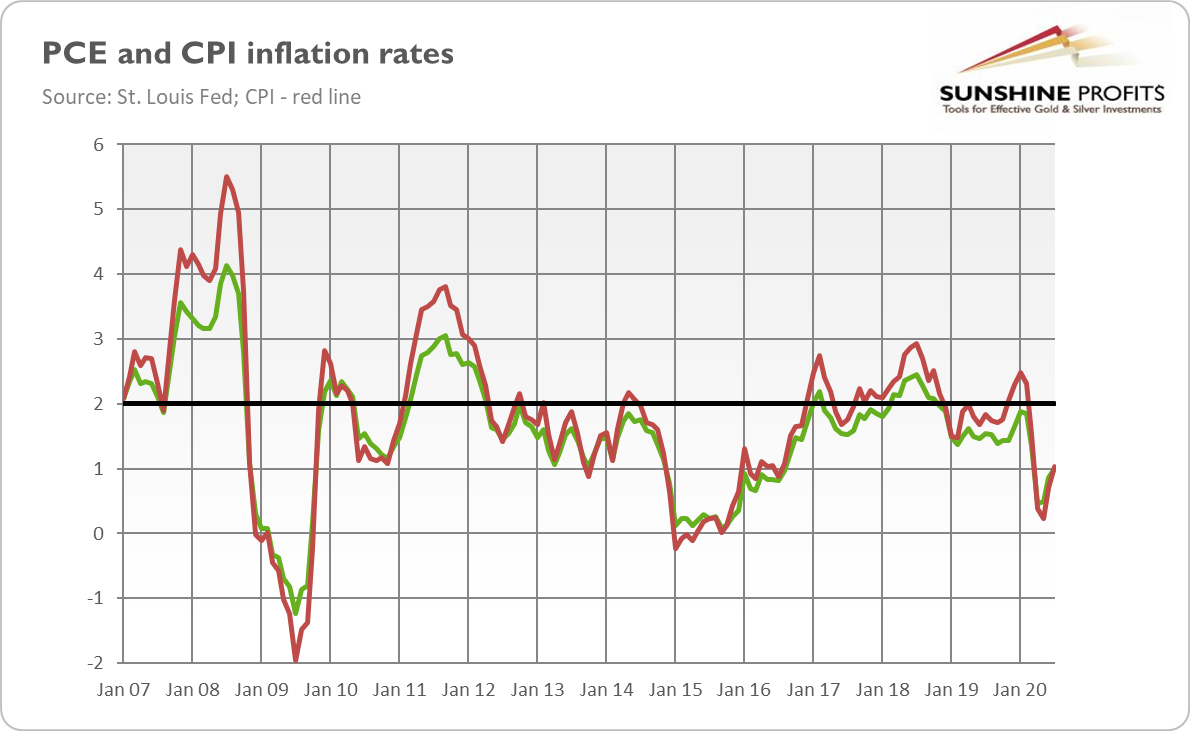
Hence, the Fed started to fear that it will lose control of inflation expectations which had recently declined (see the chart below). As Powell explained in his speech:
The persistent undershoot of inflation from our 2 percent longer-run objective is a cause for concern. Many find it counterintuitive that the Fed would want to push up inflation. After all, low and stable inflation is essential for a well-functioning economy. And we are certainly mindful that higher prices for essential items, such as food, gasoline, and shelter, add to the burdens faced by many families, especially those struggling with lost jobs and incomes. However, inflation that is persistently too low can pose serious risks to the economy. Inflation that runs below its desired level can lead to an unwelcome fall in longer-term inflation expectations, which, in turn, can pull actual inflation even lower, resulting in an adverse cycle of ever-lower inflation and inflation expectations.
This dynamic is a problem because expected inflation feeds directly into the general level of interest rates. Well-anchored inflation expectations are critical for giving the Fed the latitude to support employment when necessary without destabilizing inflation.18 But if inflation expectations fall below our 2 percent objective, interest rates would decline in tandem. In turn, we would have less scope to cut interest rates to boost employment during an economic downturn, further diminishing our capacity to stabilize the economy through cutting interest rates. We have seen this adverse dynamic play out in other major economies around the world and have learned that once it sets in, it can be very difficult to overcome. We want to do what we can to prevent such a dynamic from happening here.
Thus, the new framework could be viewed as a way to raise inflation expectations and regain control of them by the American central bank.
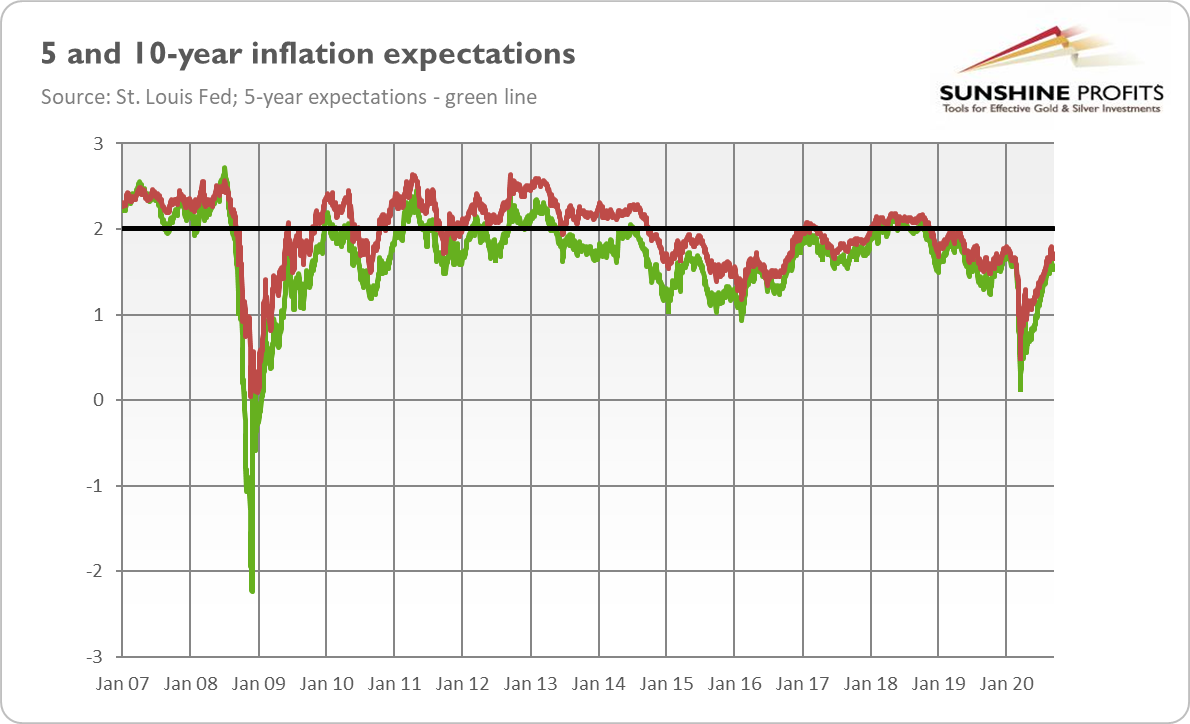
The shift to the FAIT is a big move that should be positive in the long run for gold, which is considered an inflation hedge. But, perhaps even more important is the change within the employment side of the Fed's mandate. Under the previous strategy, the maximum employment goal referred to the natural rate of unemployment that would be consistent with stable inflation in the long run. When the Fed expected the unemployment rate to fall below its estimate of the rate of unemployment that would not accelerate inflation, it raised the federal funds rate to prevent the increase in inflation. Under the new regime, the Fed will not hike interest rates preemptively and unless there are visible signs of accelerating inflation. It means that the FOMC will prioritize employment and economic growth over inflation and will not impede recoveries unless the inflation target is severely threatened.
Hence, both major revisions - in the inflation and employment objectives - are fundamentally positive for the gold prices. It does not, however, mean that we will immediately see double-digit inflation. After all, the Fed could not generate inflation in line with the target, so why it should boost it above the target, even temporarily?
But the US central bank has given itself room to loosen its monetary policy for years. The interest rates will remain close to zero for longer than it would be appropriate under the old regime, as the Fed will not try any longer raise interest rates to preempt inflation. In other words, the central bank is not likely to hike the federal funds rate until inflation is above 2 percent for some time - according to the recent Fed's dot-plot, this is not going to happen before 2024. Hence, the Fed's new framework implies lower real interest rates - is good news for the precious metals investors.
And the risk of inflation getting out of control should also support the gold prices. After all, as former Fed Chair William McChesney Martin Jr. said, "the effective time to act against inflationary pressures is when they are in the development stage--before they have become full-blown and the damage has been done". It seems that the Fed has forgotten this truth. Well, those who cannot remember the past are condemned to repeat it. Although this statement has negative connotations, I believe that gold bulls would like to relive the 1970s!
-
Will the Bomb Explode, Igniting Gold?
September 29, 2020, 9:24 AMThe bomb can explode one day. And I do not mean here missiles from North Korea, Iran or China. Neither I think about the viral threat - the coronavirus bomb has already blown up in spring, dragging the world into deep economic crisis. I have in mind the U.S. debt bomb. Just take a look at the chart below. As one can see, the public debt has reached 107 percent of the GDP even before the pandemic.
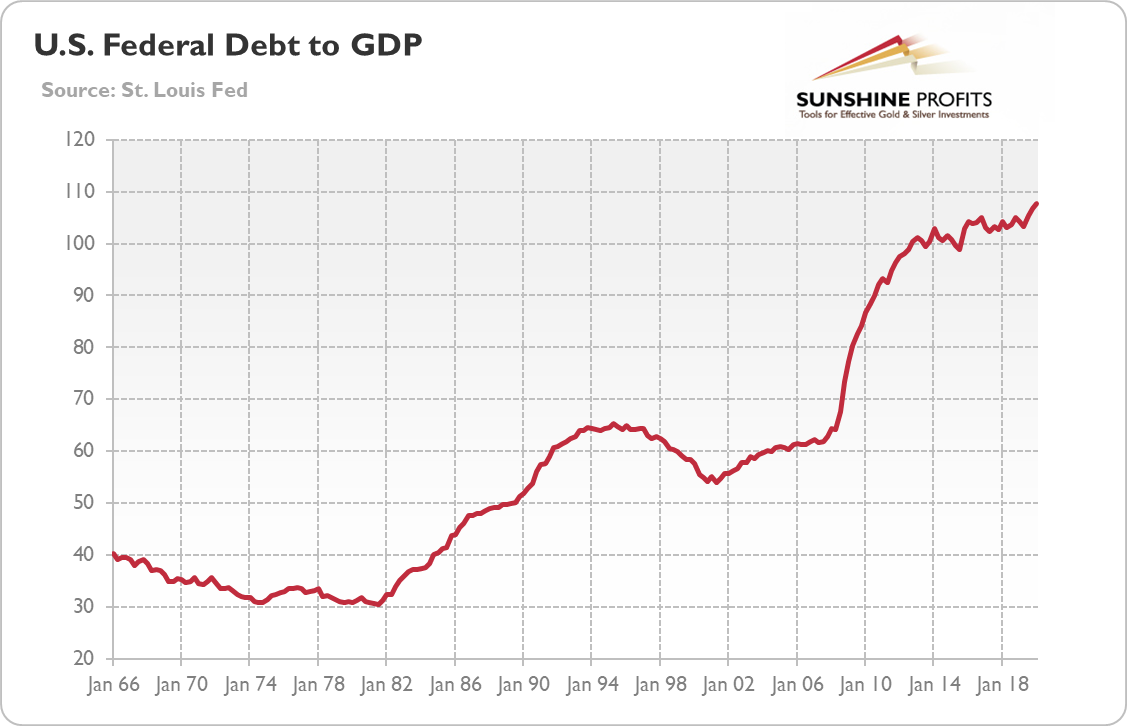
And it further increased in the second quarter of 2020, possibly even to around 137 percent, according to the U.S. National Debt Clock. Although the surge in the ratio of debt-to-GDP partially resulted from the unprecedented collapse in the economic activity triggered by the epidemic and the Great Lockdown, it was also driven by the vast additional government expenditures. As revenues declined, the fiscal deficit is expected to balloon from $984 billion, or 4.6 percent of GDP, in fiscal year of 2019, to $3.7 trillion, or 17.9 percent of GDP in 2020, according to the CBO. In consequence, the already high public debt is forecasted to increase even more. And Fitch has already downgraded its outlook on the U.S. debt from stable to negative.
Some economists claim that government stimulus financed by debt was necessary given the disastrous economic effects of the coronavirus crisis. Maybe it was, maybe not (we believe that increased spending on health should be accompanied by spending cuts in other areas) - but one thing is certain. When the battle with Covid-19 will be won (and it will be!), the policymakers will need to detonate the debt bomb.
There are a few ways to do it. The first is obvious and the less harmful one in the long-run. The government could reduce its excessive spending and, thus, fiscal deficits, stabilizing the ratio of debt to the GDP. Unfortunately, it is the most difficult option from the political point of view, especially when both Trump and Democrats talk about the need of more economic stimulus and higher spending on infrastructure.
Second, the government could hike taxes to raise more revenues, filling the budget hole. Trump is unlikely to raise taxes, but if Biden wins, higher taxes for the richest are possible. Although they would reduce the fiscal deficits, hiking taxes, especially in the aftermath of the recession, would be harmful for the economic growth.
All this means that policymakers will be tempted to reduce the public debt through either higher inflation or financial repression. Both ways are supportive for the gold prices.
Let's start with inflation. Gold is believed to be an inflation hedge, so the increase in inflation - or mere inflation expectations - would increase the demand for gold and its price. Moreover, higher inflation means lower real interest rates - which would also make the yellow metal shine. So, attempts to inflate away the debt would weaken the greenback, lower the already ultra-low real bond yields, and support the gold prices.
Financial repression is maybe less spectacular but also positive for the yellow metal. It works as follows: the government caps the interest rates that financial institutions are allowed to pay. The idea is simple: thanks to the financial repression, government can borrow cheaper than it could otherwise because people simply are not allowed to get better returns elsewhere. This method wouldn't be unprecedented, as it was used to reduce the high public debt after World War II.
Oh, by the way, the interest-rate ceilings were lower than the rate of inflation, so creditors received negative returns in real terms. It goes without saying that gold should shine during financial repression. After all, the argument that gold doesn't pay interest would be less convincing in the world where other assets offer scant yields or even negative returns in real terms.
Yield curve control contemplated by the Fed would be that kind of financial repression, as it would also aim to keep the Treasury yields at sufficiently low level to reduce the debt-to-GDP ratio over time. If implemented - so far the U.S. central bank has not endorsed the idea - it would maintain ultra-low interest rates with all their negative consequences, such as: the prevalence of zombie companies and misallocation of capital, the search for yield and excessive risk-taking, the rise in private indebtedness, etc.
Moreover, the ultra-low interest rates could lead to capital outflows, which would weaken the U.S. dollar, while strengthening gold. Last but not least, the pledge to keep interest rates at very low level could require the Fed to let inflation turn hot, which would also support the gold prices.
To sum up, high public debt will be one of the most significant legacies of the coronavirus crisis. The efforts to reduce it will become an important element of the political debate in the upcoming years, as policymakers will realize - sooner or later - that they are sitting on a ticking time bomb. It seems that financial repression will be the preferred method of reducing the high debt-to-GDP ratio, dominating the investment outlook in coming years. Precious metals investors holding gold should benefit from negative real interest rates.
Thank you for reading today's free analysis. If you enjoyed it, and would you like to know more about the links between the economic outlook, the current (past?) crisis and the gold market, we invite you to read the September Gold Market Overview report. Please note that in addition to the above-mentioned free fundamental gold reports, and we provide premium daily Gold & Silver Trading Alerts with clear buy and sell signals. We provide these premium analyses also on a weekly basis in the form of Gold Investment Updates. In order to enjoy our gold analyses in their full scope, we invite you to subscribe today. If you're not ready to subscribe yet though and are not on our gold mailing list yet, we urge you to sign up. It's free and if you don't like it, you can easily unsubscribe. Sign up today!
Arkadiusz Sieron, PhD
Sunshine Profits: Analysis. Care. Profits.-----
Disclaimer: Please note that the aim of the above analysis is to discuss the likely long-term impact of the featured phenomenon on the price of gold and this analysis does not indicate (nor does it aim to do so) whether gold is likely to move higher or lower in the short- or medium term. In order to determine the latter, many additional factors need to be considered (i.e. sentiment, chart patterns, cycles, indicators, ratios, self-similar patterns and more) and we are taking them into account (and discussing the short- and medium-term outlook) in our Gold & Silver Trading Alerts.
-
Gold, Dollar and Rates: A Correlated Story
September 23, 2020, 8:49 AMMining production? No. China's consumer demand? No. The main drivers of gold prices are, as I've repeated many times, the U.S. dollar and real interest rates. You don't believe it? You don't have to - just look at the charts below.
The first one displays the greenback and the dollar-denominated price of gold. Because other series start much later, I used here the Trade Weighted U.S. Dollar Index against major currencies that circulate widely outside the country of issuance. Although the correlation is not perfect, the inverse relationship is quite strong and bull and bear markets in gold coincide with the bear and bull trends in the U.S. dollar.
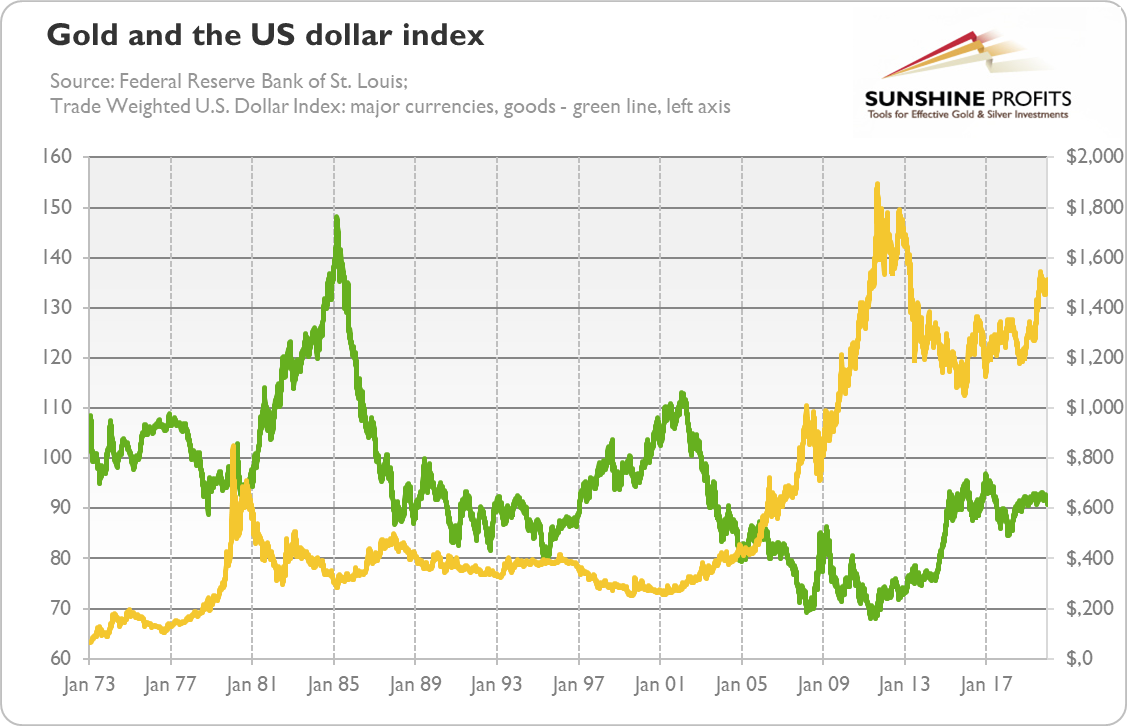
The second chart presents the U.S. real interest rates and the price of gold (London Gold Fix). As the data series for the yields of inflation-indexed Treasuries (which I treat a proxy for real rates) start only in 2003, I use here nominal bond yields adjusted for the CPI. Again, the negative relationship between displayed variables is far from being perfect (actually it is only -0.31), but it is clear that gold rallied the most when the real interest rates were negative.
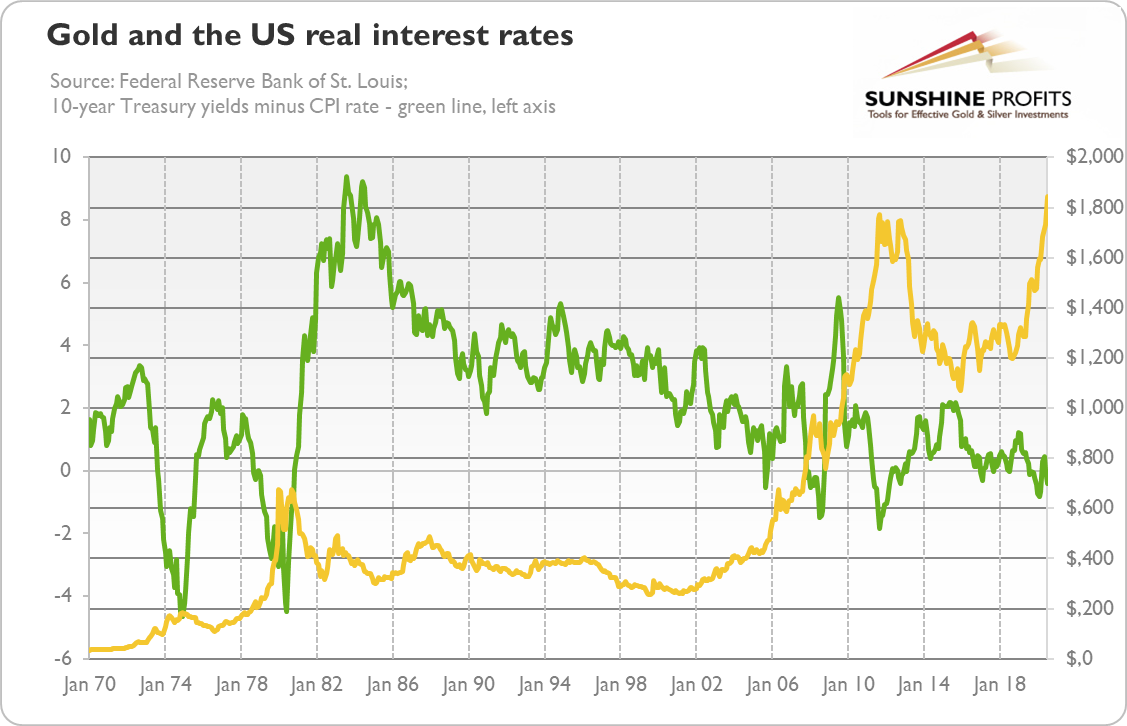
Now, let's zoom in and use more recent data. The chart below shows the price of gold and Trade Weighted U.S. Dollar Index against the broad basket of currencies. As the two lines looks like their mirror images, the inverse relationship between the yellow metal and greenback becomes even clearer now.
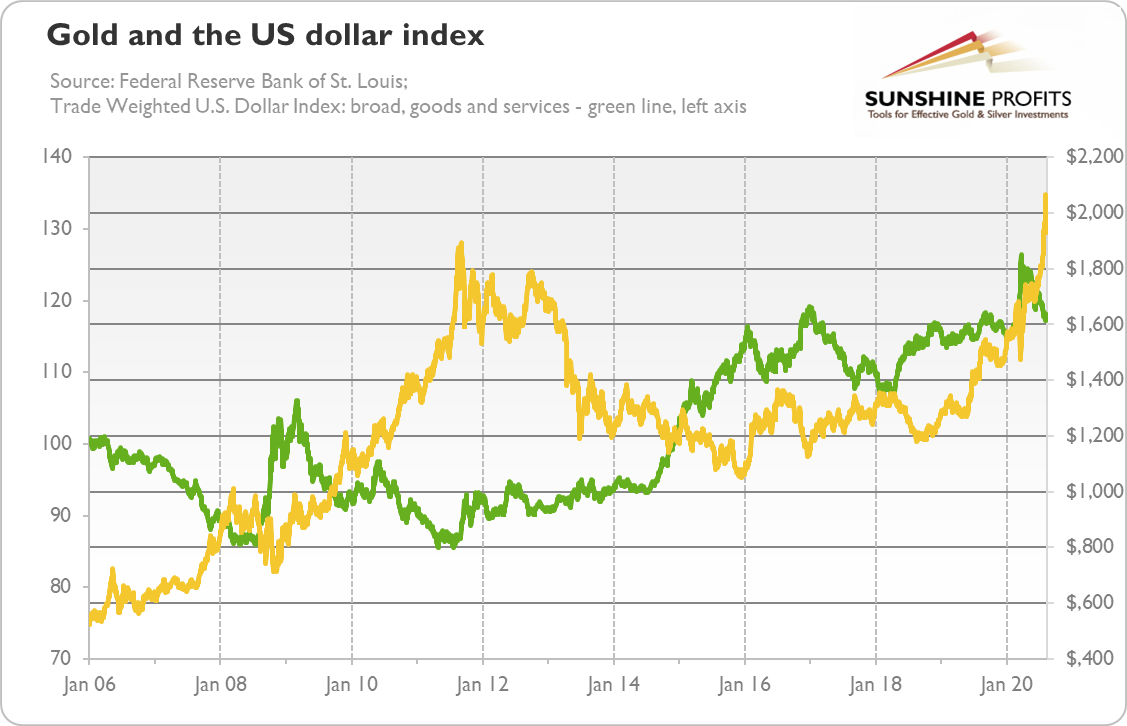
Or... does it really? The correlation coefficient is 0.26, so the relationship was positive in the analyzed period! Never trust your eyes, only numbers are real! As one can see in the chart below, the 100-day rolling correlation between gold and the U.S. dollar is quite volatile. Which is not so surprising, when we realize that both the yellow metal and the greenback can serve as safe-haven assets during economic crises. However, the correlation has become more negative recently.
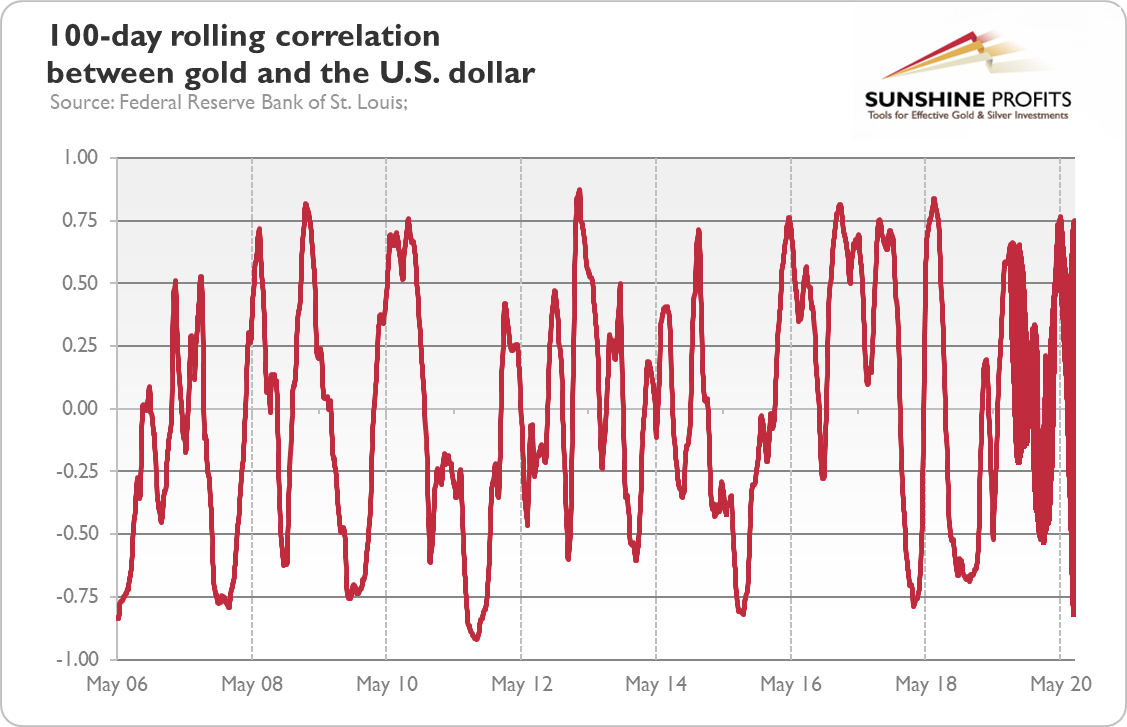
Similarly, the next chart zooms in on the relationship between gold and real interest rates, using more recent data and yields of TIPS. Again, the inverse, mirror relationship between both variables becomes more than clear. It is obvious at first sight, without any quantitative analyses.
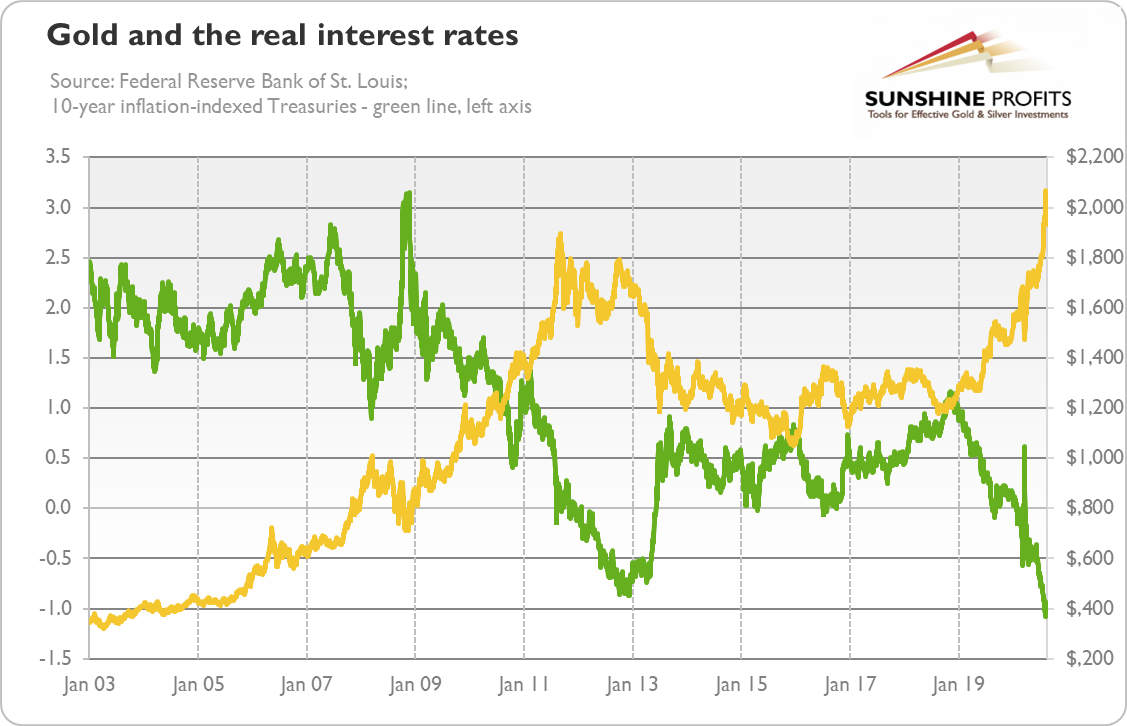
But never stop at the first impression! The correlation coefficient is -0.85, so it is indeed very strong negative correlation. And in the past 100 days, it was even stronger (-0.95), as the chart below shows. As one can see, correlation is not fixed but it is constantly changing. And gold has become recently even more sensitive to changes in the real interest rates.
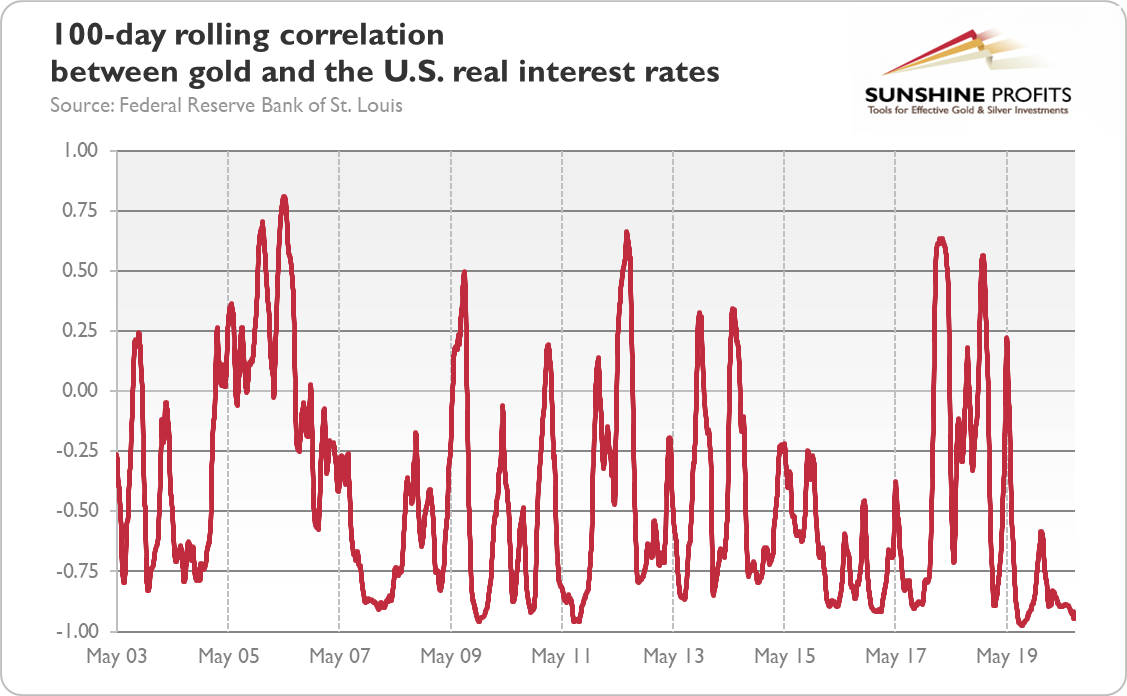
What does it all mean for the gold market? Well, as I have repeated many times, the strong relationships with U.S. dollar and real interest rates stem from the fact that gold is not merely a commodity, but it is a monetary asset. Of course, the international price of gold is quoted in the dollar, so when the value of the greenback increases (decreases) relative to other currencies around the world, the price of gold tends to fall (rise) in the U.S. dollar. However, there is something more to the story. Gold is seen as another currency, or a bet against the greenback and other fiat currencies, so during times of fear, the price of the yellow metal tends to rise as confidence in the Fed (and other central banks), the U.S. government and the current monetary system fails.
The real interest rates are connected, of course, with the exchange rates. The lower the rates, the weaker the currency is. So, low interest rates tend to weaken the greenback, which also supports gold. Moreover, because the yellow metal does not bear any yield, the low rates reduce the opportunity costs of holding gold compared to other assets. And TIPS are used as protection against inflation, just as gold, so they move together.
Question: what about when the rates are low, or even negative? When either inflation is high, or when nominal interest rates are close to zero. Both cases mean that economic situation is grave or even that central banks have lost control, which drives investors toward gold.
Now, the real interest rates are at very low level, so there is a risk of a rebound. However, they were even lower during the 1970s, so the reversal is not certain, especially that the Fed is not even thinking about thinking about hiking the federal funds rate. So, although the U.S. central bank distanced itself somewhat from the idea of yield curve control, the interest rates are likely to remain ultra low for the foreseeable future. Which is great news for gold.
When it comes to the U.S. dollar, we see that it has peaked recently. It can go, of course, further north, but the current environment of the dovish Fed, negative real interest rates, narrowing divergence between monetary policies conducted by the U.S. and other countries, and soaring fiscal deficits and federal debt are important headwinds for the greenback. We know that other central banks and governments are not much better than their American counterparts, but it seems that more and more people are starting to worry about the soundness of the U.S. dollar (although the greenback, together with gold, still behaves like the safe haven during economic crises). So, more investors could be interested in buying gold, the ultimate currency.
Thank you for reading today's free analysis. If you enjoyed it, and would you like to know more about the links between the economic outlook, the current (past?) crisis and the gold market, we invite you to read the September Gold Market Overview report. Please note that in addition to the above-mentioned free fundamental gold reports, and we provide premium daily Gold & Silver Trading Alerts with clear buy and sell signals. We provide these premium analyses also on a weekly basis in the form of Gold Investment Updates. In order to enjoy our gold analyses in their full scope, we invite you to subscribe today. If you're not ready to subscribe yet though and are not on our gold mailing list yet, we urge you to sign up. It's free and if you don't like it, you can easily unsubscribe. Sign up today!
Arkadiusz Sieron, PhD
Sunshine Profits: Analysis. Care. Profits.-----
Disclaimer: Please note that the aim of the above analysis is to discuss the likely long-term impact of the featured phenomenon on the price of gold and this analysis does not indicate (nor does it aim to do so) whether gold is likely to move higher or lower in the short- or medium term. In order to determine the latter, many additional factors need to be considered (i.e. sentiment, chart patterns, cycles, indicators, ratios, self-similar patterns and more) and we are taking them into account (and discussing the short- and medium-term outlook) in our Gold & Silver Trading Alerts.
-
Gold Reaches $2,000 Amid Dollar Depreciation
September 11, 2020, 8:55 AM$2,000. Think about this number. Theoretically, it's just a number, one of many. But... somehow we feel that jumping above this level was a big event in the gold market. After all, gold surpassed this psychologically important point for the first time in history, reaching record high, as the chart below shows.
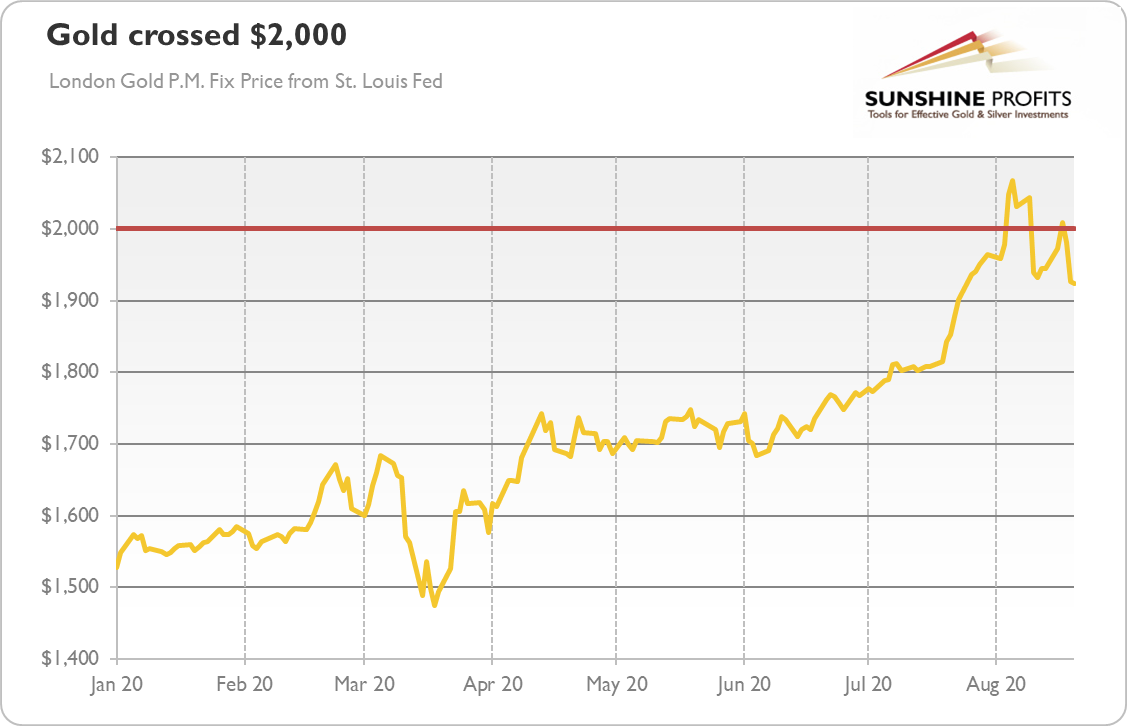
How did gold manage to achieve it? The obvious reason is the coronavirus crisis and its economic consequences. But let's be more specific. The first driver was the elevated risk perception spurred by the pandemic and the Great Lockdown, which increased the safe-haven demand for gold.
The second explanation is the Fed's easy monetary policy. It's true that inflation remains low, but investors should remember that rising goods prices are not the only sign of easy money. The ultra low real interest rates, ballooned Fed's balance sheet with the broad money supply as well, and elevated equity prices - all these factors reflected the Fed's ultra dovish stance, and boosted the gold prices.
The third reason is the dollar's depreciation. As one can see in the chart below, the greenback lost more than 7 percent in value since its March high, reversing a safe-haven rally amid coronavirus crisis.
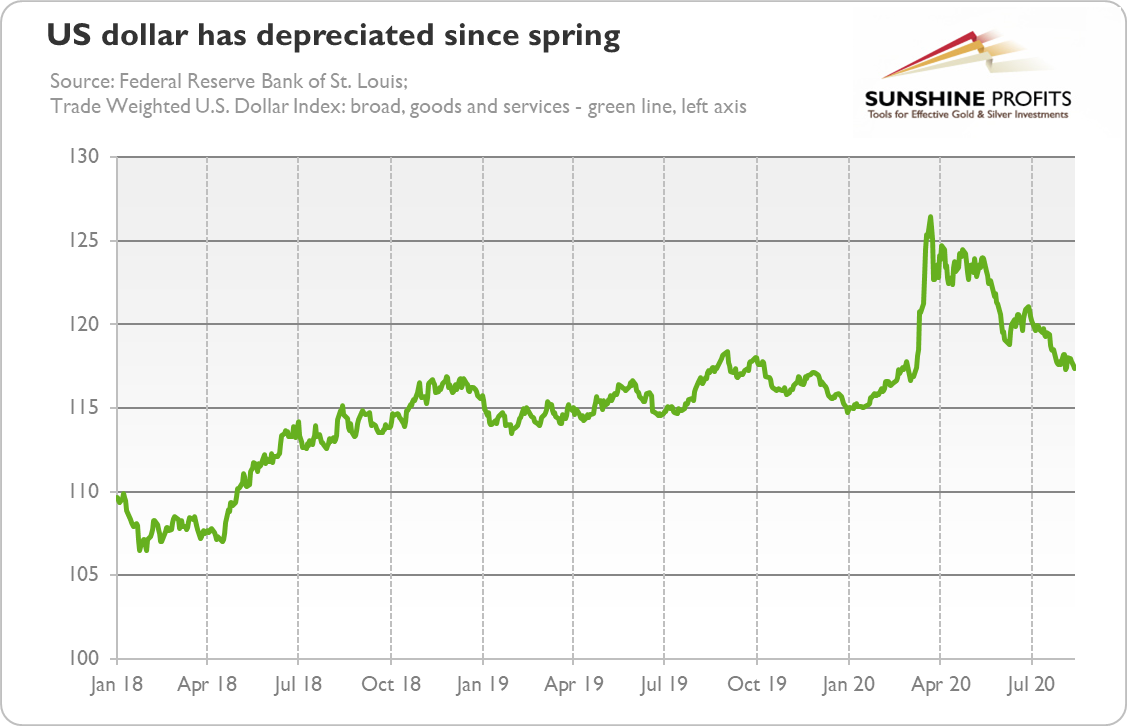
Although the weakening of the U.S. dollar partially reflected the Fed's accommodative stance and the increase in the risk appetite, we should not forget about investors' growing demand for a safe-haven alternative to the dollar. I mean here that the loss of confidence in the U.S. government, Trump's weaponization of the greenback, and trade wars inclined many investors to diversify their investment portfolios. As there is no sensible alternative among other major fiat currencies, some people could switch to gold.
To be clear, I'm not writing about the demise of the U.S. dollar's, as the reports about its fall are, as always, greatly exaggerated. I'm analyzing here the economic reasons behind the greenback's sharp depreciation - in order to draw investment conclusions for precious metals investors.
First, the dollar tends to weaken during risk-on episodes, so when market sentiment improved after the worst phase of the coronavirus crisis, the greenback simply corrected after previous gains. Second, the U.S. central bank eased its monetary stance in the response to the economic collapse, slashing interest rates. The lower yields accrued to the dollar-denominated bonds narrowed the divergence in interest rates across the Atlantic (see the chart below), which reduced capital inflows into America and triggered a shift in holdings in favor of other markets.
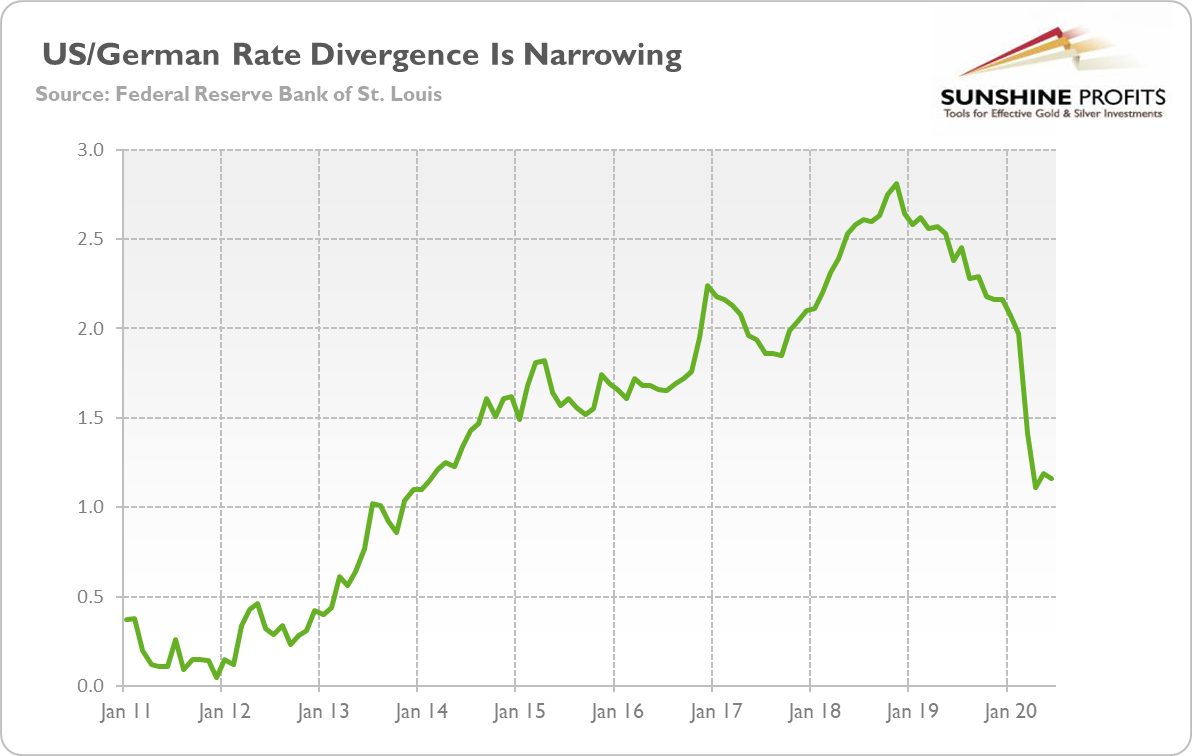
Third, the U.S. did a poor job in containing the coronavirus compared to other developed countries, which worsened its economic outlook and made investors expect ultra low interest rates kept by the Fed for longer. Fourth, the U.S. central bank added massive liquidity into financial markets and activated currency swaps with other central banks, increasing the supply of greenbacks. Fifth, the Fed is effectively monetizing massive fiscal deficits, which also leads to large external deficits.
So, what's next for the dollar and gold? Well, with improving health and economic situation in the U.S., the downward pressure on the greenback should weaken. On the other hand, the adopted ultra dovish stance makes the Fed similar to the ECB and the Bank of Japan, which should maintain the downward pressure on the dollar. In other words, it seems that the U.S. dollar could rally again only if there is another risk-off moment, such as the second wave of infections in Europe or the financial crisis. But gold should move in tandem with the greenback, then.
Summing up, gold has recently jumped above the psychologically important level of $2,000, while the U.S. dollar depreciated sharply. Some analysts link these two events and claim that the gold's rally was caused by the dollar's depreciation. Although it certainly helped, please note that the greenback lost just about 7 percent, while gold gained about 40 percent since spring. So, it seems that in the current environment of very dovish Fed, ultra low real interest rates, and high public debt, gold can shine even without serious weakness in the dollar.
That's great - but even greater is the fact that it is likely that the greenback started a cyclical decline in spring amid the banana-republic-style money creation and debt monetization by the Fed. There could be a rebound in the short-term (for example, because of negative economic data out of the Eurozone economy), but I wouldn't be surprised if the U.S. dollar would be next year below the current levels. It goes without saying that gold would benefit from further potential depreciation of the greenback.
Thank you for reading today's free analysis. If you enjoyed it, and would you like to know more about the links between the economic outlook, the current (past?) crisis and the gold market, we invite you to read the September Gold Market Overview report. Please note that in addition to the above-mentioned free fundamental gold reports, and we provide premium daily Gold & Silver Trading Alerts with clear buy and sell signals. We provide these premium analyses also on a weekly basis in the form of Gold Investment Updates. In order to enjoy our gold analyses in their full scope, we invite you to subscribe today. If you're not ready to subscribe yet though and are not on our gold mailing list yet, we urge you to sign up. It's free and if you don't like it, you can easily unsubscribe. Sign up today!
Arkadiusz Sieron, PhD
Sunshine Profits: Analysis. Care. Profits.-----
Disclaimer: Please note that the aim of the above analysis is to discuss the likely long-term impact of the featured phenomenon on the price of gold and this analysis does not indicate (nor does it aim to do so) whether gold is likely to move higher or lower in the short- or medium term. In order to determine the latter, many additional factors need to be considered (i.e. sentiment, chart patterns, cycles, indicators, ratios, self-similar patterns and more) and we are taking them into account (and discussing the short- and medium-term outlook) in our Gold & Silver Trading Alerts.
-
Gold Bull Markets: History and Prospects Ahead
September 4, 2020, 6:19 AMWould you like to know one simple way of achieving investment successes and getting rich? That's great, I will reveal this secret to you - and you even don't have to click anything! The trick is to find a bull market and go long! And, what a coincidence, gold is right now in the bull market... If you don't believe, then look at the chart below.
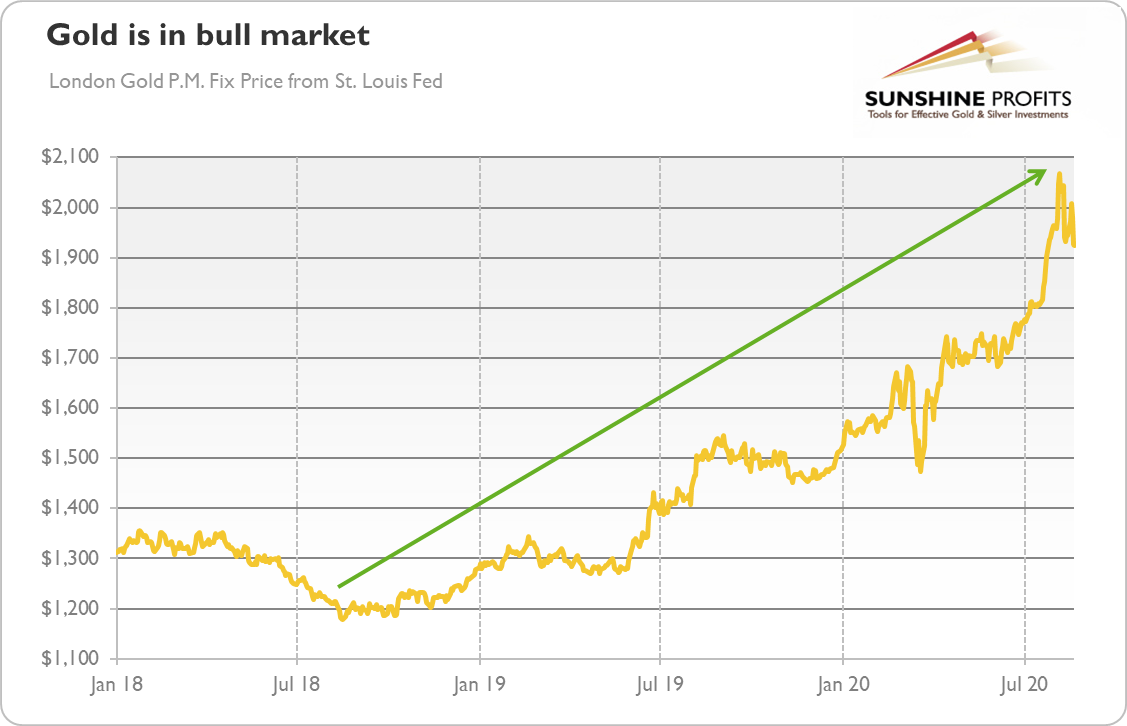
If the chart does not present the bull market then I have no idea either what it presents or what is the bull market. As you can see, gold gained about $800, or two thirds, since the autumn of 2018, which seems to be quite bullish!
Of course, you can argue that the bull market started earlier, in December 2015, when the price of the yellow metal reached the bottom of $1,049, as the chart below shows. You would be theoretically right, but from the practical point of view, gold entered a sideways trend until late 2018, and since then (and since surpassing the upside barrier of $1,400 in mid-2019) the trend has been clearly rising.
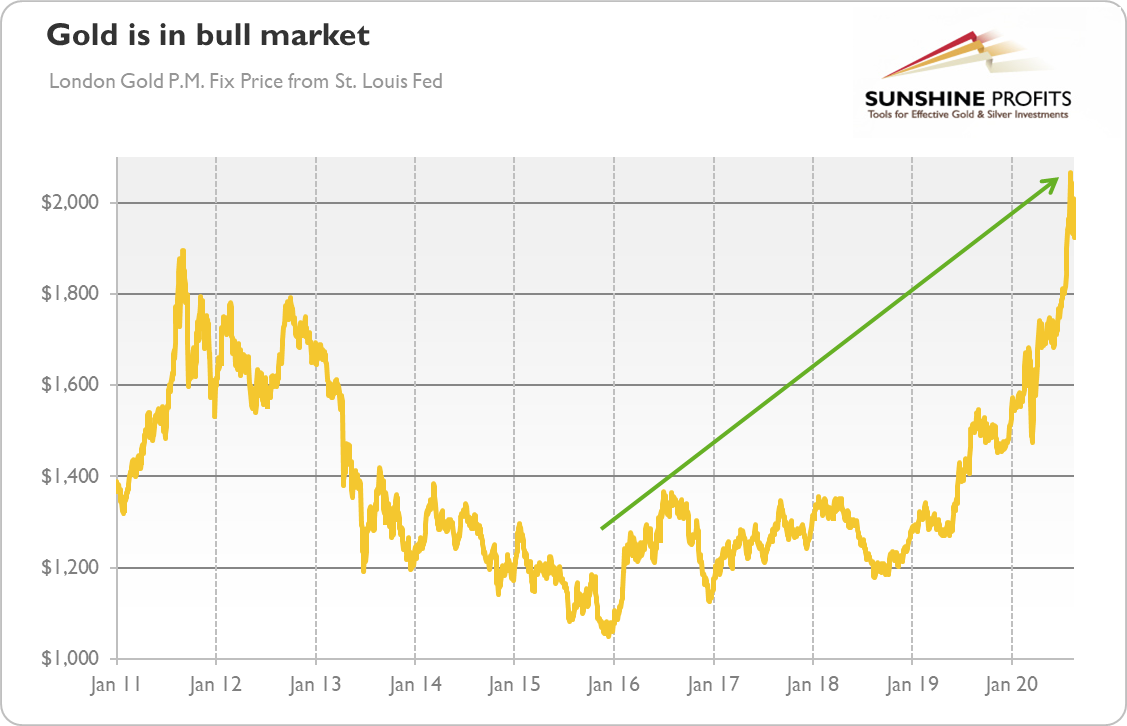
And in July 2020, the price of gold has surpassed its previous record high, strengthening the bullish case for gold. Now, the question is not whether we are in the bull market, but what will this bull market be like, how long is it going to last, and what level will gold reach?
Although the sample is terribly small, it's always good to look at previous bull markets in gold. The first one occurred in the 1970s, when President Nixon ended the gold standard, while fiscal deficits and inflation moved out of control. In consequence, as one can see in the chart below, the price of gold skyrocketed from about $35 to $850, or more than 2,300 percent!
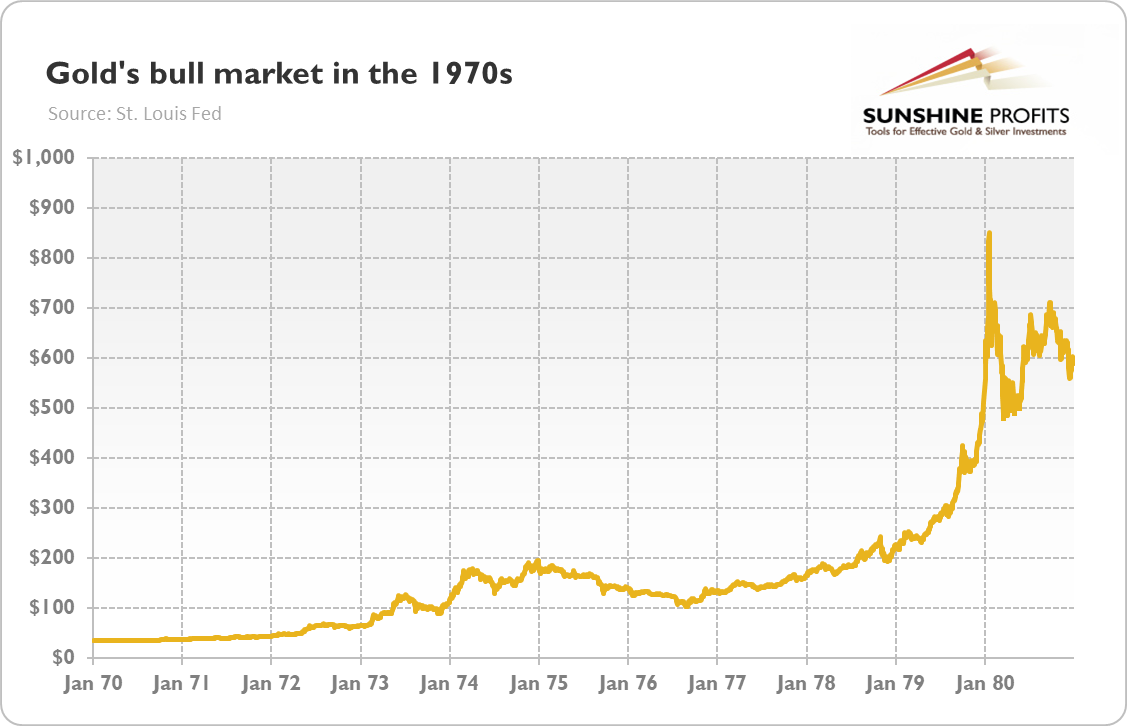
The second gold's bull market happened in the 2000s, when President Bush's policies weakened the U.S. dollar, while the Great Recession and the introduced quantitative easing in response scarred investors and spurred inflation expectations. As the chart below shows, the price of gold soared from about $255 to $1,895, or more than 640 percent!
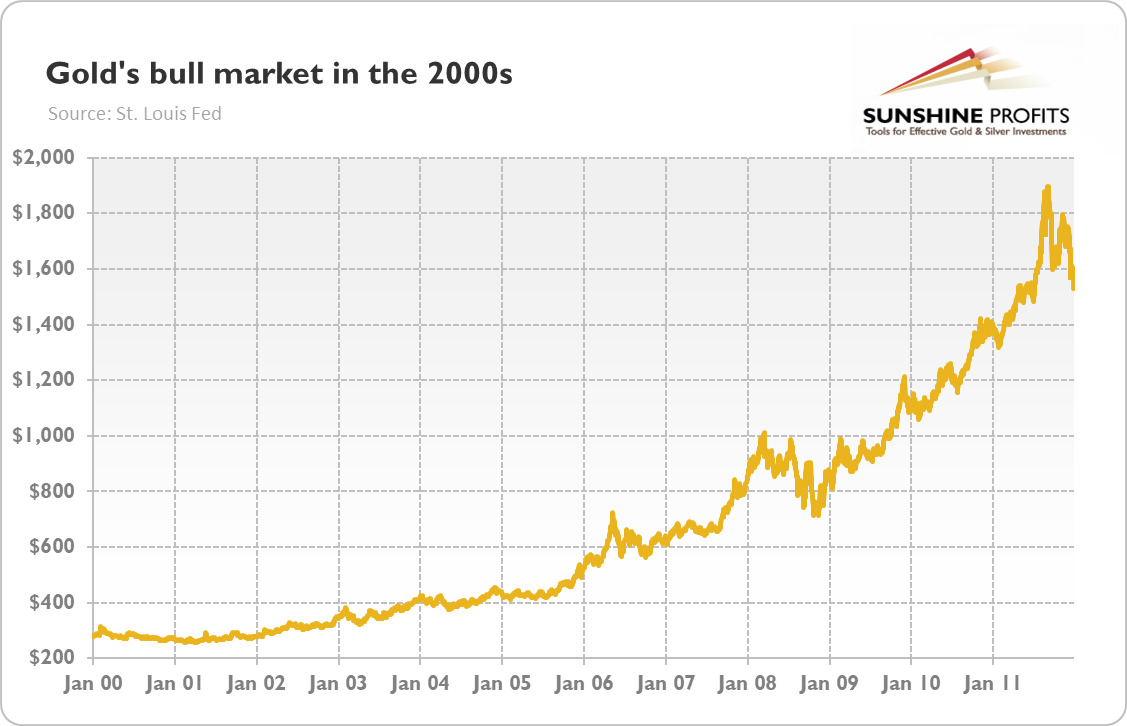
What does this brief analysis imply for gold? Well, so far gold gained about 85 percent since the bottom, so there is room for further gains. Of course, it's highly unlikely that gold will skyrocket as strongly as in the 1970s, because its price was much lower and the current international monetary system was in its infancy after the end of the Breton Woods and the closure of the gold window. Neither the gains similar to those from the 2000s are probable, as the unconventional monetary policy with quantitative easing has become totally conventional monetary policy, which does not trigger such worries as back then.
But there is definitely more upside potential for gold. Remember that previous bull markets lasted for a decade each. Even if we accept December 2015, instead of late 2018, as the starting point of the current bull market, there are still a few bullish years ahead of us.
What else can we learn from the previous bull markets? First, let's take a look at the charts above once again. As you can see, gold started timidly each time, then it accelerated, just to soar at the very end of each phase of the bull market. If history repeats, we are in a correction period and gold will not rally further unless it consolidates somewhat.
And this is another lesson: bull markets are never linear, but they consist of ups and downs, as the recent correction clearly shows. Just as the gold market in general, as the chart below presents.
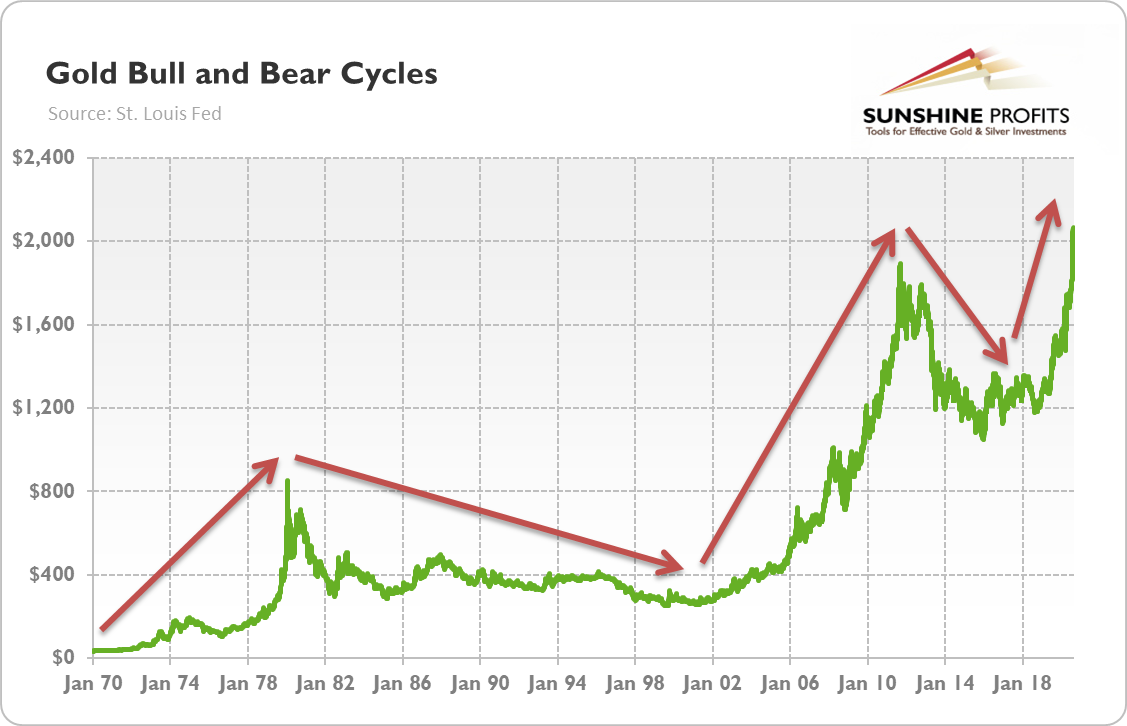
Second, there are many similarities between previous bull markets and the current one. In particular, the fiscal policy is lax and budget deficits are ballooning, while the money supply is soaring. The Fed's balance sheet skyrocketed. The only component of former gold's bull markets we lack, is the secular bear market in the U.S. dollar. But given the massive government spending, high level of federal debt, and the policy of zero interest rates, this can change at some point, if it hasn't changed already...
Third, the new decade we are entering, could be more similar to the 1970s than to the 2000s. We mean here the fact that the current economic crisis is already less deflationary and more inflationary than the global financial crisis. Inflation is low, but it is positive. Meanwhile, interest rates are below the inflation rate, which implies negative real interest rates, the rocket fuel for gold.
-
U.S. Presidential Elections Are Coming: Should We Vote for Gold?
August 28, 2020, 5:13 AMOver the past few months, we have focused - for obvious reasons - on the pandemic and the following economic crisis. However, there are also other important developments happening in the background, apart from media attention that still focuses on the coronavirus. As they can substantially affect the gold prices, precious metals investors should be aware of them.
One of the most important of such issues is the U.S. presidential election that is approaching fast. And the polls suggest that we could see the change of the President in the White House. As the chart below shows, Joe Biden (blue line) has an average polling margin of 9 percent over incumbent President Donald Trump (red line).
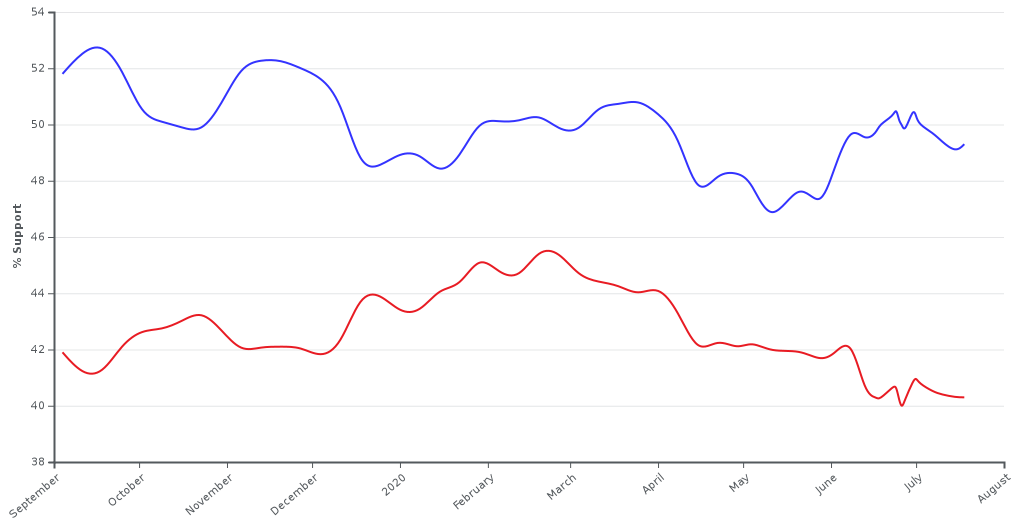
Will Biden win? That's a great question. Polls say so, but who trusts polls these days? We believe that it is certainly possible, given that some voters could be dissatisfied with Trump administration's handling of the epidemic, and especially if the second wave of the coronavirus is not contained quickly and the double-dip recession arrives. Trump could share then the fate of George H.W. Bush, who lost to Bill Clinton amid the early 1990s recession following jobless recovery. However, if the economy improves, the race could tighten between now and election day.
What would President Biden imply for the US economy and the gold market? Well, although I don't support Trump's trade policy, I'm neither impressed with Biden's economic agenda. Under his economic revival plan, the federal government would spend $700 billion on research and development for new technologies and energy initiative and on American goods and services. What is key here is that Biden plans to pay for these and other programs by raising taxes "on corporations and the wealthy". In particular, he wants to hike the corporate tax rate from the current 21 to 28 percent. I can be wrong, but Wall Street would not welcome lifting taxes, especially during the fragile recovery from the economic crisis. So, the stock market could tank, if Biden wins.
But it does not have to... So far, investors are totally unfazed by the polls giving Biden higher chances. After all, still a lot can happen before November, so the markets can be waiting until the outcome of the presidential race looks more certain. It's also possible that investors expect that Biden would moderate his proposals after elections or that they focus more on other parts of Biden's agenda. For instance, Biden's trade policy is less protectionist than Trump's and he could end the trade wars with China (and other countries) that worried the markets so much last year.
Hence, the possible effect of Biden's triumph on equities and gold market is ambiguous. Theoretically, given that the stock market rallied, while the price of the yellow metal plunged, after Trump's victory in 2016 (see the chart below), we should expect the reverse if Trump loses.
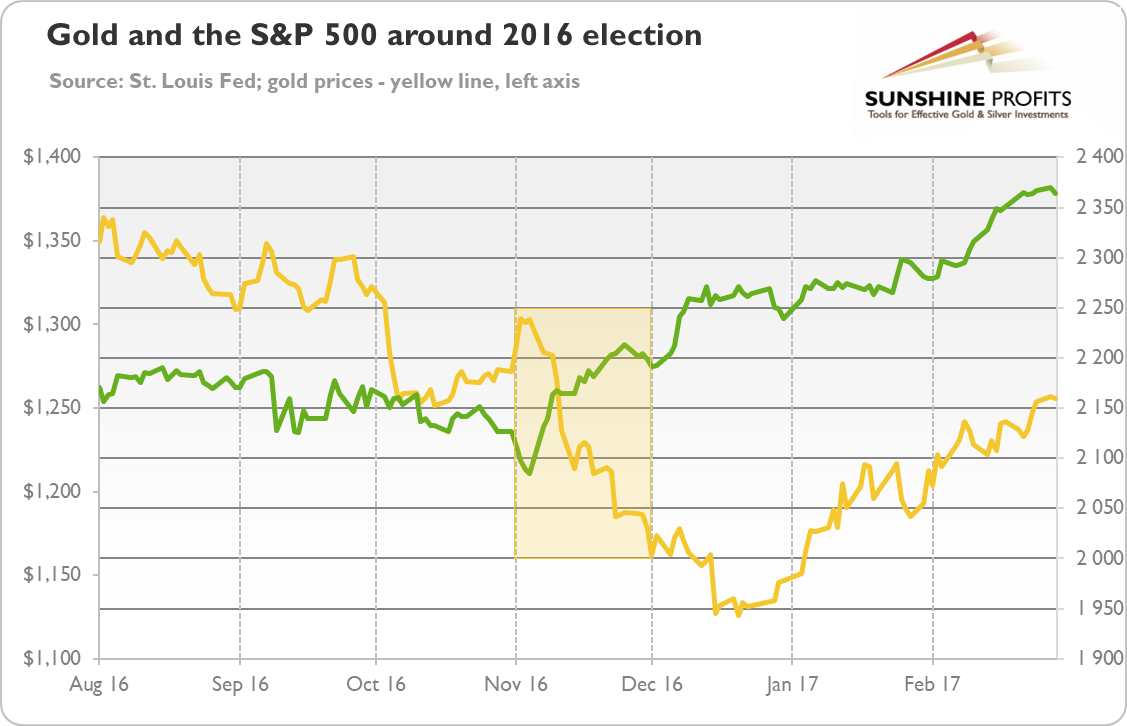
But it should be too simplistic reasoning and both the stock and gold market could easily interpret Biden's possible victory in a bullish manner, as investors tend to do during bull markets. Or, after an initial, short-term volatility, the underlying upward trends could resume. After all, Biden is generally acceptable to the investors. He is not as radical as Bernie Sanders or Elizabeth Warren. He is actually more mainstream in several aspects than Trump. And the financial markets managed to operate or even thrive under both Trump and Obama, whose vice-president was Biden.
In other words, no matter who will reside in the White House, the current macroeconomic conditions should remain generally favorably for the precious metals. We mean here the environment of the soaring fiscal deficits (according to the CBO, the federal budget deficit was $2.7 trillion in the first nine months of fiscal year 2020, $2.0 trillion more than the deficit recorded during the same period last year!) and federal debt (according to the IMF, general government debt is expected to rise to 160 percent of GDP by 2030 even without further rounds of fiscal stimulus!), as well as negative real interest rates, and the fastest pace of growth in the money supply in the modern history, as the chart below shows.
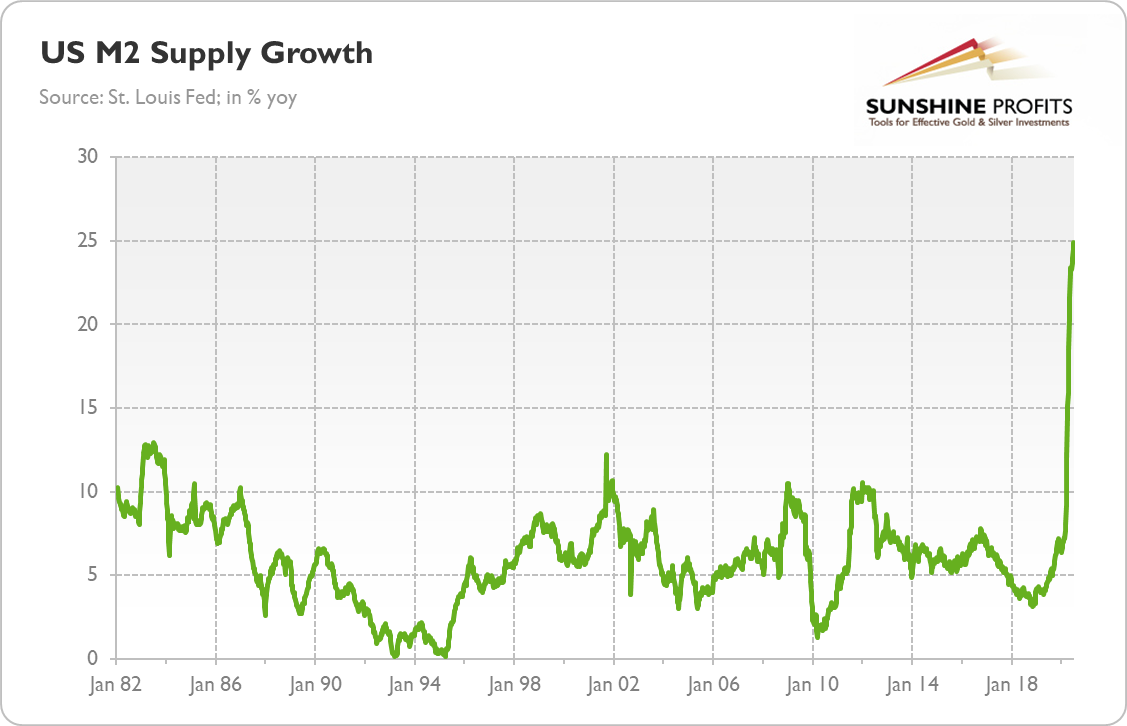
Moreover, no matter who wins, we do not expect radical changes in the accommodative fiscal and monetary policies, and the overall macroeconomic outlook, until the economy fully recovers from the coronavirus crisis. Investors should remember that although politics is important, what the Fed does is also, if not more, important for the stock and gold markets - and the U.S. central bank will not abandon its dovish bias, no matter who would reside in the White House. Neither Trump nor Biden would give up extravagant government spending and stimulus packages. If there is no difference, maybe we should vote for gold?
Thank you for reading today's free analysis. If you enjoyed it, and would you like to know more about the links between the economic outlook, the current (past?) crisis and the gold market, we invite you to read the August Gold Market Overview report. Please note that in addition to the above-mentioned free fundamental gold reports, and we provide premium daily Gold & Silver Trading Alerts with clear buy and sell signals. We provide these premium analyses also on a weekly basis in the form of Gold Investment Updates. In order to enjoy our gold analyses in their full scope, we invite you to subscribe today. If you're not ready to subscribe yet though and are not on our gold mailing list yet, we urge you to sign up. It's free and if you don't like it, you can easily unsubscribe. Sign up today!
Arkadiusz Sieron, PhD
Sunshine Profits: Analysis. Care. Profits.-----
Disclaimer: Please note that the aim of the above analysis is to discuss the likely long-term impact of the featured phenomenon on the price of gold and this analysis does not indicate (nor does it aim to do so) whether gold is likely to move higher or lower in the short- or medium term. In order to determine the latter, many additional factors need to be considered (i.e. sentiment, chart patterns, cycles, indicators, ratios, self-similar patterns and more) and we are taking them into account (and discussing the short- and medium-term outlook) in our Gold & Silver Trading Alerts.
-
Fed Can Control Yield Curve. But It Can't Control Gold
August 21, 2020, 4:40 AMIn a response to the coronavirus crisis, the Fed has already cut interest rates to zero and implemented quantitative easing. But that's not enough and the U.S. central bankers are now talking about "yield curve control". What is it and how it could affect the gold market?
Normally, the central banks lower the short-term interest rate to stimulate the economy. But the federal funds rate is already at zero, so the Fed now thinks about the yield curve control. It works basically like normal open-market operations - the only difference is that under the yield curve control, the Fed would target some longer-term interest rate. As the central bank would set the short-term rates at zero and it would target also longer-term rates, it would practically control the yield curve, which explains the name. Moreover, the Fed would also promise to buy enough bonds to keep the rate from moving above the target - this is why the yield curve control is also called "interest rate caps" or "interest rate pegs".
It might be useful to compare the yield curve control with the quantitative easing. While the latter deals with quantities or amounts of bonds (e.g., the Fed commits to buying bonds worth $1 trillion, but the market still influences the price), the former deals with bond prices. In other words, under the yield curve control, the central banks pledge to buy whatever amount of bonds the market wants to supply at the target price (instead of a particular amount of bonds at whatever the price).
Although central banks normally target short-term interest rates, the yield curve control would not be a new policy. It was already used by the Fed during and after the World War II, when it agreed to help Treasury in financing military expenditures and cap the Treasury yields by buying any Treasury bond that yielded above the target. In a more recent history, the Bank of Japan introduced its yield curve control in September 2016, pegging yields on 10-year Japanese Treasuries around zero percent. Interestingly, under the yield curve target, the BoJ has been buying government bonds at a slower pace than under the QE, as the chart below shows. This is because investors accepted that the BoJ would buy whatever quantity of bonds to keep yields from rising, so it has not had to buy too many of them to set price.
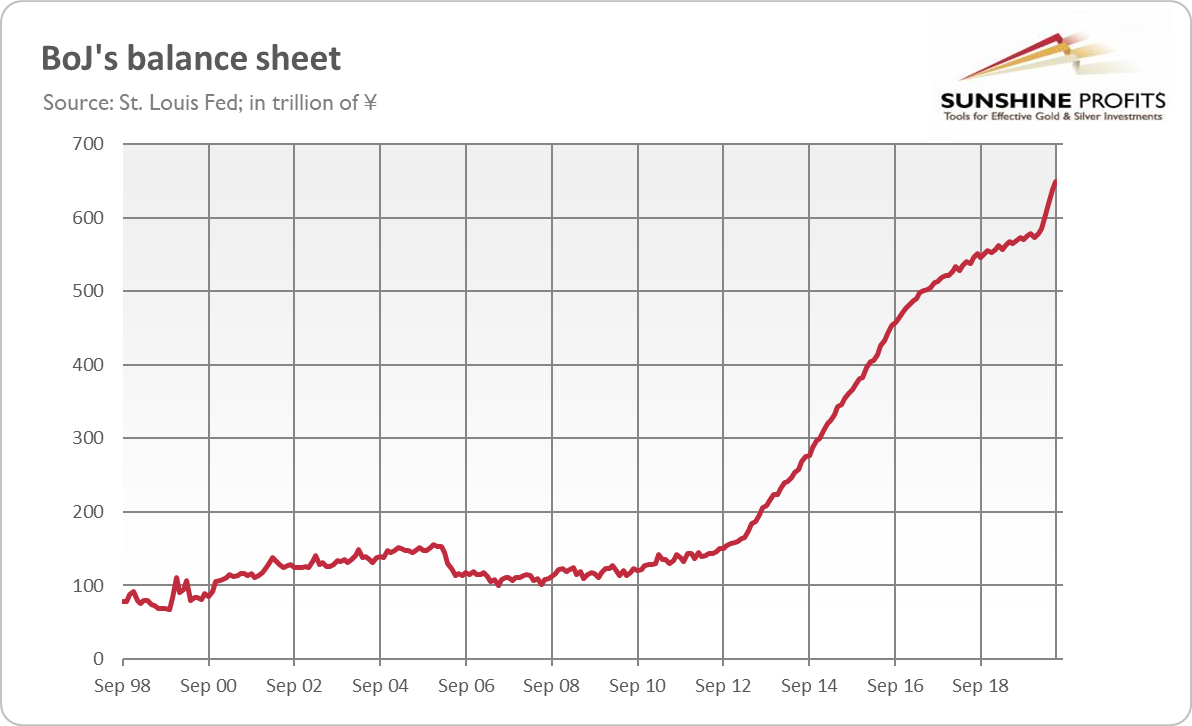
And in March 2020, in response to Covid-19 pandemic and the following economic crisis, the Australia's central bank started capping yields on 3-year government bonds at 0.25 percent, which triggered expectations that the Fed could follow suit.
What would the yield curve target imply for the monetary policy, economy and the gold market? Well, it's not rocket science - capping bond yields means that bond yields will remain very low for longer that they would be without the caps. Importantly - oh, what a coincidence! - the Fed would cap Treasury yields, which would allow the government to continue its spending spree and to not worry about the fiscal deficits and soaring public debt.
Another issue is that the yield curve control flattens the yield curve, which hurts the commercial banks, which usually borrow short-term funds and lend long-term. So, a flat yield curve narrows their margins, impairing their lending ability, which is key to revive the economy.
Last but not least, the yield curve control can become very easily (if it's not already) a blunt tool to help government issue debt smoothly and cheaply. As the FOMC admitted itself in minutes of its recent meeting, "monetary policy goals might come in conflict with public debt management goals, which could pose risks to the independence of the central bank."
It should be clear now that the yield curve control should be positive for the gold prices, even if it would reduce the pace of the Fed's balance sheet expansion (as in the case of the BoJ's experience). After all, the caps on the Treasury yields imply low interest rates. Importantly, if inflation rises the cap on nominal interest rates would lead to the decline in the real interest rates, as it happened in the aftermath of the World War II. The yield curve control also caps the government's borrowing costs, which encourage the increase in public debt, which raises the risk of the sovereign-debt crisis. Moreover, the yield curve control could spur some worries about the central bank's independence, which could weaken the U.S. dollar. In such a macroeconomic environment, gold should shine. So, the Fed could cap the Treasury yields, while pushing gold upwards.
Thank you for reading today's free analysis. If you enjoyed it, and would you like to know more about the links between the economic outlook, the current (past?) crisis and the gold market, we invite you to read the August Gold Market Overview report. Please note that in addition to the above-mentioned free fundamental gold reports, and we provide premium daily Gold & Silver Trading Alerts with clear buy and sell signals. We provide these premium analyses also on a weekly basis in the form of Gold Investment Updates. In order to enjoy our gold analyses in their full scope, we invite you to subscribe today. If you're not ready to subscribe yet though and are not on our gold mailing list yet, we urge you to sign up. It's free and if you don't like it, you can easily unsubscribe. Sign up today!
Arkadiusz Sieron, PhD
Sunshine Profits: Analysis. Care. Profits.-----
Disclaimer: Please note that the aim of the above analysis is to discuss the likely long-term impact of the featured phenomenon on the price of gold and this analysis does not indicate (nor does it aim to do so) whether gold is likely to move higher or lower in the short- or medium term. In order to determine the latter, many additional factors need to be considered (i.e. sentiment, chart patterns, cycles, indicators, ratios, self-similar patterns and more) and we are taking them into account (and discussing the short- and medium-term outlook) in our Gold & Silver Trading Alerts.
-
Five Post-Covid Trends and Gold
August 14, 2020, 5:35 AMThe disruptions caused by the pandemic of Covid-19 forced people, companies, governments, and organizations to challenge their basis assumptions about their ways of life and conduct. Some of them might be trivial such as more frequent and thorough hand-washing, but others are much more important, amongst them putting more emphasis on health that came suddenly under threat and social relationships that were so missing during the quarantine. So, the key question is when the epidemic is fully contained, what will be the "new normal" - and how it will affect the gold market?
The first characteristic feature of the post-pandemic world will be more people working and getting things done from home. The digital transformation has already started before the coronavirus jumped on human beings, but the Covid-19 epidemic has accelerated its pace, with further expansion in videoconferencing, online teaching, e-commerce, telemedicine, and fintech. After all these long years, it turned out that all these boring meetings really could have been e-mails or chats via Zoom, Skype or Teams. What does it mean for the economy and society? Well, working from home implies more flexibility and less commuting for the employees. So, they can work from any location and spend more time with their families. Improved work-life balance translates into happier workers, which can make them more productive. And the most important thing: people can work in sweatpants or pyjamas all day, hurray! There are also benefits for the companies - just think about all the cost savings from less space needed and less business travels! Hence, although working from home has also some negatives (possible miscommunication, loneliness, and difficulties with unplugging after work, decreased knowledge flows and managerial oversight), it should increase productivity in the long-run, especially if not overdone. Improved productivity thanks to telework is positive for the corporate margins and equities, but it is bad news for the gold prices.
Second important trend is deglobalization. The pandemic showed that just-in-time supply chains relying on foreign suppliers are not resilient in times of global crises and border closures. So, many Western companies will re-shore some of their production, or reallocate it closer to their major markets in ways that favor national and regional supply chains. The growth of nationalism will counteract the first change and hamper the productivity growth, which is positive for the yellow metal. However, making the supply chains and manufacturing more resilient diminishes the long run threats to the economies and the risk of economic collapse, which could reduce the safe-haven demand for gold.
Third, the pandemic will affect the geopolitics. For example, it can aggravate the fragile trade relations between China and the United States. Moreover, the epidemic and the following economic crisis make more and more people question the liberal internationalism and America's leadership role. On the contrary, China's geopolitical role could increase in the aftermath of the pandemic. The rising geopolitical tensions and protectionism, as well as diminished confidence in the U.S. global leadership and the greenback could increase the appeal of gold.
Fourth, could be a shift toward lower population density and less crowded places. It may lead to a complete rethinking or redesigning of living in big cities - or a move from metropolises to smaller cities, towns or even to the villages. After all, when people need only Wi-Fi to work or educate, they don't have to live in big cities anymore. The consequences are not clear, but it's possible that the real estate prices in the biggest cities could correct somewhat, as people and companies could cut costs and move away from high-priced, centrally located areas (however, there might be higher demand for larger houses with offices for telework). If we really see such a correction, the repercussions may be significant, also for the gold market, as the burst of the 2000s' housing bubble demonstrated. As the chart below shows, the S&P/Case-Shiller U.S. National Home Price Index is now much higher than in 2007, before the global financial crisis started.
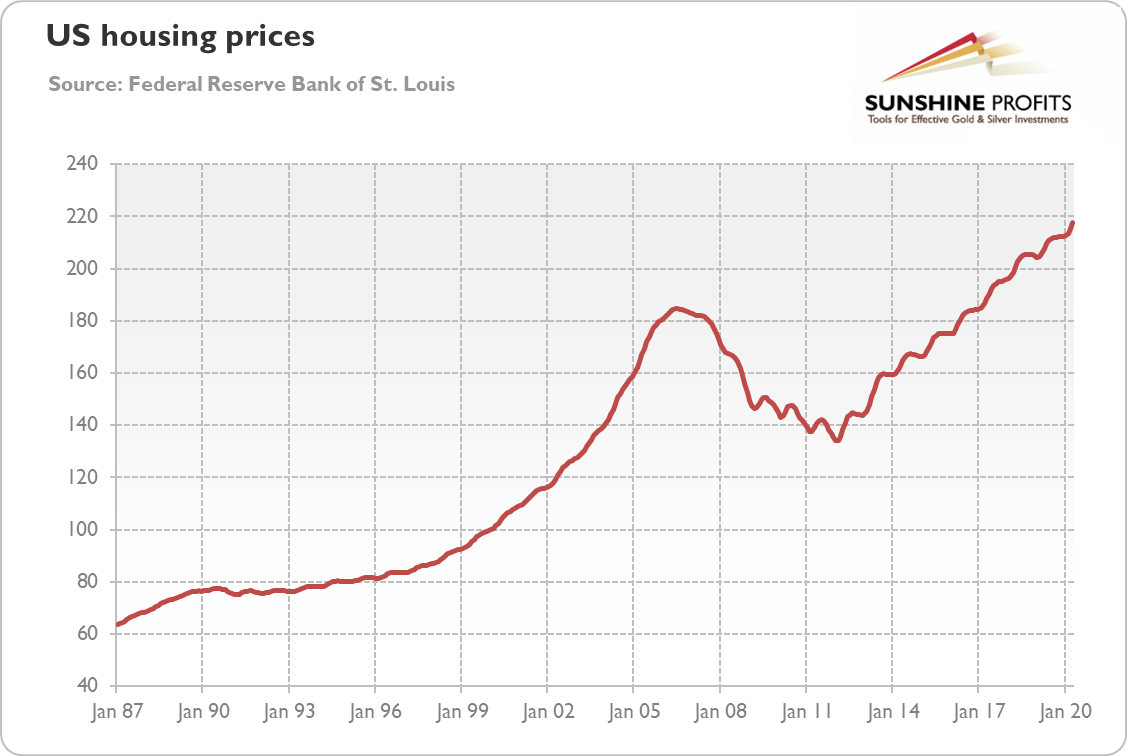
Last but not least, the role of governments will increase in the post-pandemic world after generously supporting companies and households during the crisis. Compared to the Great Recession, when both the Fed and the Treasury acted more gradually and with some fear of public anger, their recent actions were unprecedentedly swift and aggressive. Hence, the public debt will balloon all around the world, creating significant challenges, increasing the risk of sovereign-debt crisis and putting more downward pressure on the central banks to maintain the dovish monetary policy with ultra-low interest rates. This important macroeconomic trend should be positive for gold.
Thank you for reading today's free analysis. If you enjoyed it, and would you like to know more about the links between the economic outlook, the current (past?) crisis and the gold market, we invite you to read the August Gold Market Overview report. Please note that in addition to the above-mentioned free fundamental gold reports, and we provide premium daily Gold & Silver Trading Alerts with clear buy and sell signals. We provide these premium analyses also on a weekly basis in the form of Gold Investment Updates. In order to enjoy our gold analyses in their full scope, we invite you to subscribe today. If you're not ready to subscribe yet though and are not on our gold mailing list yet, we urge you to sign up. It's free and if you don't like it, you can easily unsubscribe. Sign up today!
Arkadiusz Sieron, PhD
Sunshine Profits: Analysis. Care. Profits.-----
Disclaimer: Please note that the aim of the above analysis is to discuss the likely long-term impact of the featured phenomenon on the price of gold and this analysis does not indicate (nor does it aim to do so) whether gold is likely to move higher or lower in the short- or medium term. In order to determine the latter, many additional factors need to be considered (i.e. sentiment, chart patterns, cycles, indicators, ratios, self-similar patterns and more) and we are taking them into account (and discussing the short- and medium-term outlook) in our Gold & Silver Trading Alerts.
-
How Does the Yellow Metal Fit the Corona World?
August 7, 2020, 6:46 AMFor a long time, pundits talked excitedly about the rapid, V-shaped recovery. I never shared this view, finding it too optimistic and without basis in reality. Like Jeff Goldblum in Jurassic Park, I hate being right all the time, but it really seems that I was right about this issue. According to the July World Flash report by IHS Markit, we can read that "the new wave of infections has reduced the probability of a V-shaped cycle (...) and increased the risk of a double-dip recession (W-shaped cycle)."
The problem is the rising number of Covid-19 infections in large economies such as Brazil, India, or the United States, as the chart below shows (there is also the resurgence in cases in other countries, such as Australia or Japan, although the absolute numbers of infections are smaller).
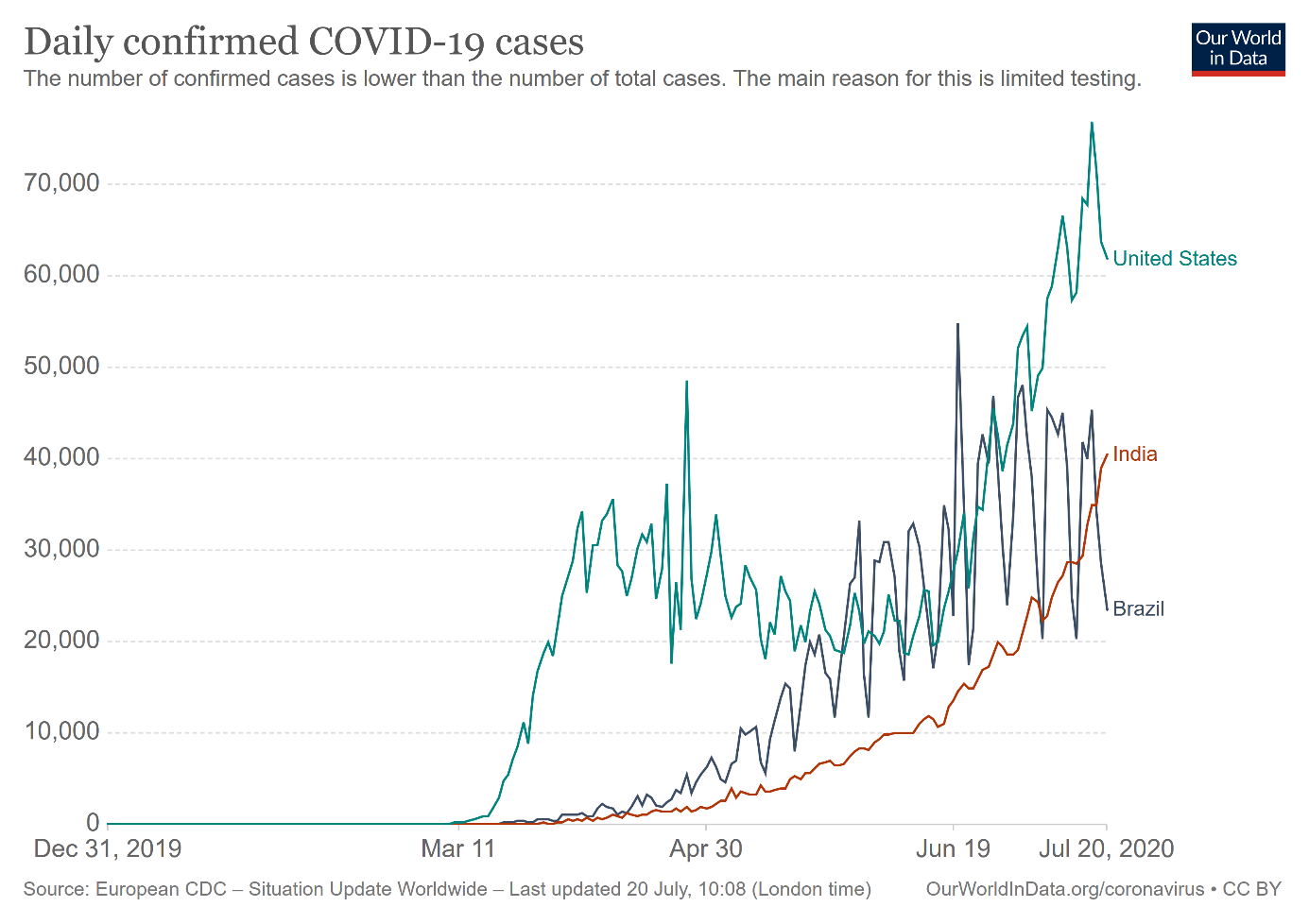
In particular, the second wave of infections in America is especially disturbing, as the U.S. economy accounts for about a quarter of world's GDP. Given that when the U.S. sneezes, the world catches a cold, just think what could happen when it suffers from Covid-19! You see, American consumers remain cautious and reduce their social activity and spending. The states are also reimposing social distancing measures and sanitary restrictions which will additionally hamper the pace of economic recovery in the short-term.
Last but not least, the uncertain epidemiological and economic situation put many firms in a survival mode. Without confidence in future profitability, companies reduced radically their investment spending. Importantly, business owners remain cautious not only in the U.S. where the number of infections is rising, but also in China, where the epidemic is more less contained, which suggests that the pandemic will leave lasting scars on the American economy, even if the second wave goes away.
And it goes away for sure. As companies test their workers and states finally mandated the wearing of masks and extended or reintroduced social distancing measures, the trend in the number of daily new infections of coronavirus may change within weeks. So, without the new Great Lockdown and with better social distancing measures and overall preparation to handle the epidemic, the second dip in the possible W-shaped recession would not be anywhere near as severe as the first crash. In other words, the worst is probably behind us, at least unless a financial crisis breaks out.
What does it all mean for the gold market? Well, the fragile, W-shaped recovery is, of course, a better scenario for gold than a quick, V-shaped recovery. It means slower economic growth and longer recession, which would force central banks and governments to expand and extend their dovish stance and to provide the economy with additional rounds of stimulus. Music to gold's ears!
Sure, the worst is probably behind us. The improved virus management measures mean that we can contain the second wave of infection without the necessity of introducing the widespread lockdowns. And the health systems expand testing, while encouraging news on the drugs and vaccines will probably keep pouring in, maintaining - together with the massive liquidity provided eagerly by the Fed - the optimism in the financial markets. It could support the risky assets, putting a downward pressure on safe havens such as gold.
However, the yellow metal may shine even if the second wave is quickly contained while the second leg of recession is much shorter. After all, although the economy might have already bottomed out, it will not return to the pre-epidemic level until 2022. Hence, forget about the V-shaped rebound - the economic recovery could look more like W or like the Nike's swoosh (after an initial vivid rebound due to the low base, the recovery will be slow over the next few quarters). In any case, it could be rather a long and bumpy road with several downside risks. In particular, when firms exhaust their cash buffers, bankruptcies will become more common. It will be a big test for the financial sector.
Although banks seem to be well-prepared, it might turn out to be an illusion when the black swan lands. It is worth remembering that the crisis will substantially increase the volume of banks' non-performing loans, and that not all banks will cope with the digitalization of the sector and with the competition from the fintech. Moreover, the true impact of the pandemic will not be seen until all the economic stimuli end. So far, everything seems to be under control, but all this liquidity pumped to the financial system by the Fed and Treasury, could cover cracks in the financial system. If they are revealed, gold may get additional boost. However, even without the next crisis, the yellow metal should thrive in the current macroeconomic environment of dovish central banks, low real interest rates, high public debts, and uncertain economic outlook.
Gold Market
Free Newsletter
with details not available
to 99% investors
+ 7 days of Gold Alerts
Gold Alerts
More-
Status
New 2024 Lows in Miners, New Highs in The USD Index
January 17, 2024, 12:19 PM -
Status
Soaring USD is SO Unsurprising – And SO Full of Implications
January 16, 2024, 8:40 AM -
Status
Rare Opportunity in Rare Earth Minerals?
January 15, 2024, 2:06 PM

